
 Every year for the past decade I've been sending in bunched of old photos to be scanned. I finished with my own photos after a couple years. My mom's photos took an additional four years. After that, I've been going through my grandmother's extensive photo collection, which will keep me paying for photo scanning services for years to come.
Every year for the past decade I've been sending in bunched of old photos to be scanned. I finished with my own photos after a couple years. My mom's photos took an additional four years. After that, I've been going through my grandmother's extensive photo collection, which will keep me paying for photo scanning services for years to come.
It's a lot of money.
But it's well worth it.
Mostly because there's hundreds of gorgeous shots of my mother when she was little that are more artistic than anything you'll find in any museum...
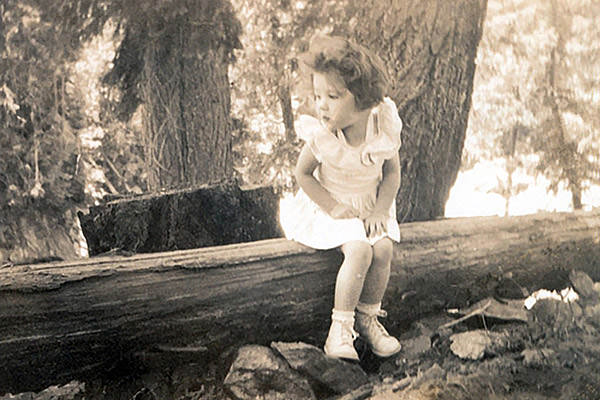
And by "artistic" I should say "accidentally artistic" since they were never intended to be art... they were just everyday snapshots that happened to turn out incredible.
Not everything is accidental art though.
Like this photo of me with my hand down my pants...
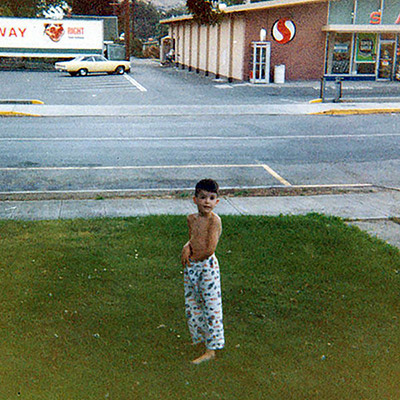
Some things never change.
 Yesterday I talked about my photos and how the death of Apple's Aperture has forced me to move to Adobe's Lightroom. This entry talks about how that all went down.
Yesterday I talked about my photos and how the death of Apple's Aperture has forced me to move to Adobe's Lightroom. This entry talks about how that all went down.
Since the Aperture import plugin didn't work and I was starting from scratch, there really was only four decisions to be made in building my Lightroom catalog and new photo library...
To DNG or not to DNG?
When you shoot RAW, odds are your camera is saving the "digital negative" in a proprietary format. My Nikon D90, for example, saves them as .NEF files, which is proprietary to Nikon. My Sony A7, for another example, saves them as .ARW, which is Sony's version of RAW. I shot on a Canon for a while, and they use .CR2 for their RAW format. I also have .RW2 files from a Panasonic underwater camera I used and .ORF from an Olympus that I borrowed. What a mess. Unlike JPEG which is standardized, RAW formats rarely are. Which is why Adobe created the .DNG format. But, unlike what's used by camera companies, it's not proprietary... it's open, and anybody anywhere can read the specs that Adobe provides for free. This does two very important things...
There are other advantages to .DNG as well... my favorite being that it doesn't use external EXIF sidecar files, but instead stores the information internally. The fact that the files are also validated by an internal checksum means that you can tell when bits of a file go missing or are corrupted. The list goes on and on (did I mention that .DNG files are also smaller?).
So, ultimately, I totally embraced .DNG and had all my RAW image files converted upon import. Yes, this adds significant time to your import, but the benefits are worth it.
Alas yon Preview, What Size Art Thou?
When my 8TB external hard drive is connected to my laptop, all my photos are available to me at full resolution. When it's disconnected and I'm half-a-world-away, however, my photos are not available, and all I have to look at is whatever preview Lightroom has available in the catalog of my local drive. Lightroom's "Standard Size" preview is 1024 pixels along the image's longest side. That's fairly decent for looking through your images and won't take up too much space. Except Lightroom stupidly doesn't default to "Standard" but instead renders "Minimal" previews which are pretty much worthless (so be sure to switch to "Standard" in the Catalog Preferences or else you'll have to re-render all new previews!). You also have the option for 1:1 previews, which will speed up your workflow and look great on-screen... assuming you have room on your hard drive. As for me? I compromised. I changed the "Standard" size preference from 1024 to 2048 pixels and left the quality on "Medium." That's double the size of what you usually get, but generally ends up smaller than 1:1. My reason for taking the hit to my hard drive is twofold... 1) I have a Retina Display, and larger images display better... and, 2) If my library drive AND both backups are lost for some reason, I can probably live with 2048 as my only image size, but would be devastated if all I had were 1024 images. In the end, it's up to you... but with display resolution climbing and hard drive sizes escalating, it seems as though the bigger you go the better off you'll be.
If Thee Be Smart, Where Be Your Brains?
A couple versions ago, Adobe came up with "Smart Previews" which opened the door to all kinds of cool things. Primary of which is that you can EDIT images with Smart Previews... even if you're not connected to your library (usually, you can't do this). Once your library gets connected, the edits will be written to the original photo file's dataset, and it's just as if you had changed the original all along. As if that weren't enough, Smart Previews can also be viewed and worked on with an iPad via Creative Cloud. Pretty cool stuff, right? Except... "Smart" Previews are not exactly "smart" in that you are still required to have "regular" previews as well. So, effectively, you've got an entire catalog of previews taking up valuable hard drive space... twice? Or at least that's how I understand it to work. I don't have that kind of space available on my laptop's SSD, so I skipped stupid "Smart Previews." Hopefully one day they'll make it so you are only required to have ONE preview per image. Until then, it's nice to know that I can build Smart Previews for those times I plan on editing photos on the go.
But Soft! In What Organization Through Yonder Library Breaks?
With Aperture I never had to worry about the physical organization of all my image files. I created projects and folders within the app and let Aperture worry about where the files went. With Lightroom this is not possible. So what I ended up doing was mimicking the structure I was used to... a folder for each year and a sub-folder for every event/trip/session that was preceded by a date. If you take a lot of photos, it's a pretty good idea. The drawback being that if you've visited Milwaukee twenty times and want that photo you took of the Milwaukee Art Museum, you have to know when you visited in order to track down the photo. If that's a concern for you, might be better to not organize by date... but to instead organize by subject. Regardless of how you choose to organize your images, it's critical to keep organizing the same way. Once you get tired of the effort and just start dumping your photos wherever, you never be able to find them unless you spend a lot of effort applying keywords to each image. That takes considerably more time than organizing from the get-go... though, if your import groups are small enough, you might be able to apply keywords when you import to save time. Still, given Lightroom's inability to manage your photo files, you really need to come up with something yourself and stick with it.
Now that I've made my decisions... we're ready to import.
Getting your photos into your local Lightroom catalog and writing out your .DNG files to your external library is pretty easy. You click the "import" button, choose what you want to import... choose where you want them to go... add your settings for previews, keywords, and such, and away you go.
Since I was converting to .DNG and rendering rather large previews, my later years took a very long time. Five hours or more. And the bad news is that there's no way to pause the import and resume it at a later time... at least not that I've found. Yes, you can cancel and then re-do the import (Lightroom will run through everything again and skip the images it's already worked on) but this is a far from ideal solution. Even worse, absolutely no estimate on how long the import will take is given. You get a progress bar and that's all. Thankfully, you'll (hopefully) only have to do massive library imports once in your life, but it would sure be nice if Adobe were to allow you to pause the process. My suggestion? Break your imports down into more manageable chunks. You can uncheck folders you've already imported to keep Lightroom from doubling up (though, inexplicably, Lightroom will still go through all your photos if you have "Don't Import Duplicates" selected... whether you've checked or unchecked the folder in question).
It took me five days to get everything cataloged/imported. Usually I would import a chunk before going to bed and find everything completed when I woke up.
So how am I liking it now that I'm a Lightroom guy?
To be honest, I'm not liking it at all.
Lightroom is a massively confusing program that makes practically no sense. Compared to the elegance and ease of Aperture, I'd go so far as to say that Lightroom is crap. I hate just about everything about it. The interface is a complete mess and takes up way too much of the screen. Even simple things are difficult. Want to zoom in on a photo? I still don't understand how it works. Click once you zoom. Click again and you don't zoom in further, you zoom back out to some totally random percentage? Crazy. Instead of an intuitive, fluid zoom tool that operates like every other zoom tool in every other program (including Adobe Photoshop!), with Lightroom you have to click on a drop-down menu and choose 1:4, 1:2, 1:1, 2:1, 4:1, etc. etc. in order to get closer to/further from an image. It's about the stupidest fucking thing I've ever seen. I'm trying to use gestures on my trackpad for zooming, but it's so clunky and spastic that I can never end up where I want to be. And that pretty much defines everything you do in this program... clunky and spastic. There are times I make adjustments to an image... increase the saturation or sharpening or whatever... and nothing happens, even though the sliders are showing I've made the adjustment. WTF? It's enough to drive me insane. There are times I have to step away from the program because I'm getting so frustrated and angry that it feels as if my head is going to explode.
I'm hoping that eventually I'll get used to the shitty way Lightroom works, but I sincerely doubt it. The program is a hot mess of epic proportions, and I simply don't understand how anybody manages to get anything done with it. Yes, it's usable and I can (eventually) figure out how to do what I need to do... but it has a long, long way to go before it's as beautifully intuitive as Aperture is. Was. Whatever.
But, thanks to Apple being complete assholes and canceling one of the most wonderful apps for organizing and working on photos ever made, this is where I'm forced to be.
Maybe there's a better solution out there... maybe I should take a second look at Capture One... but the thought of having to go through all this mess again makes me want to stick my head in an oven.
I'm probably better off not using a photo cataloging program at all. I'll just go back to files and folders on ZIP drives and call it a day.
So much for progress.
UPDATE: More problems popping up every day. The worst of which is that Lightroom crashes... a lot.

Yeah. Definitely don't understand how people are using this thing.
 This is the first post in a two-part entry that will be discussing digital photo storage. Not a topic that most people will be interested in, but I very much want to document my process just in case somebody else out there on the interwebs is in the same boat as I am.
This is the first post in a two-part entry that will be discussing digital photo storage. Not a topic that most people will be interested in, but I very much want to document my process just in case somebody else out there on the interwebs is in the same boat as I am.
But, before we begin, a disclaimer.
I am a huge, huge, massively huge Apple Aperture fan. When it comes to working on photos, it's lagged behind Adobe Lightroom for years... but, when it comes to cataloging photos, it's pretty much the cat's meow. And since it's the cataloging that's of primary importance to me and my tens of thousands of photos, that's where my heart has been since Aperture debuted back in 2005. I will never, ever forgive Apple for canceling the app, and consider it just one of several stupid moves for the company as of late. But anyway...
Apple did cancel Aperture, so I am forced to migrate elsewhere.
My choice ended up being Adobe Lightroom. I am still not convinced it was the best choice, but I do think it's the right choice... for me anyway. Yes, I preferred the way photos looked using the RAW import on Capture One Pro better than Lightroom... and there were features in Darktable (among others) that were appealing... but it just seemed easier all the way around to go with Adobe since I know they're not going anywhere. The last thing I want to do is to have to go through this crap all over again if another app closes up shop. On top of that, the tight integration with the Adobe apps I use every day (Photoshop and Illustrator in particular) is too alluring to ignore. As if that weren't enough, I get Lightroom as a part of my Adobe Creative Suite subscription at no extra charge. Sure I could wait and see what Apple's replacement app, Photos is all about, but it looks unlikely to include the professional features I need.
So here I am.
And now a little background so you know who that is...
I have been into photography for as long as I can remember, and I've loved it all that time. So when it came time for a high school graduation gift in the mid-80's, all I wanted was a professional camera. My parents got me a Canon A-1, which was the most advanced camera of its day. The "Killer Feature" being the first SLR camera to have a digital autoexposure controller. Something I took advantage of frequently as I was learning how to properly use shutter and aperture settings. The A-1 was both a joy and a revelation over the fifteen years I used it as my primary camera, and I shot as much film as I could afford to have developed.
Then in the mid-90's the digital age was upon us. I was an early adopter, buying an Apple QuickTake 1 the day it was released in 1994. By modern standards, it was a pretty shitty camera. 640x480 pixels max and, unless you had flawless lighting, the images were pretty terrible. But... it was new. And it was cool. And I kept investing in digital technology despite not taking it very seriously. Why should I when what I was getting from my film camera was so much better?
Then the year 2000 came along and I got a Sony Cyber-Shot DSC-D700.
Suddenly, my digital photos were getting close to what I was getting on film, all without the pain (and expense) of developing the images. All summer long I went back and forth, testing and re-testing, contrasting and comparing. I was lugging around two cameras everywhere, not fully trusting the Sony after over a decade with my trusty Canon. But then the moment of truth arrived... in October I took a trip to Asia and the only camera I brought was my DSC-D700. The results were so encouraging I went ahead and did the same for a trip to Rome that December. By 2001, I was 99% digital, only dusting off my film camera when I had a project that required it.
Cataloging my photos in 2001 was a pretty simple affair. I stored all my photos on a Zip Drive, making two copies each on separate cartridges, one of which was kept in a bank safe. As image size kept climbing, I would eventually switch to Jaz Drive cartridges. Every project had a separate folder, which got a bit complicated after a while, so I then started creating Master Folders titled by year to sort them into. It worked just fine, and I didn't even think about the need for cataloging software until that infamous day in 2005 when I purchased Apple's Aperture.
And it was glorious. Especially during those heady early years when Apple was updating the thing. They added "Places" so you could tag all your photos with a location (if they didn't have one already). They added "Faces" so you could automate tagging the people appearing in your photos. And then there were the Vaults... dead-simple ways of backing up your catalogs and precious photo information which was quickly becoming every bit as important as the photos themselves. Everything in Aperture was so convenient, easy, and powerful. I quickly organized all my photos into Projects by year and Folders by project, since that mimicked the file structure I had been using for five years. Apple's amazing app made dealing with my huge library of images almost effortless.
Until they decided they didn't want to any more.
Enter Lightroom.
At first I thought the migration would be a piece of cake, because the Aperture import plugin I had been waiting for was finally released. It was a huge relief to know that all the hours/days/months of inputting photo data into Aperture wouldn't be lost. Except I could never get the plugin to work. It would hang after a while no matter what I did.
And so I gave up and decided I would just start over completely from scratch. The first step was to extract all my images from the Aperture catalog and convert them to "managed" files so I could access the individual, original photo files, which subsequently transferred to a spare 1TB drive I had laying around.
I then purchased a new 8TB Thunderbolt RAID unit from Western Digital which would give me 4TB of mirrored storage to work with. The old Aperture RAID drives were removed and popped into my bank safety deposit box just in case I ever need them.
And then the horrendous chore of importing all my images into Lightroom began.
The first years were easy. In the year 2000 I had a measly 250 photos, and they were all JPEG files that were either 2048×1360 or a tiny 1600×1200 pixels in size. NOTE TO YOUNGER SELF: Always shoot at the maximum resolution of your camera. I know that 1600×1200 seemed like a huge amount of pixels back in the day, but in the future that will be insanely inadequate for just about every purpose.
As we move forward in time, the number of photos increases considerably from year to year (especially when I decided to start bracketing most of my shots). And, because the size of the photos keeps going up as well (especially when I started shooting RAW), the storage space needed (hence the amount of time to import them into Lightroom) increases exponentially. NOTE TO YOUNGER SELF: Always shoot RAW. I know they're a lot bigger files, but if you could experience the pain of having to look back at your trip to the pyramids of Egypt with all that JPEG artifacting, you'd know the extra size is well worth it. And it's no small amount. In 2007 I shot one trip RAW. In 2008 I shot half of them RAW. In 2010 I was shooting all RAW all the time. Just look at what happens...
Now, to be honest, most of the photos I took in later years are not keepers. As memory cards kept getting bigger and cheaper, I was a lot less selective in what I shot... and I would shoot the same thing several times so I could pick the best image and delete the rest... except I never seem to delete anything. Perhaps one day I'll have the time to purge all the bad/redundant shots, but it ain't happening any time soon. Good thing hard drive space is getting so cheap!
Okay then. Now you know about me and what I shoot... I guess it's time to start importing everything into Lightroom!
Which I will be talking about in tomorrow's entry.
 Yeah, yeah, it's Friday and I'm two days early... but I can't mess up my end-of-year lists, so... Bullet Sunday starts now...
Yeah, yeah, it's Friday and I'm two days early... but I can't mess up my end-of-year lists, so... Bullet Sunday starts now...
• Box! Ooh... look... it's the day after Christmas!

Assuming you celebrate that kind of thing.
• Monkeymedic! When a monkey was badly shocked by an electrical line, a monkey friend did their best to revive him...
Monkey buddies for life!
• Land! One of the gifts from Cards Against Humanity's Ten Days or Whatever of Kwanzaa ended up being one square foot of an island in Maine that they renamed Hawaii 2. My piece is here...
Looks like I'm going to have to see if there's a way to get there for my next trip to Maine!
• Cute! There's an article titled 25 of The Cutest Parenting Moments In The Animal Kingdom that's totally worth a look. Though I'd say a photo I took when I was at Mana Pools in Africa of two elephants teaching a baby elephant how to wash grass is just as cute as any of them...

And a photo I took of a mother lion giving her reluctant cub a bath when I was at Hwange National Park is equally sweet...
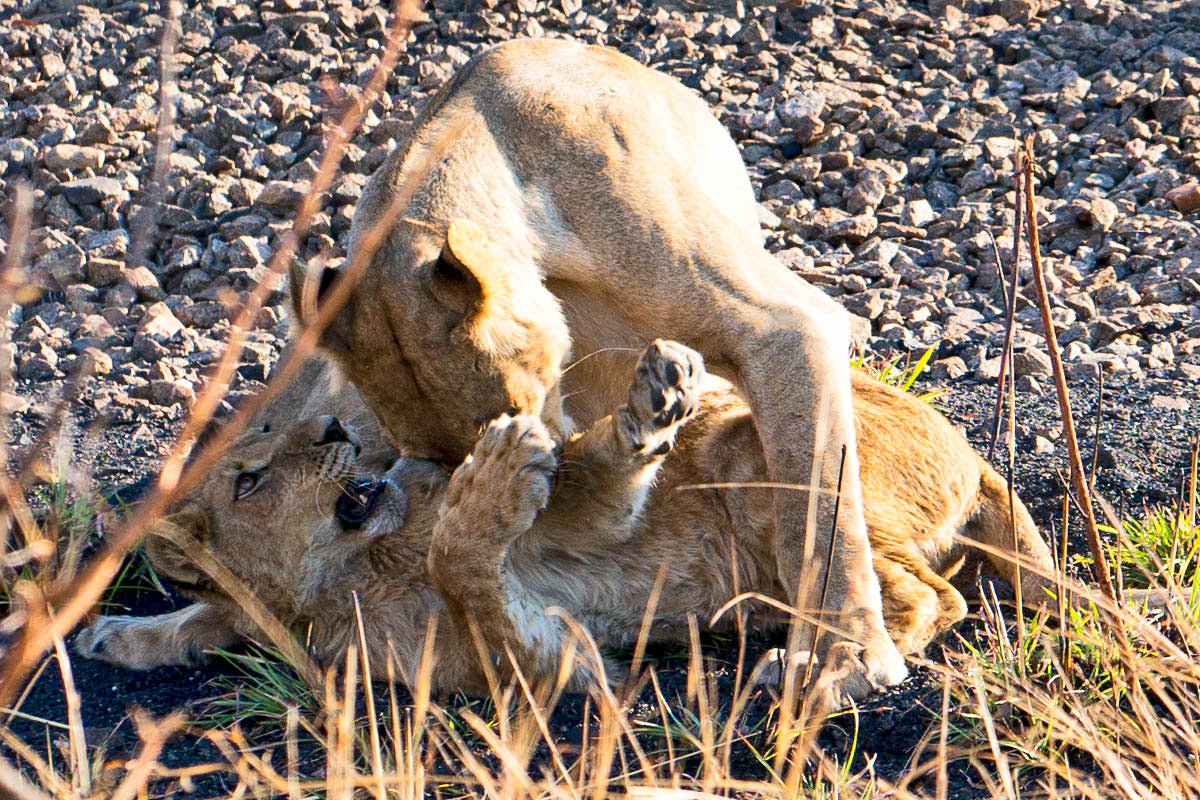
Doesn't get much more adorable than nature.
• Horrifying! And now for something that's the exact opposite of cute. I was playing Godus (quite a trick when the pile of crap crashes all the time) when a rival tribe, the Astari, started having a celebration. If the celebration makes their people happier than my people, some of my people will defect. I didn't want this to happen, so I used my god powers to call down a meteor strike. I was hoping if I busted some of their buildings they wouldn't be quite so happy. Unexpectedly, all hell broke loose. Before I knew it, all the buildings... and all the little people... were on fire...
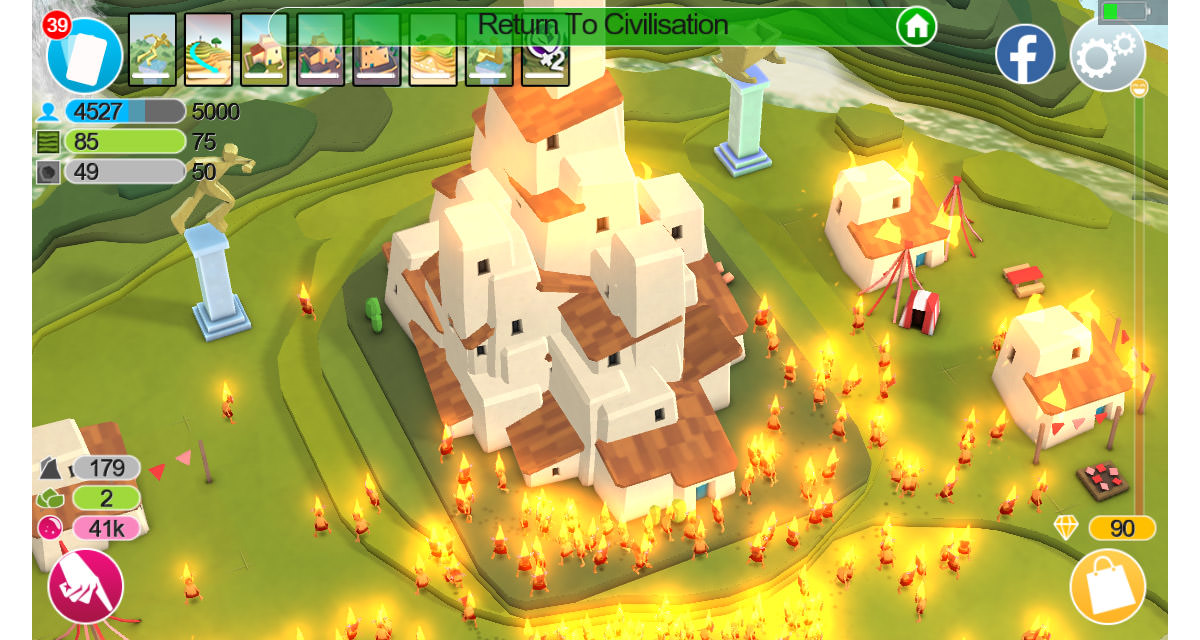
The whole scene was just awful, and I felt terrible all day for the horrific destruction I unleashed. I was going to call down some rain to extinguish everything, but the population plummeted to zero and the entire tribe was gone. Guess this is what happens when people try to play god.
• Quest! I'm a bit obsessed with Questlove, best known as co-founder and lead drummer for The Roots (the house band on The Tonight Show with Jimmy Fallon). He absolutely mesmerizes me with his musical talent... especially when he sits in on drums with a guest band at the last minute (always flawlessly). He can play drums on A.N.Y.T.H.I.N.G. Despite being a fan, I never knew he had a memoir out until last week when I discovered... quite by accident... the book "Mo' Meta Blues." It is fantastic. The guy is even more brilliant than I imagined. Highly recommend checking it out...
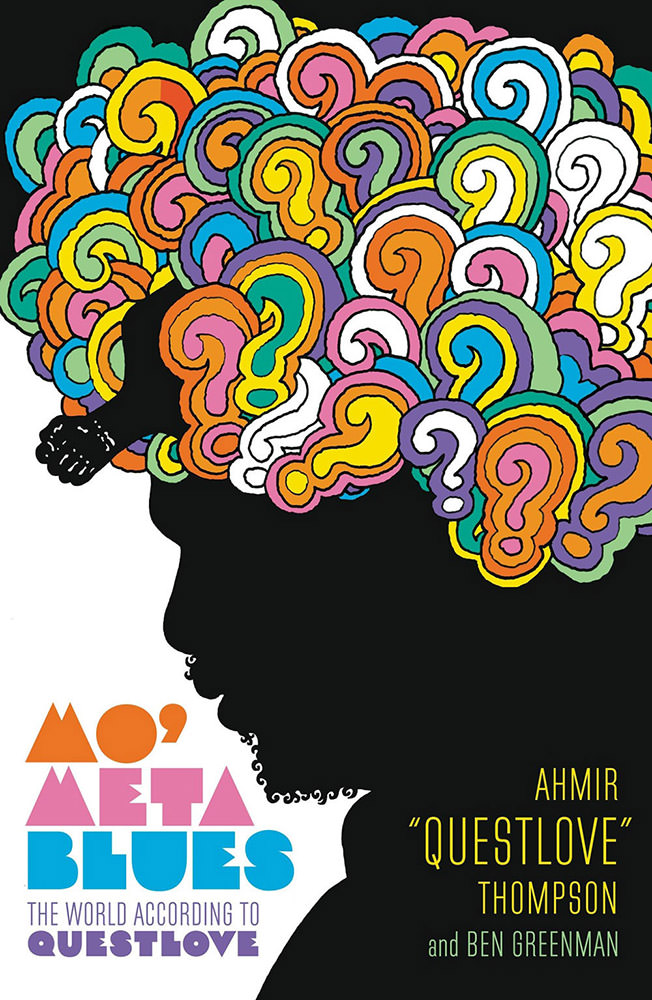
If you need convincing, here's a terrific excerpt over at Salon.
• ASSHOLERY! One of my favorite internet services is DropBox. It's a storage space in the cloud that allows me to share files and keep my work handy no matter where I am or which computer I'm using. I've been paying for DropBox space for years, and have come to rely on its ease and convenience. At least I did until the last update when the fucking assholes moved the buttons to open the DropBox folder and open the DropBox website... replacing them with a "Pro" button...
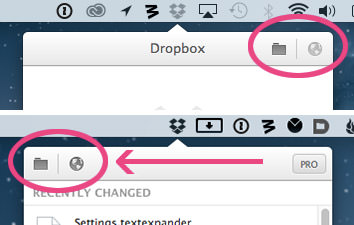
And since I am so accustomed to where the buttons used to be, I'm forever accidentally clicking on that stupid-ass "Pro" button, opening up their idiotic "PAY US MORE FUCKING MONEY" website which I DON'T WANT. And I am absolutely livid. First DropBox trains everybody where to click to get what they need... then they trick you into clicking on an ad? terrific way to treat your customers.
UPDATE: I do have a "Pro" account that doesn't expire until April 2015 and has PLENTY of space available. So I have no idea why I am being told I have to go Pro Pro?
And... that's the last Bullet Sunday of 2014!
 The Plan was to fly out today since my work ended yesterday so I could have more time on my upcoming Hard Rock adventure. But to follow The Plan would cost four times the money than a hotel stay, so I'm instead flying out tomorrow morning. Early.
The Plan was to fly out today since my work ended yesterday so I could have more time on my upcoming Hard Rock adventure. But to follow The Plan would cost four times the money than a hotel stay, so I'm instead flying out tomorrow morning. Early.
The rest of this entry should be prefaced with the understanding that cold Maine is cold. Very cold. Biting cold. Cold with a side of cold and a scoop of cold on top.
It's really f'in cold.
And it's Sunday in the off-season, so there's not much to do in Portland, Maine. Thus my incentive to go outside is not very high. So I didn't until the hotel kicked me out at noon. At which time I checked into my airport hotel, returned my rental car, then took a taxi back into the city because pizza and apple crumble was calling at Flatbread Company...
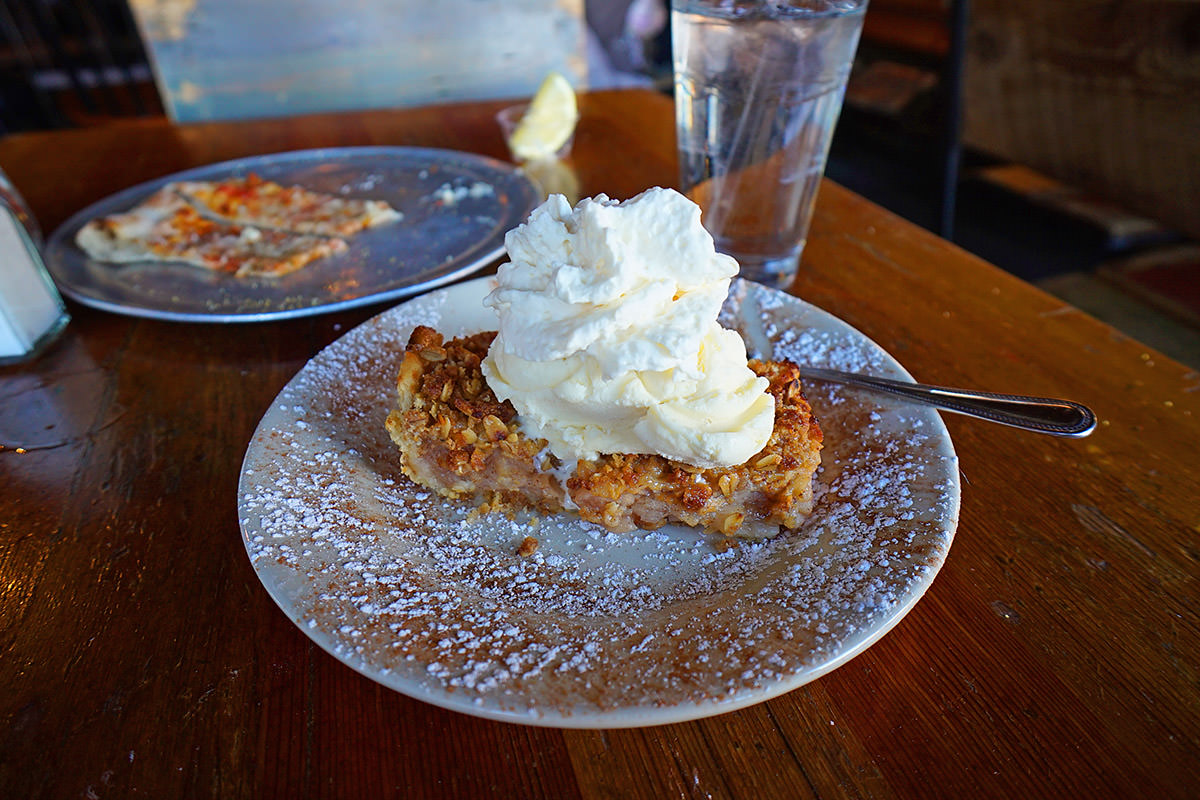
To say I love this restaurant is a gross understatement. The location is great. The atmosphere is great. The service is great. The beer selection is great. The food? Beyond great. Especially the desserts, which are worth a trip to Portland all by themselves.
Did I mention it's cold?
Yet I went wandering downtown anyway like the fool I am. Despite wearing a T-shirt, thermal henley, hoodie sweatshirt, and a coat, I was still freezing. But I wanted to get a shot of the fence with locks on it in daylight, so off I went...
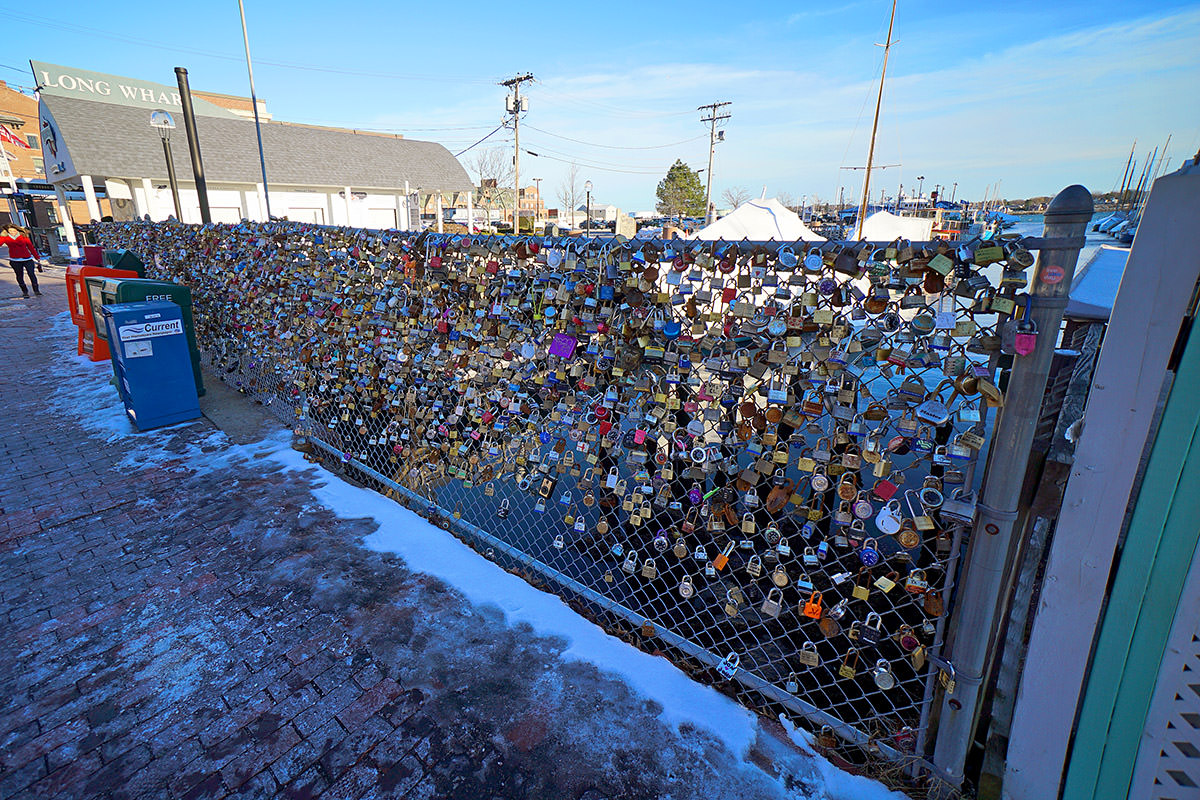
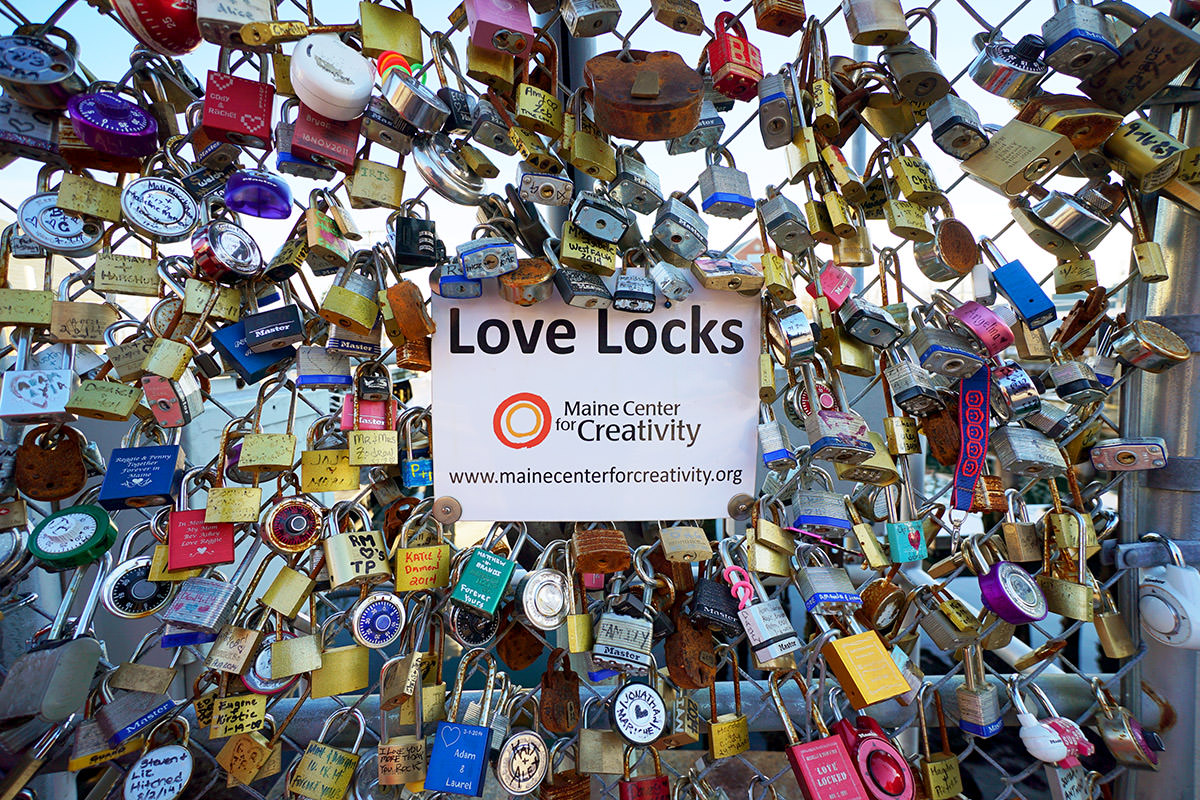
To profess their undying, never-ending love, a couple will write their names on a lock, attach it to the fence, then throw away the key. I have no idea if you come back with a bolt-cutter if things don't work out, but it's a nice idea.
I decided to explore somewhere new this time around, and left the Old Port area for downtown. That's when I saw... MAINE LOBSTERMAN!
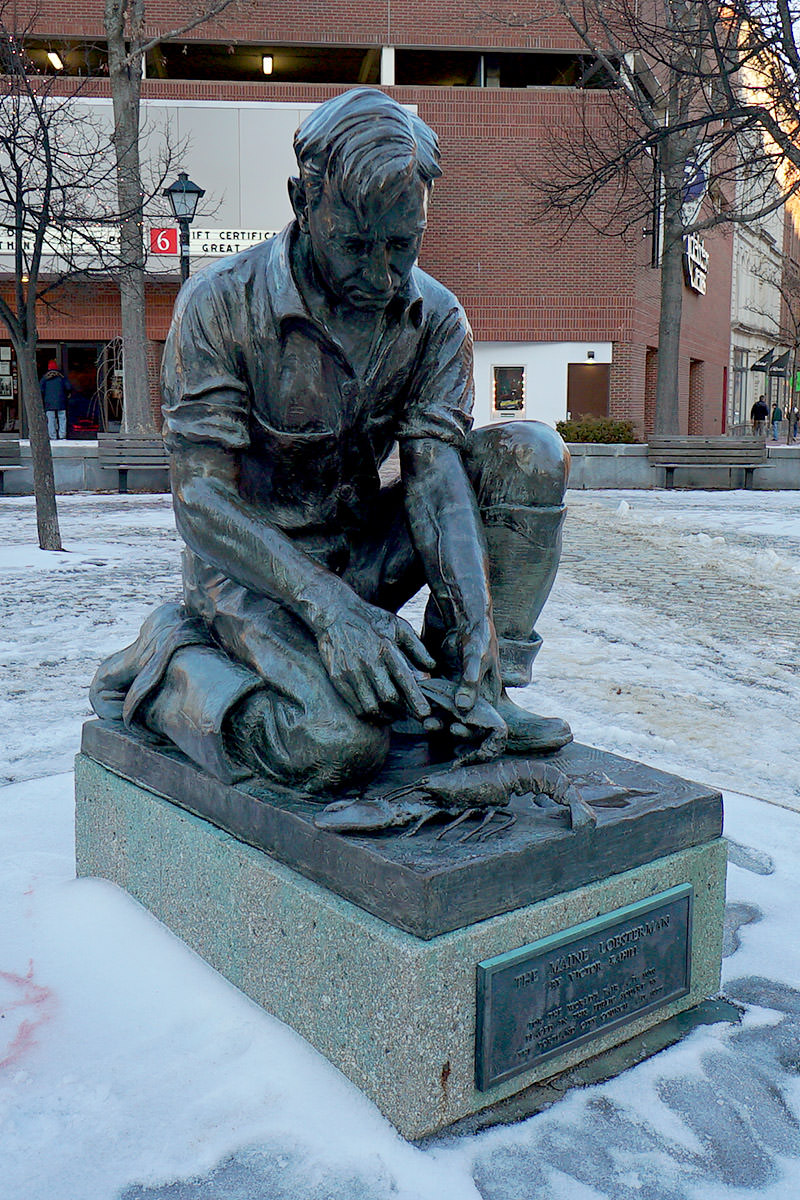
Sculpted for the New York 1939 World's Fair, this piece has an interesting history (which you can read about here). At first I thought that the guy was giving first aid to a lobster with a hurt claw, but that's apparently not the case at all...
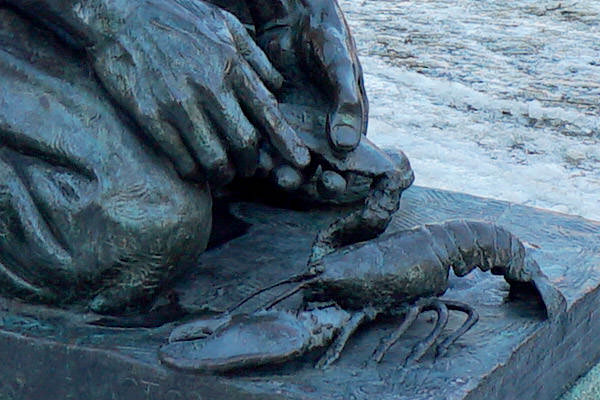
He's actually "pegging" the poor thing... which is to say he's shoving a wooden peg in the claw joint so it can't be opened (so he can't pinch anybody). This practice has mostly been abandoned, and now they just wrap a plastic band around the claw. Still a bit cruel, but I'm guessing it's not as painful to the lobster. At least until he gets boiled alive.
As I was walking, I saw a really cool painting on the side of a building that was meant to mimic a giant blueprint being laid over the structure...
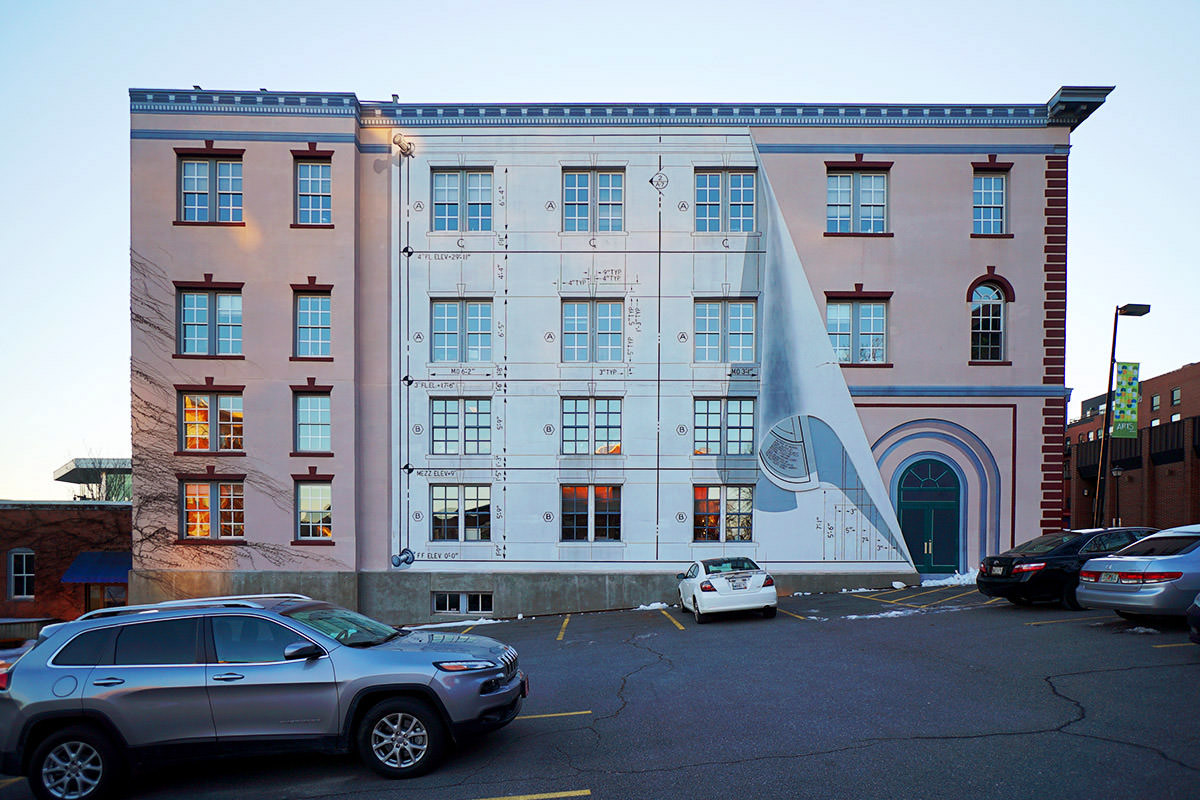
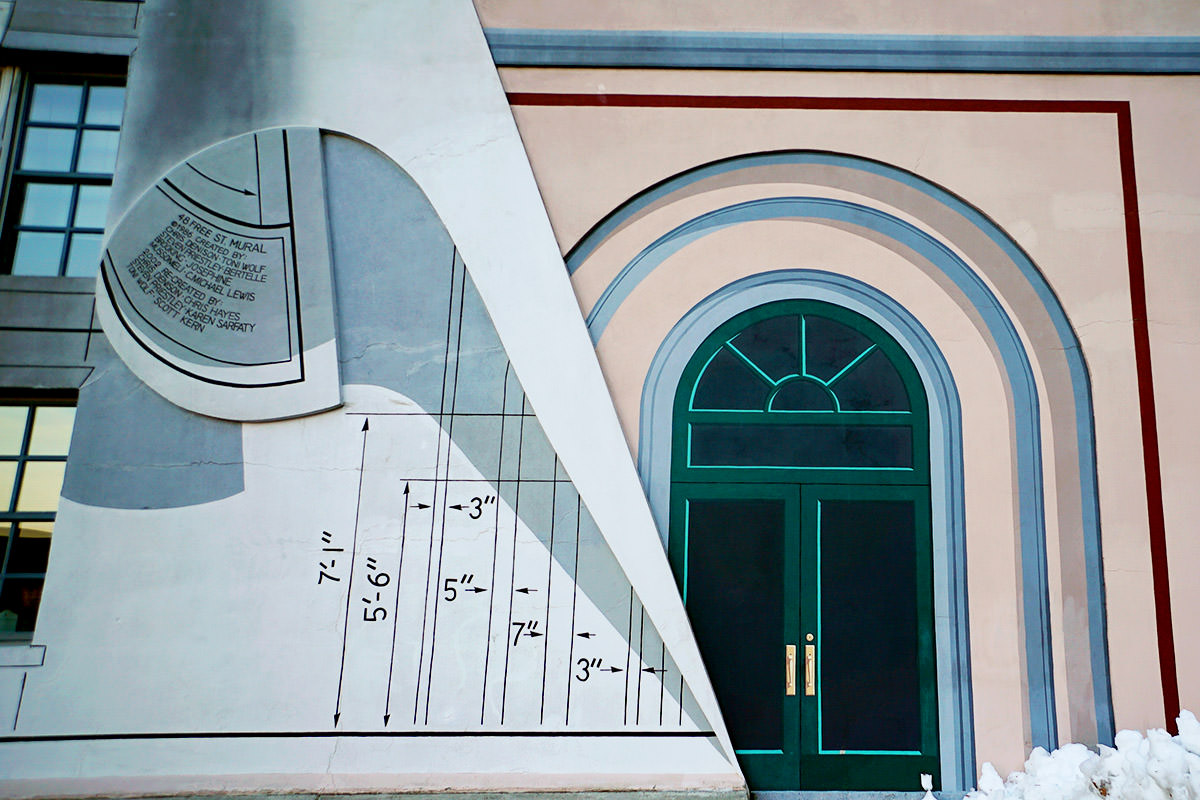
Just across the street is a giant postcard painting that's also pretty cool...


If you look closely, the "lighthouse" is actually a spray-can...

At this point I was so cold that I could barely move, so I called a taxi while taking a few last photos as the sun set...
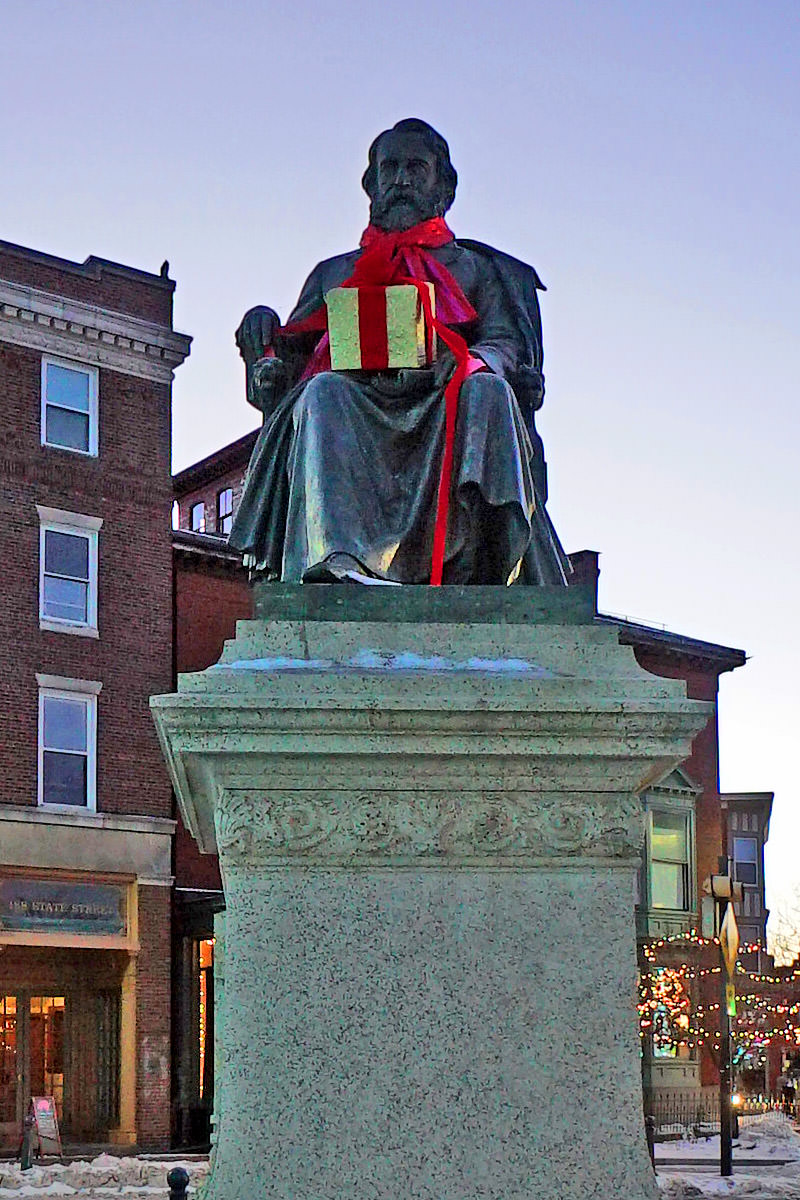
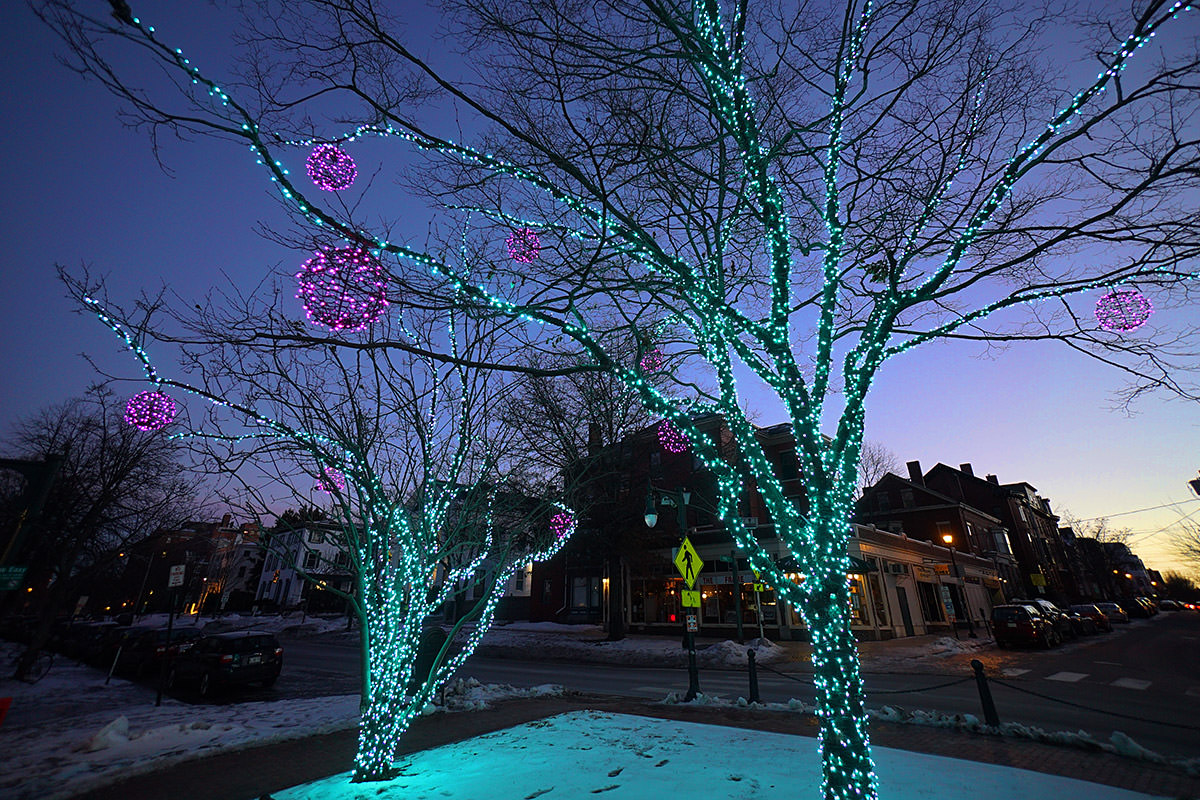
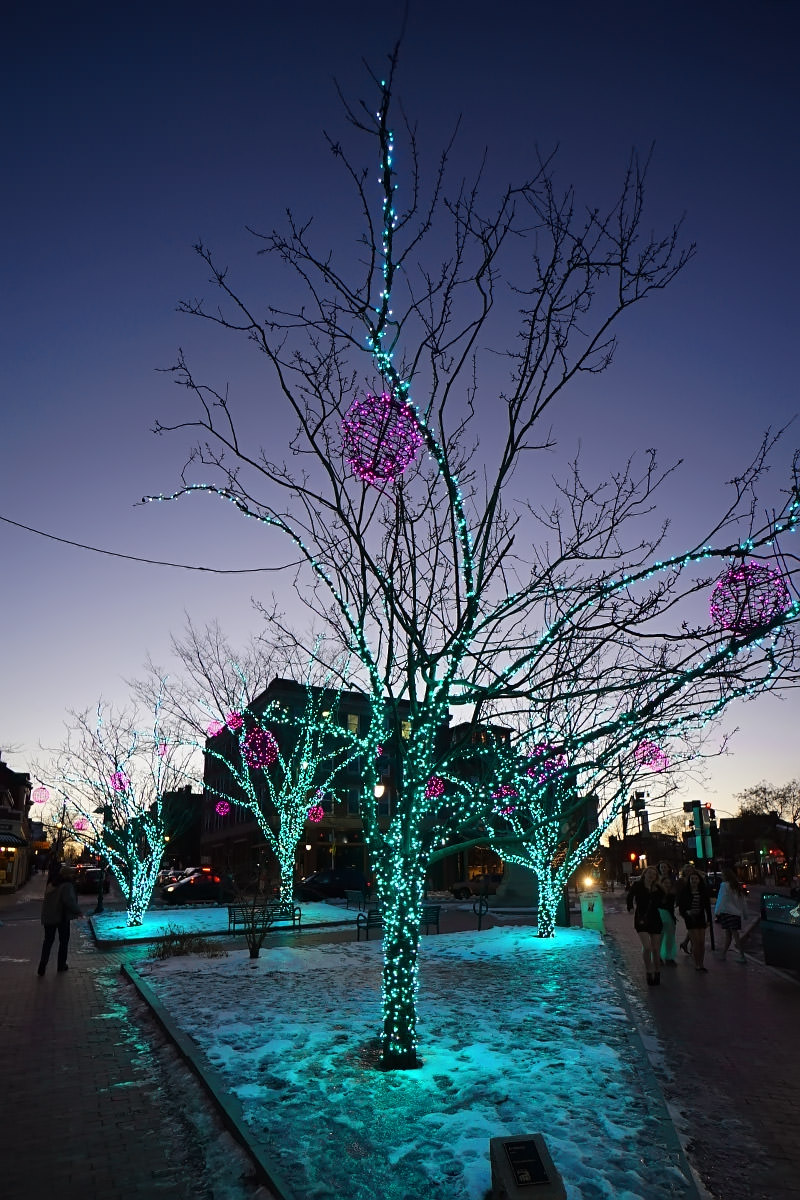
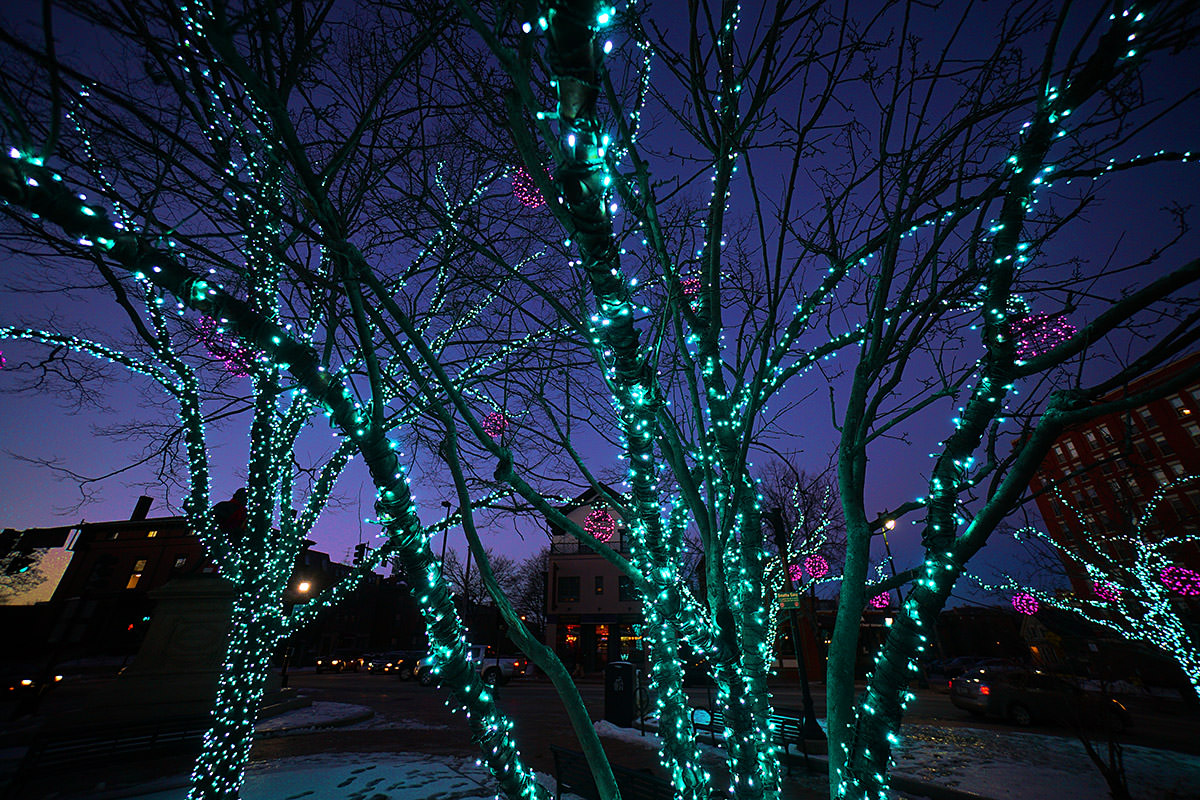
And that was that.
Back to my airport hotel room where I can (hopefully) get a few hours sleep before my early morning flight.
 I left Auburn at noon and was back in Portland by 1:00... just in time for lunch.
I left Auburn at noon and was back in Portland by 1:00... just in time for lunch.
But first I had to spend a half hour scraping snow and ice off my rental car. This included the tires, which had frozen to the ground...
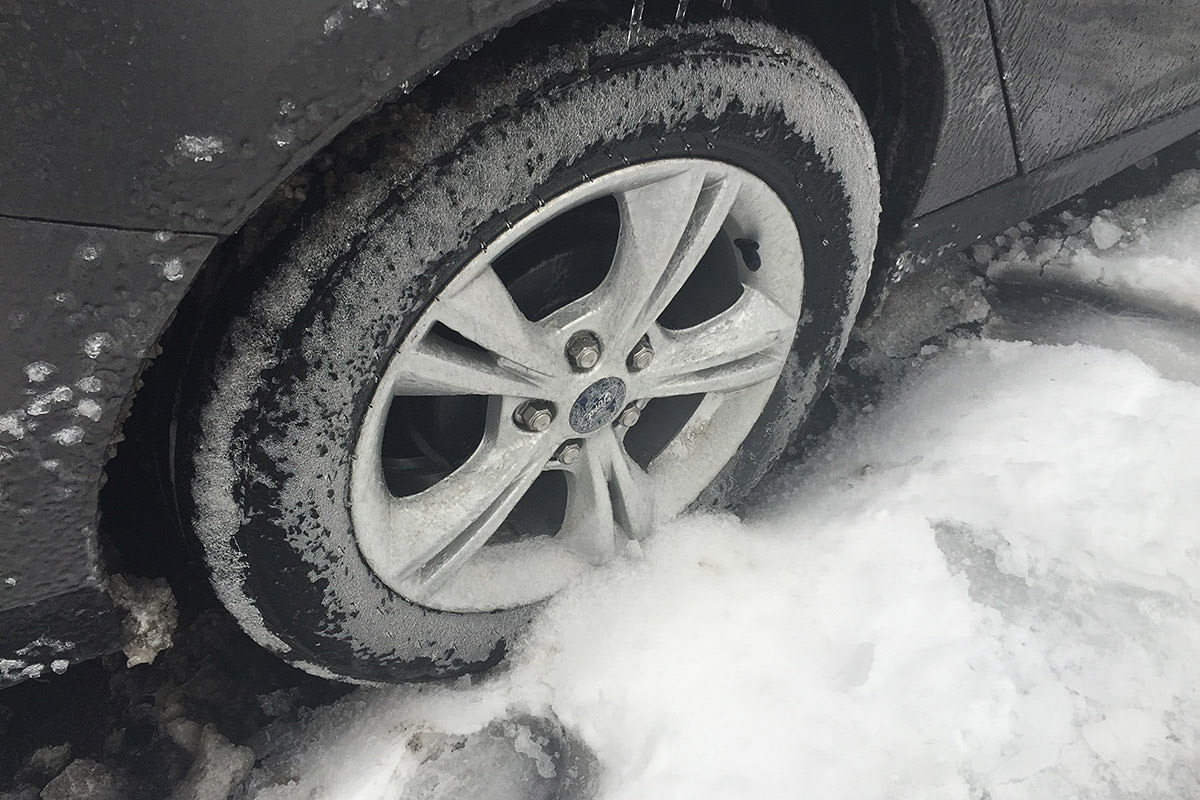
The Ford Focus I rented is a pile of crap for many reasons. Primary of which is the horrendous gas mileage. Driving the 80 miles to Auburn and back killed... I shit you not... A HALF-TANK OF GAS! As if this wasn't bad enough, the car is just awful design-wise. Massive, glaring blind spots. A driver console that has no place to put your mobile phone. Uncomfortable seats. Utterly shitty "Sync by Microsoft" computer system that's as intuitive as a nuclear reactor to control. And then you get to the outside where you have this fucking huge gap between the hood and the windshield that is so cavernous and deep that it's extremely difficult to dig all the snow out of it. Even if you have a brush, there are ridges in there that makes it much more trouble than it's worth...
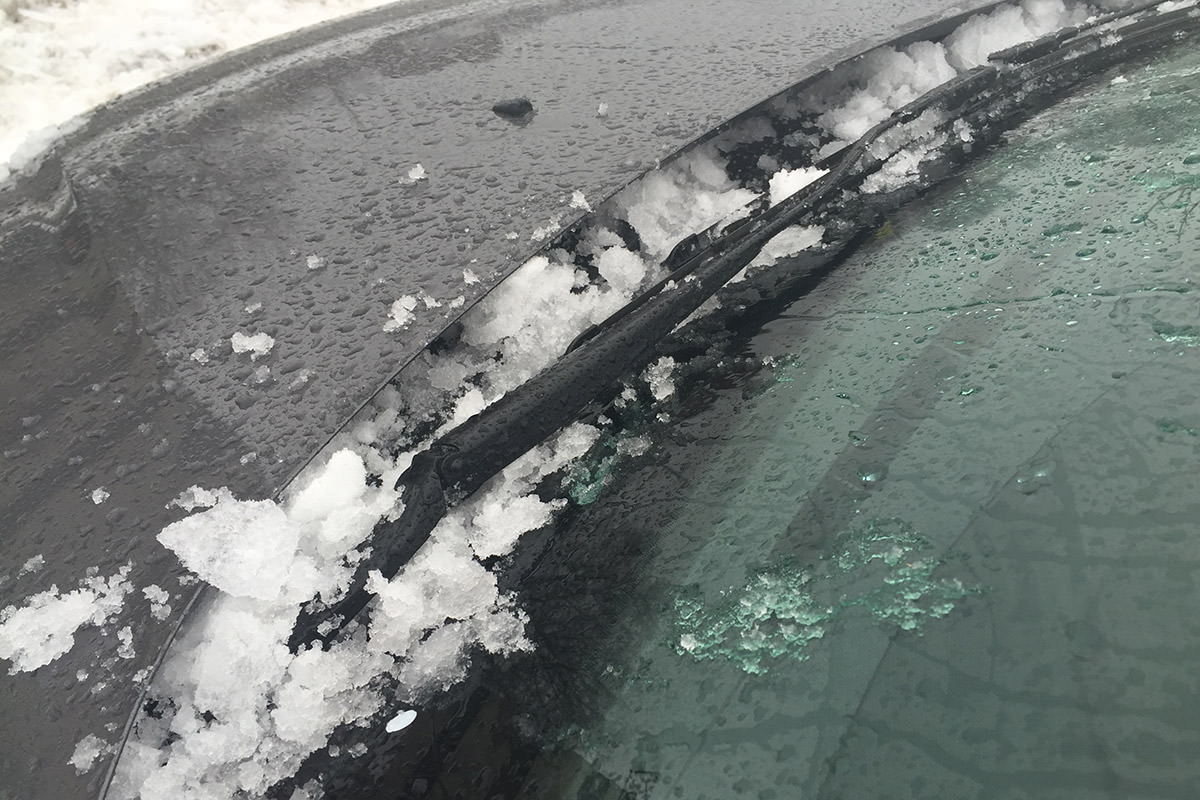
No wonder everybody wants a foreign car... their designers actually think about shit like this.
But anyway...
For reasons completely unknown, Portland, Maine has some really excellent pizza restaurants. This is nice because it takes the edge off the misery you experience when visiting in the cold, snowy, wet, days of Winter. A place I had wanted to visit but never got around to last time I was here was OTTO Pizza...
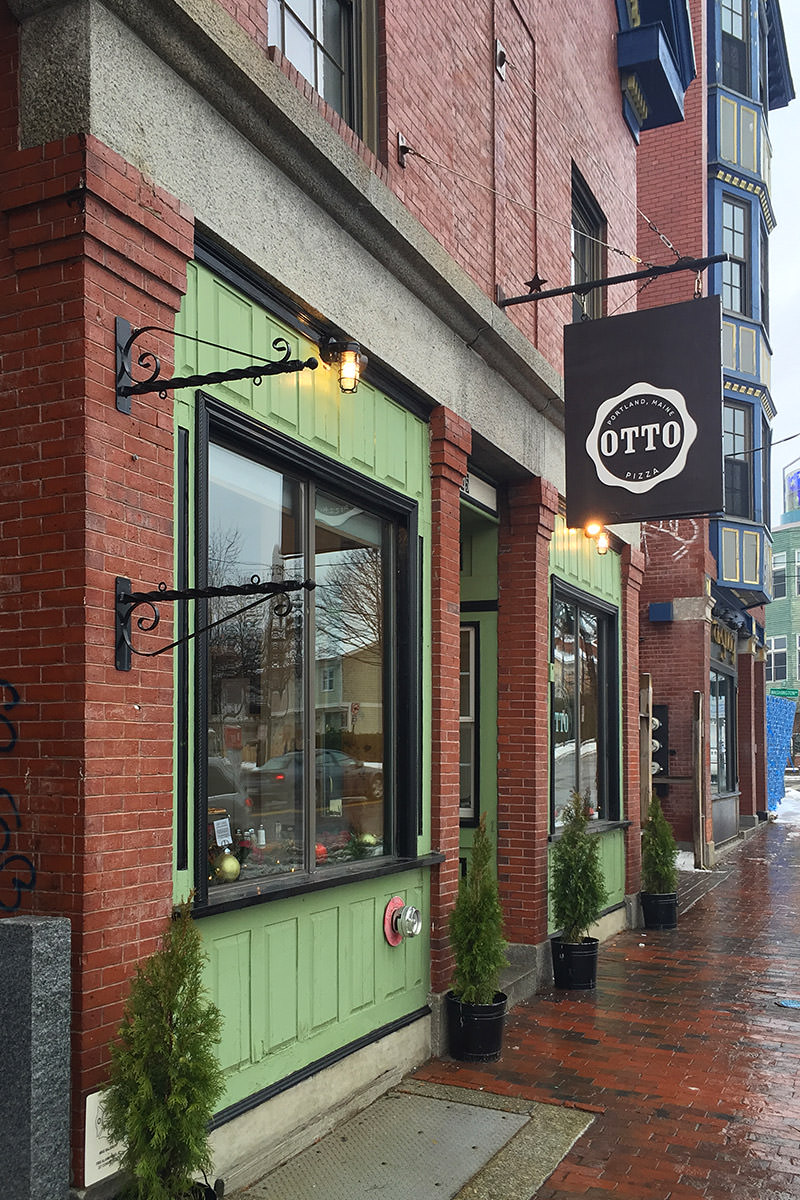
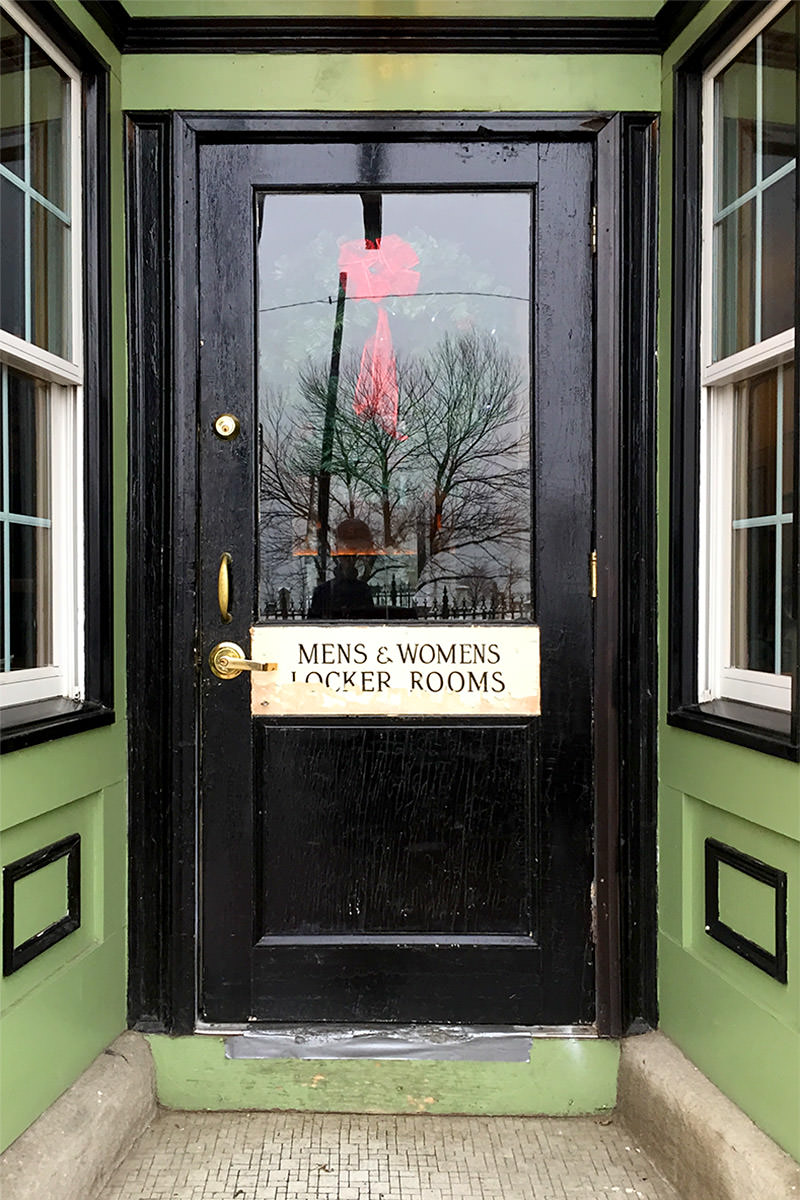
They are kinda famous for their Butternut Squash, Ricotta & Cranberry pie...
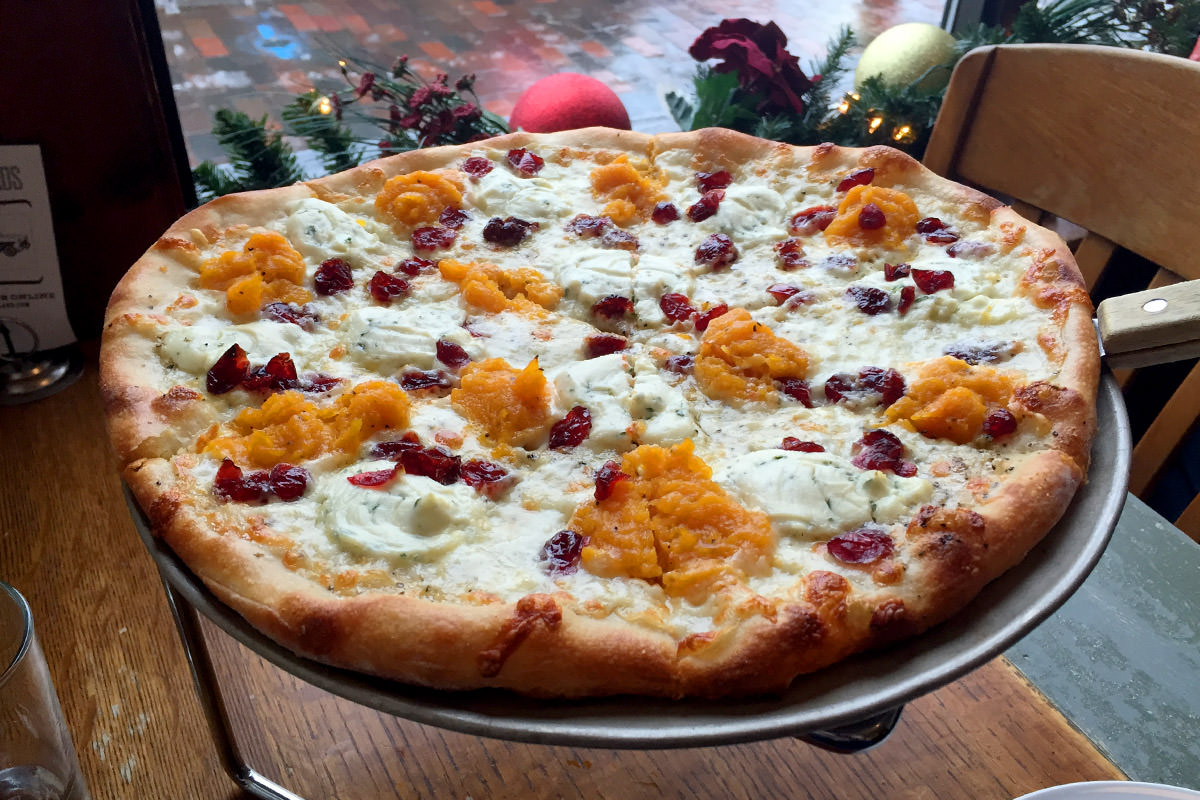
Sounds weird, I know. But it is pretty wonderful. Creamy with subtle flavors that taste amazing together...
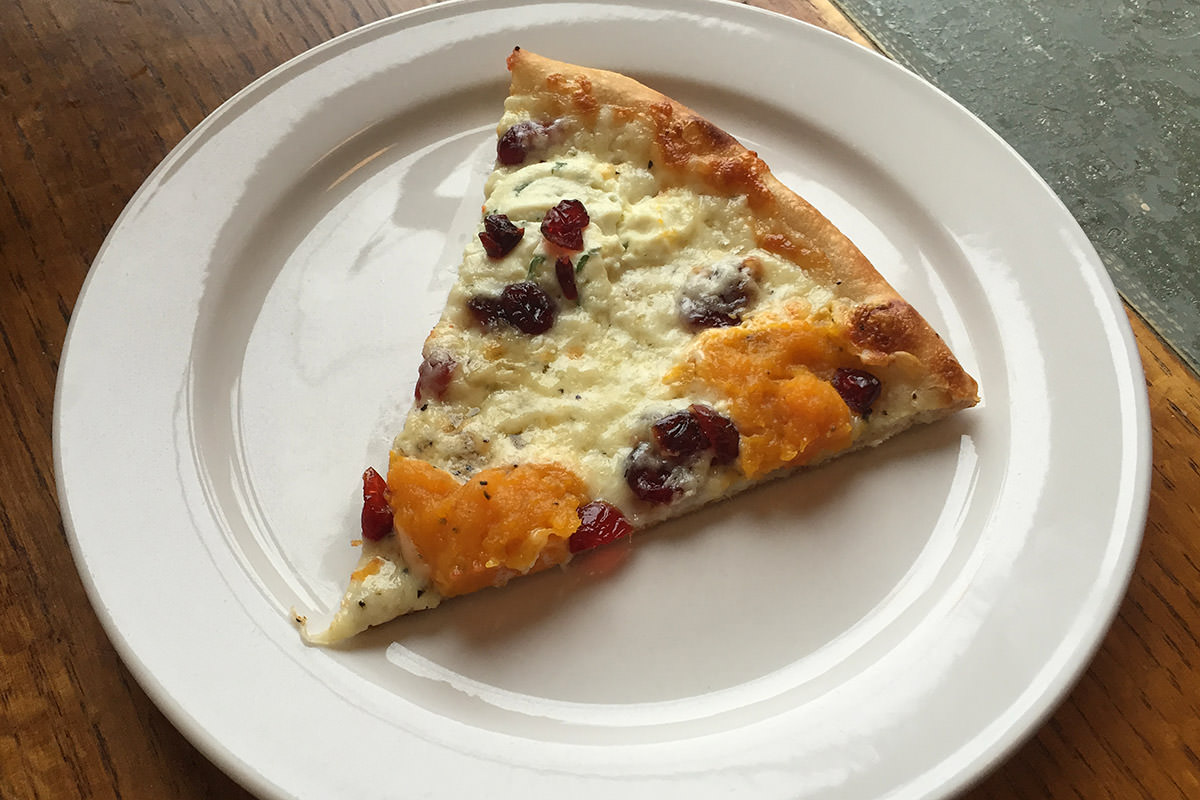
It's important to eat it while it's hot though. As soon as it gets cold the texture gets kind of rubbery and weird.
OTTO's itself is a nice enough place. Kind of eclectic in a rustic way. Service is pretty good too. The only thing I hated is that somewhere in the restaurant there's a piano that kids are, apparently, welcome to bang all over. This makes an ungodly racket that completely ruins the experience of eating here. And I cannot fathom why in the hell they allow it. They must know that it's irritating as fuck to listen to that shit... so why put your customers through the agony? Stupid.
After some various errands, it was my plan to get some sleep.
Or not.
I made the foolish mistake of checking my email only to find a problem that required me to head back out into the cold, snowy, raining, wet misery I had just escaped from. At least I was smart enough to bring my camera along with me. I didn't have it on my previous trip, and really wanted to take a shot of the Harbor Fish Market (which proved impossible with my iPhone). It's a beautiful building with amazing lighting that has a steady flow of customers pulling up all day...
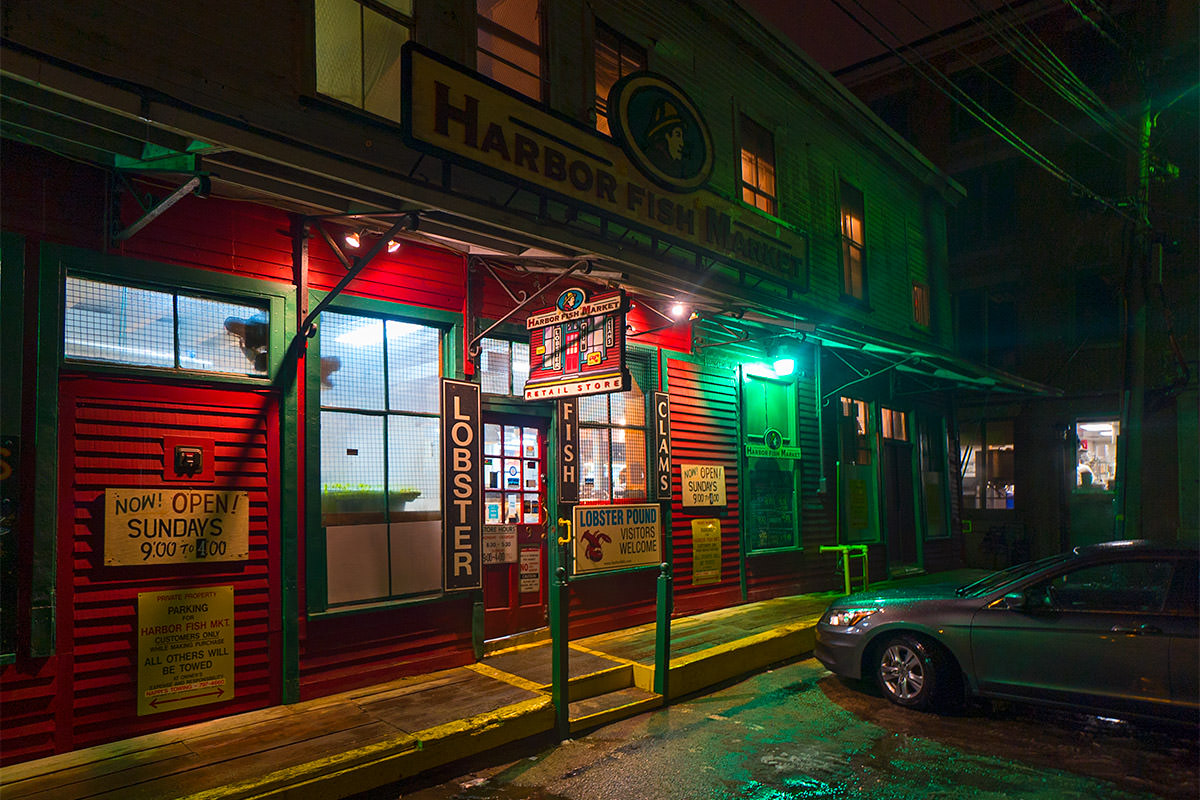
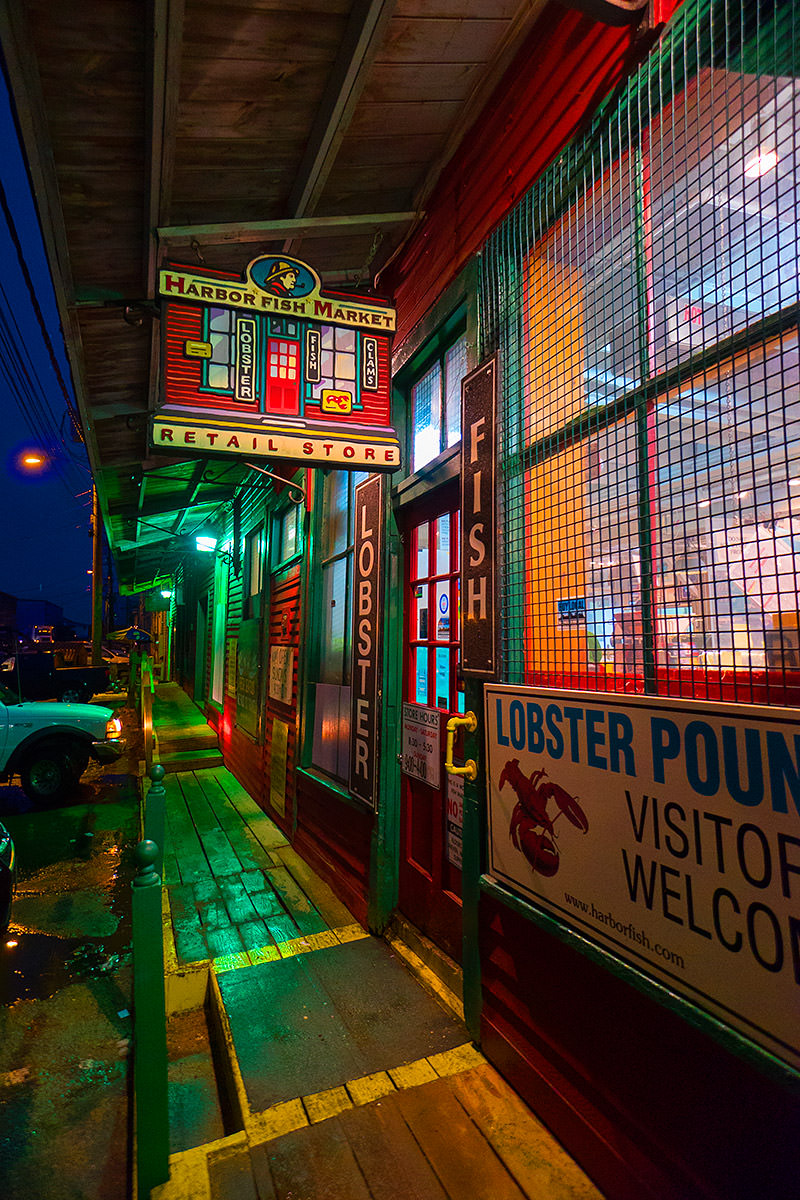
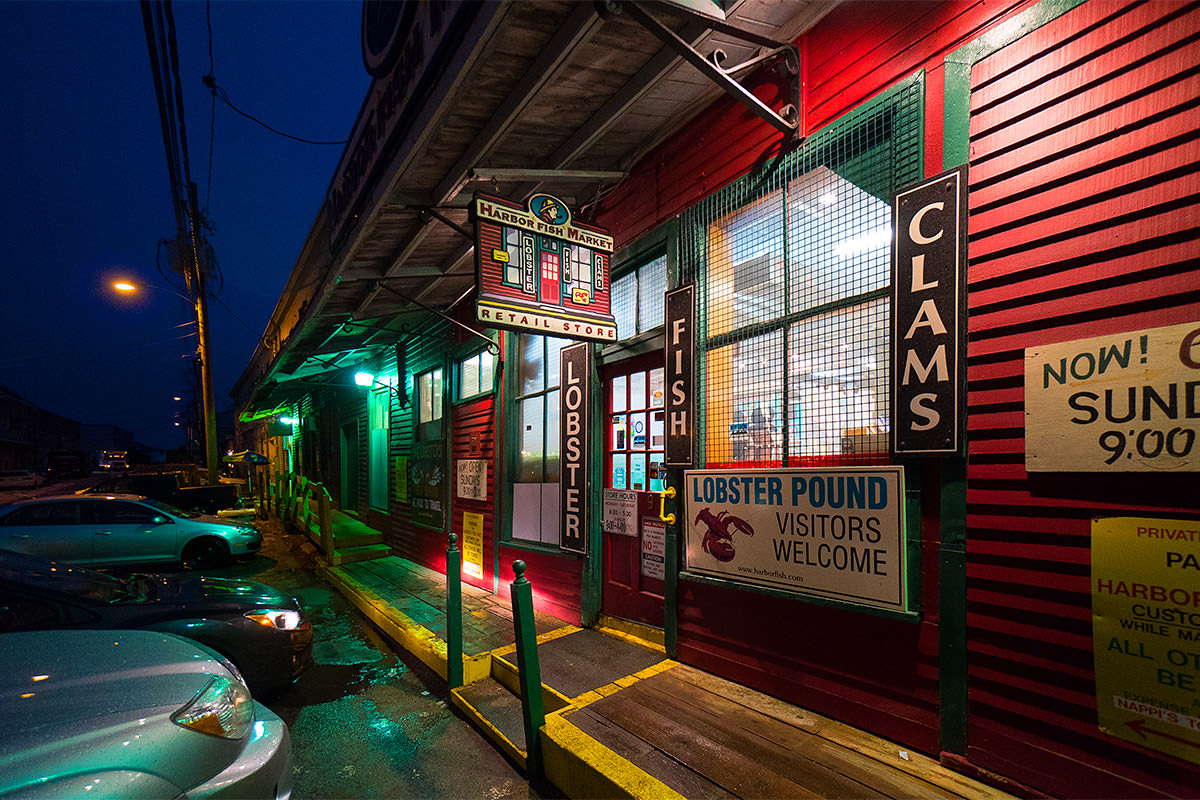
From there I wandered around for a while to see if I could find anything else interesting to shoot...
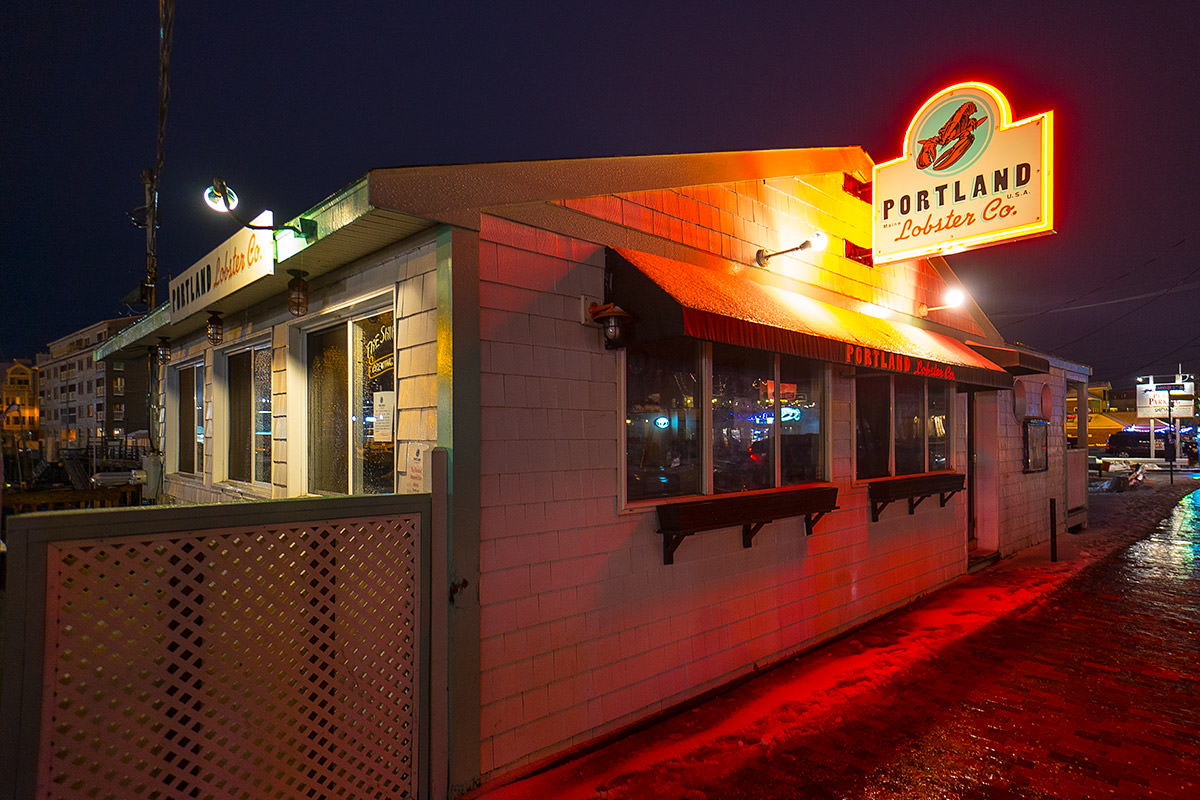
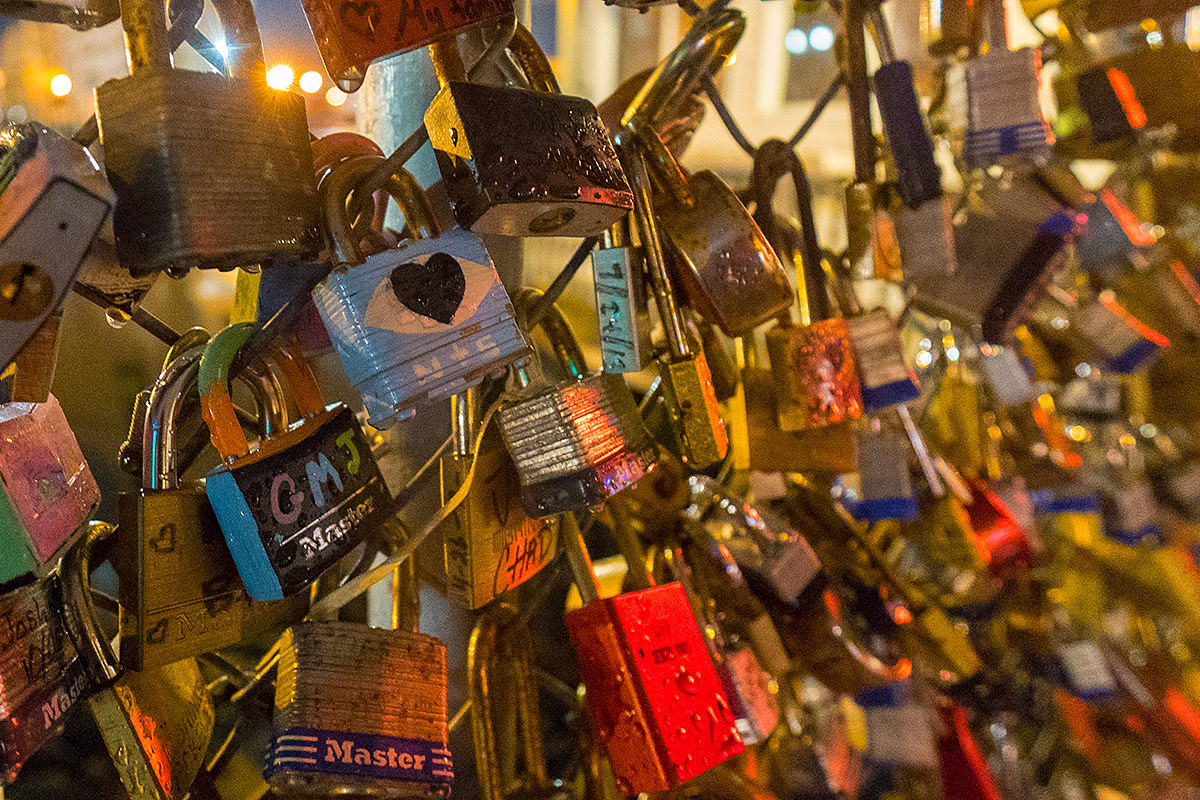
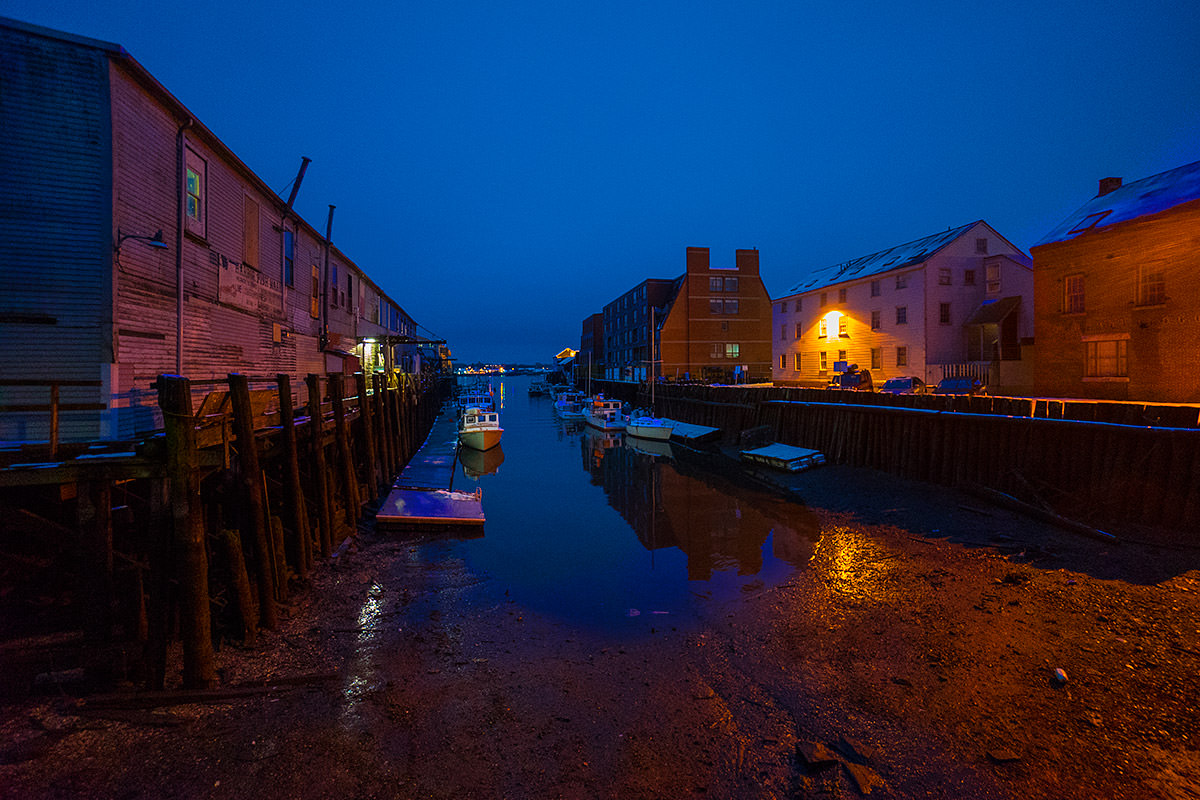
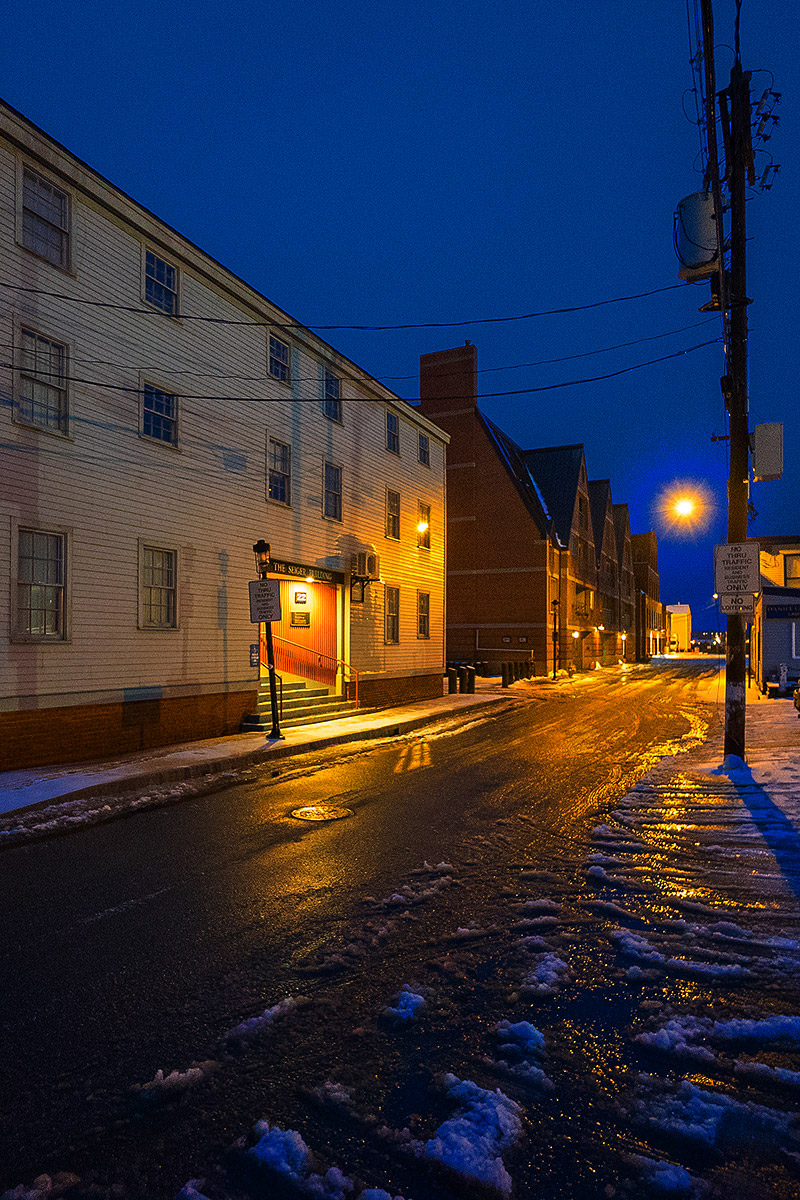
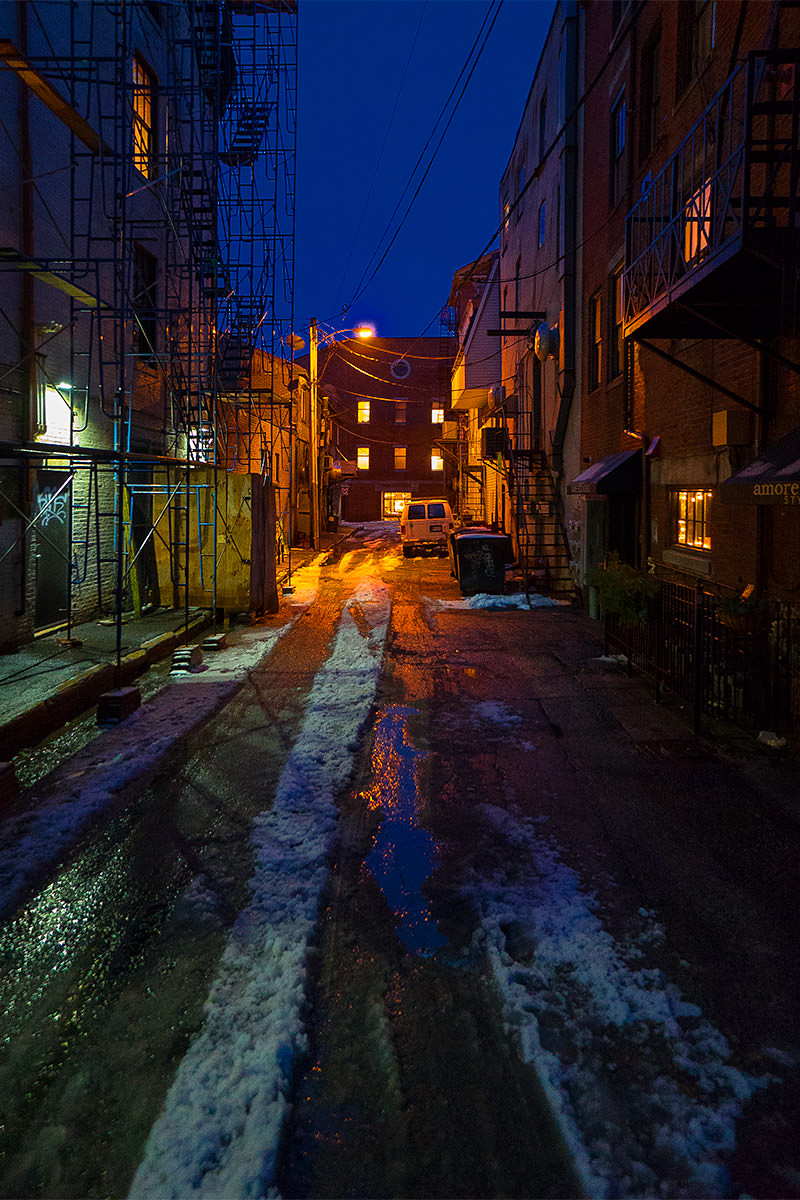
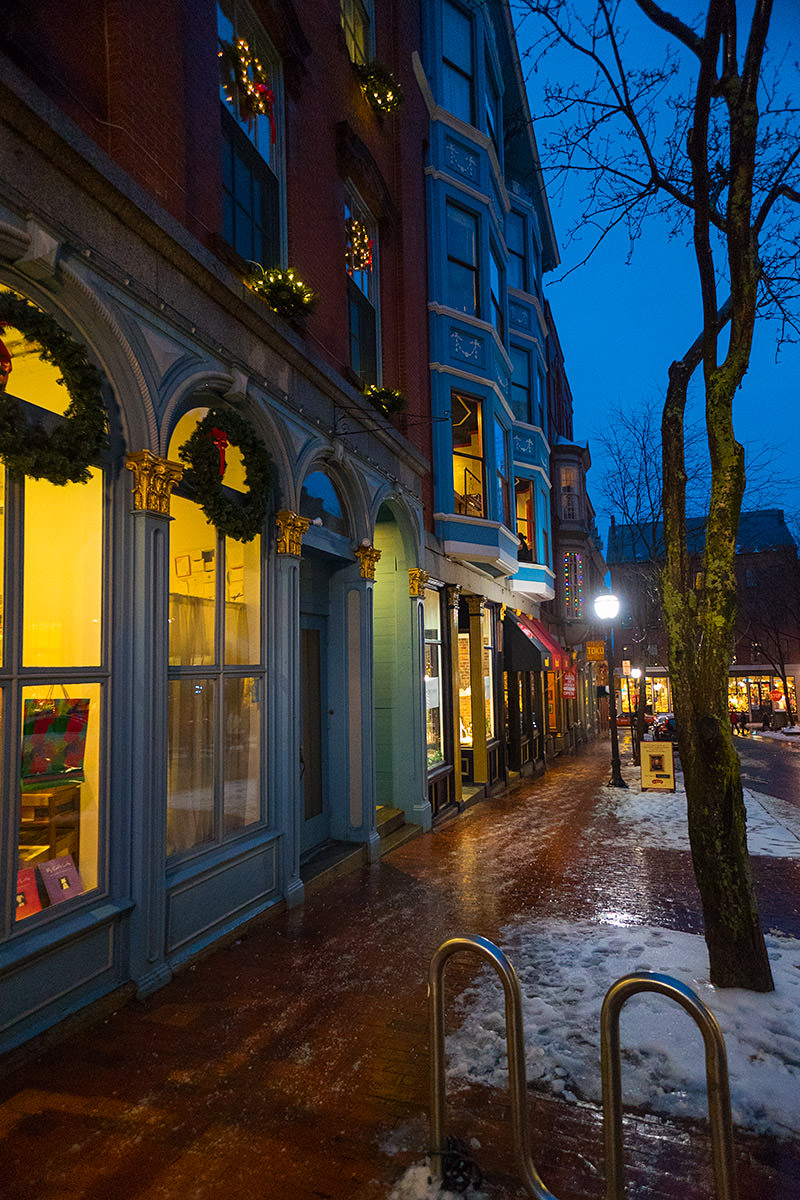
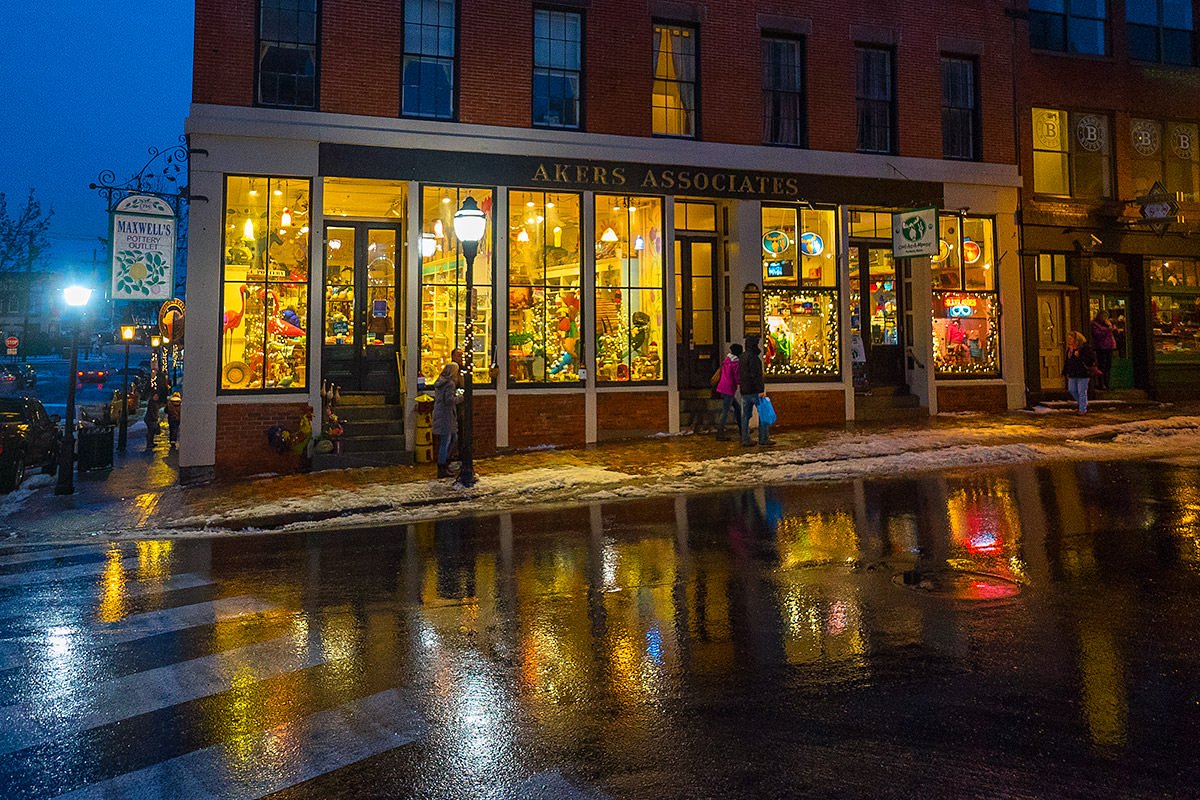
I finished up my evening at my favorite restaurant in the city... Flatbread Company. I was still stuffed with OTTO pizza, so dinner was out of the question. But Flatbread Company makes some of the best desserts I've ever had, so I decided to try their Apple Crisp...
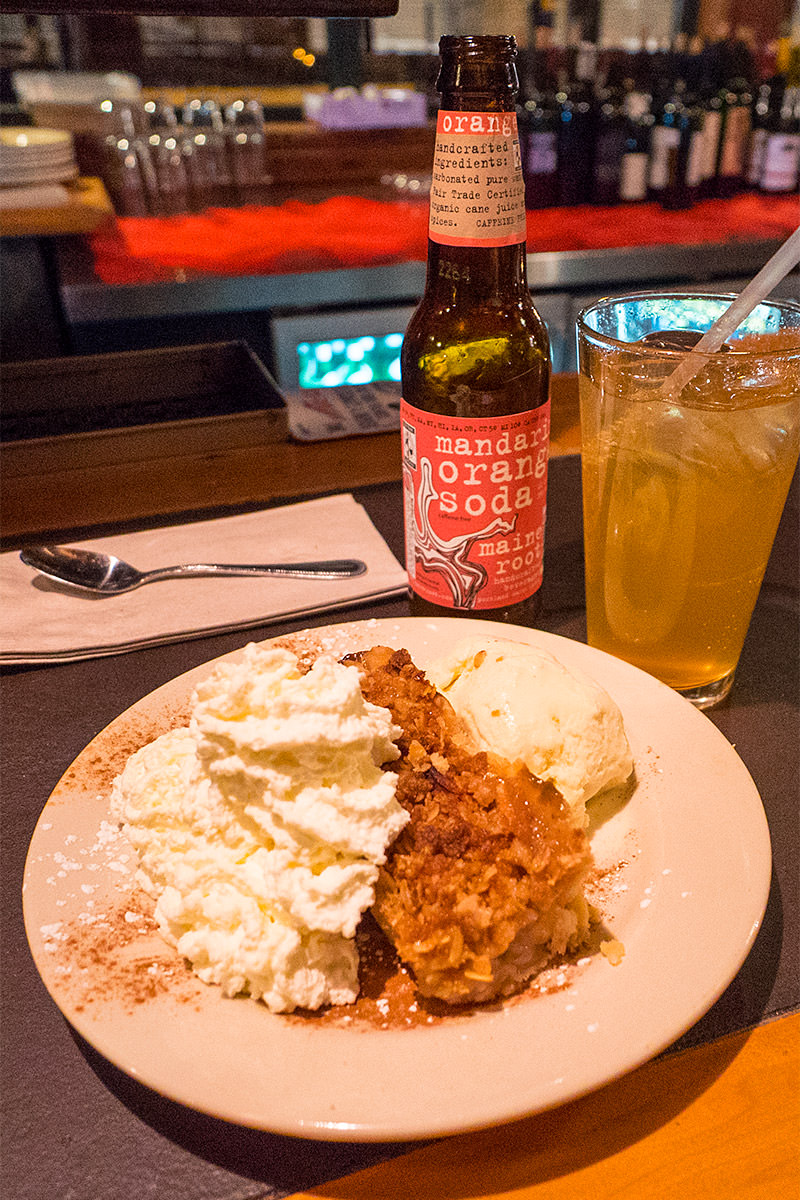
Not as jaw-dropping amazing as their wild blueberry desserts (which are out of season, darnit!), but still fantastic. Fortunately their chef is smart enough to know that RAISINS HAVE NO PLACE IN APPLE CRISP EVER!!! I frickin' hate it when somebody ruins a good apple crisp by dumping raisins in it. BLECH!
And now, at long last, that sleep I've been trying to chase down all day...
 After Apple discontinued their Aperture photo software, Adobe promised to deliver a plugin for their competing "Lightroom" product that would allow you to import your Aperture library into Lightroom.
After Apple discontinued their Aperture photo software, Adobe promised to deliver a plugin for their competing "Lightroom" product that would allow you to import your Aperture library into Lightroom.
Thanks, Adobe!
Yesterday the plugin was finally released.
Thanks, Adobe!
Today I spent just over five hours performing the import. Only to find that -zero- photos had actually been imported.
Thanks, Adobe!
 Put down that pumpkin spice latte... because Bullet Sunday starts... now...
Put down that pumpkin spice latte... because Bullet Sunday starts... now...
• Fall? Somehow Autumn got here and I missed it. Time to get the blankets out of storage, I suppose.
• Astrophotography. After my happy accident in discovering astrophotography in Africa, I spent my evening Googling about it. Turns out there's an entire site devoted to the hobby called Lonely Speck. Very cool. Ironically, there's a review of my new Sony A7s camera there... for astrophotography...
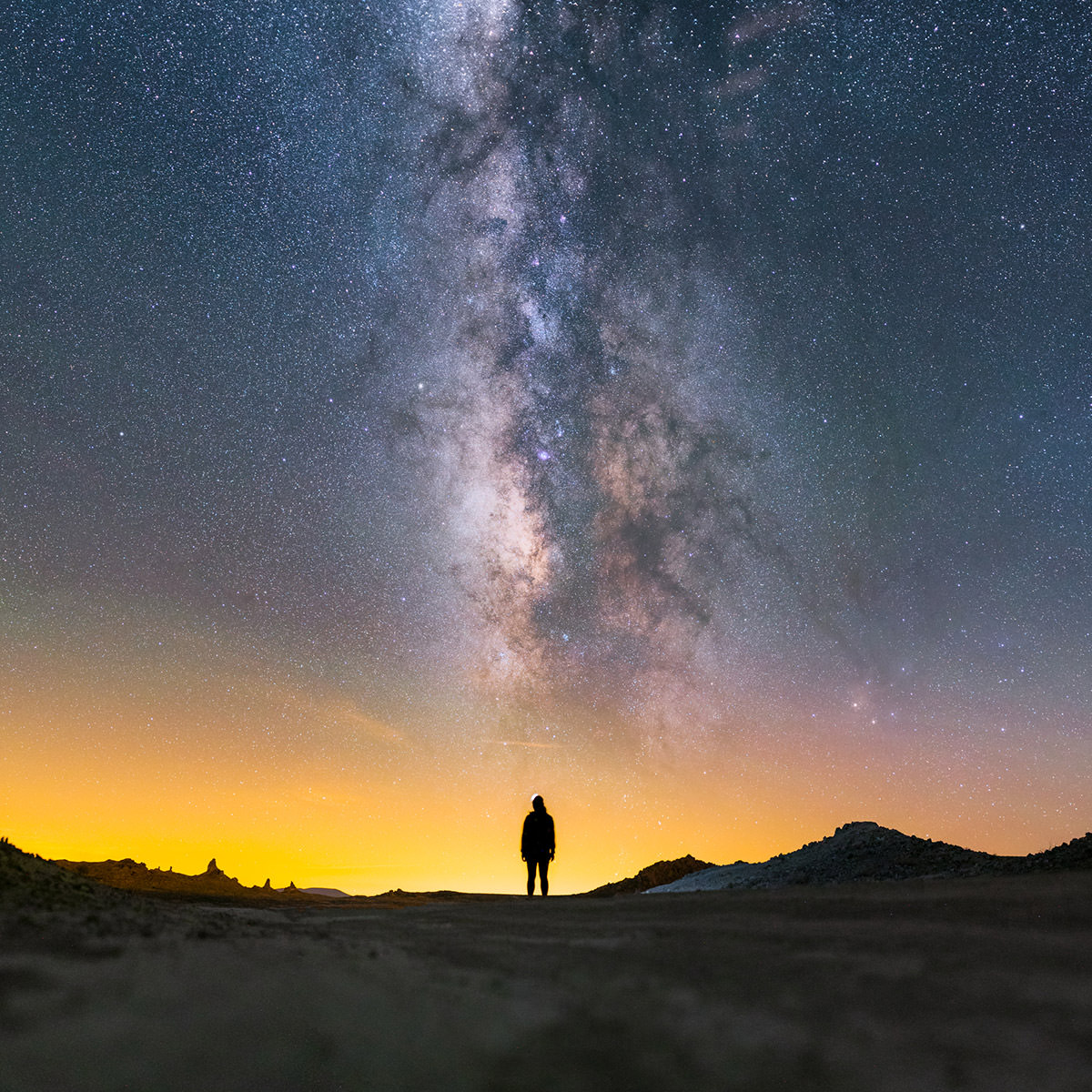
Image by Ian Norman of Lonely Speck
Now I wished I lived in an area where there's no light pollution so I can shoot the stars.
• Tasty! And now... BIG CATS EATING MARMITE!
Borders on cruelty to animals, I say.
• Kick Drum Heart. It's not the chase that I love....
...It's me following you.
• Gum! Ooh! Please! Please! Please! Let this be happening.
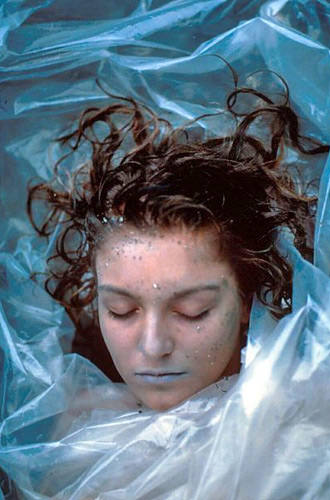
SHE'S DEAD! WRAPPED IN PLASTIC! Again?
• Fall Season. And so here's my assessment of the new Fall shows so far...
And... I'm spent. No more bullets for you.
 Everything's coming up picture perfect... because a very special Bullet Sunday on Tuesday FOUR HUNDREDTH ANNIVERSARY "WHAT'S IN YOUR CAMERA BAG" EDITION starts... now...
Everything's coming up picture perfect... because a very special Bullet Sunday on Tuesday FOUR HUNDREDTH ANNIVERSARY "WHAT'S IN YOUR CAMERA BAG" EDITION starts... now...
• Sony NEX-6 Camera. This is my main shooter, which I reviewed here back in May, 2013. Because it's a mirrorless camera, it is small, light, and perfect for travel... yet maintains the photo quality of a bigger, heavier DSLR. The one big caveat is that it doesn't have a full-frame sensor, so there's a crop factor for any full-frame lenses you attach. This actually ended up being a benefit on my recent trip to Africa, because my 70-200mm FE lens becomes a 105-300mm lens, making it much easier to zoom in on animals in the bush...
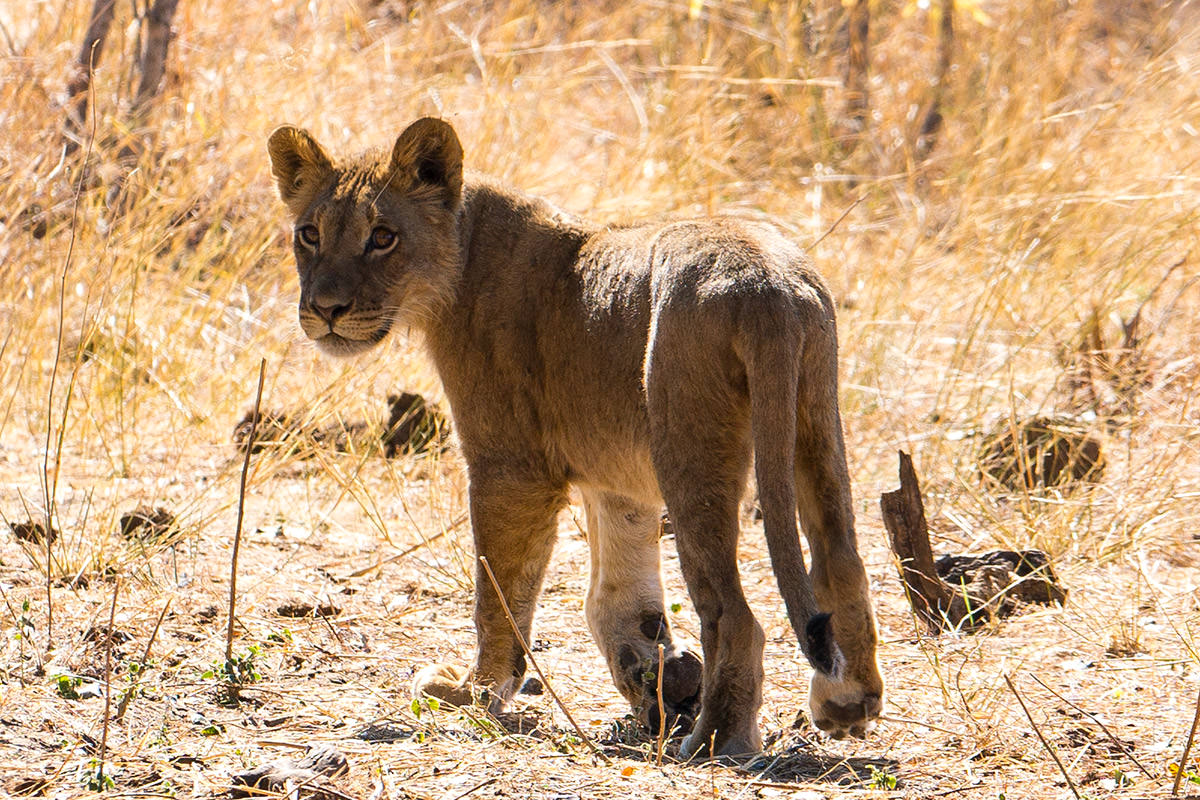
There's not much I don't like about the NEX-6... except the start-up time, which is kinda slow and did cost me a shot or two. Otherwise? A wonderful camera that is capable of delivering great photos. Will probably trade it in for a full-frame sensor camera before my next big trip (hopefully the successor to the Sony A7r.
16.1MP • ISO 100-25600 • $748 (discontinuted) • ★★★★☆
• Sony A7s Camera. I bought the latest Sony mirrorless camera specifically for night-shooting on my Africa trip. I knew there would be game drives in the evening, and wanted every possible advantage in getting clean shots. The A7s is made for this kind of shooting with its high ISO full-frame sensor, and gave me images I would have had a very hard time getting with any other camera. This post-sunset shot, for example, was taken in near-darkness. It was so dark that I could barely see, and didn't know what I had captured until after I looked at the camera's display...
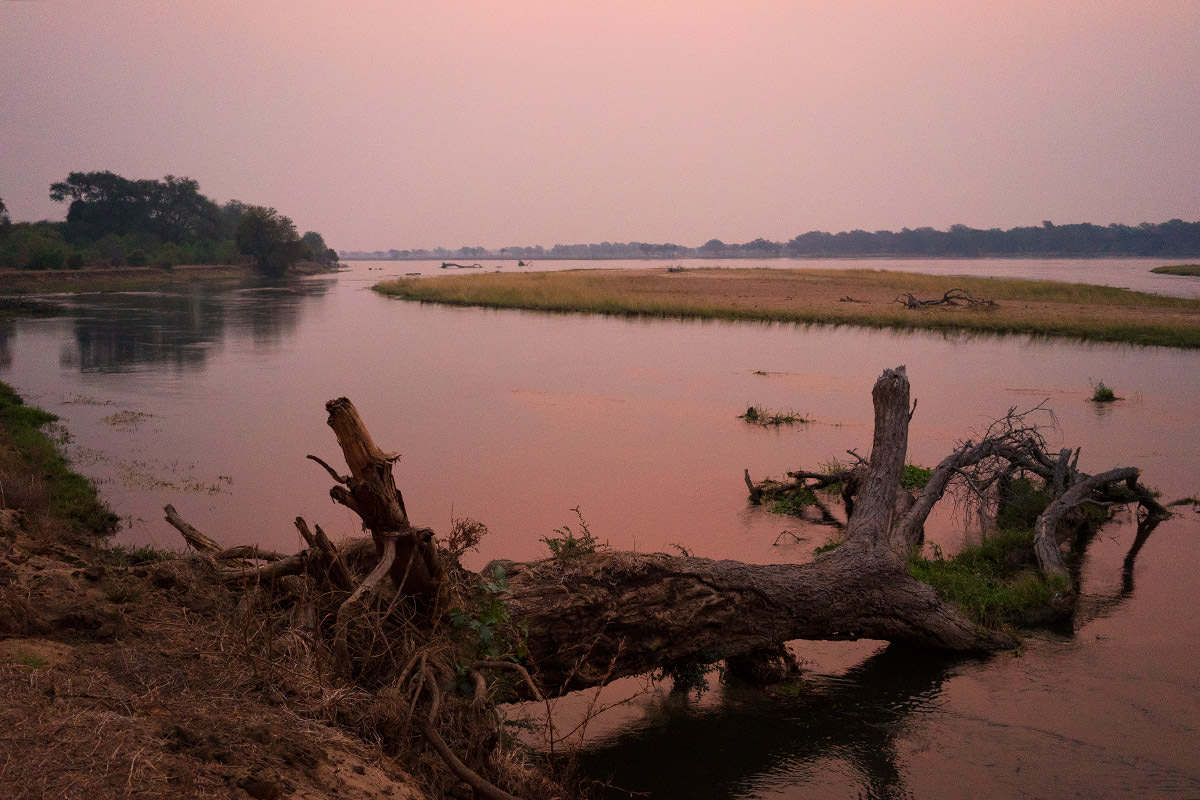
Yes, things get a bit grainy when shooting at those monster ISO levels, but at least you get a shot...
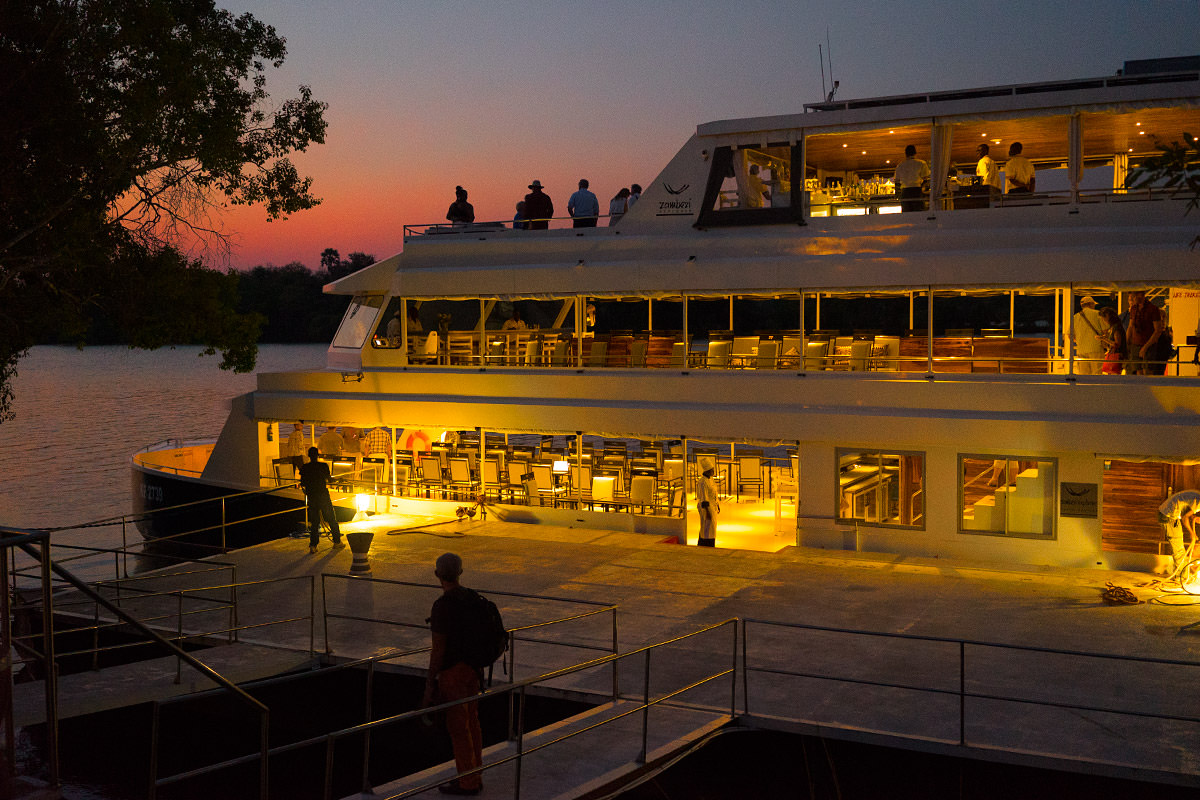
For red-light safari drives in total darkness the A7s really shines, giving me shots that my NEX-6 couldn't hope to touch...
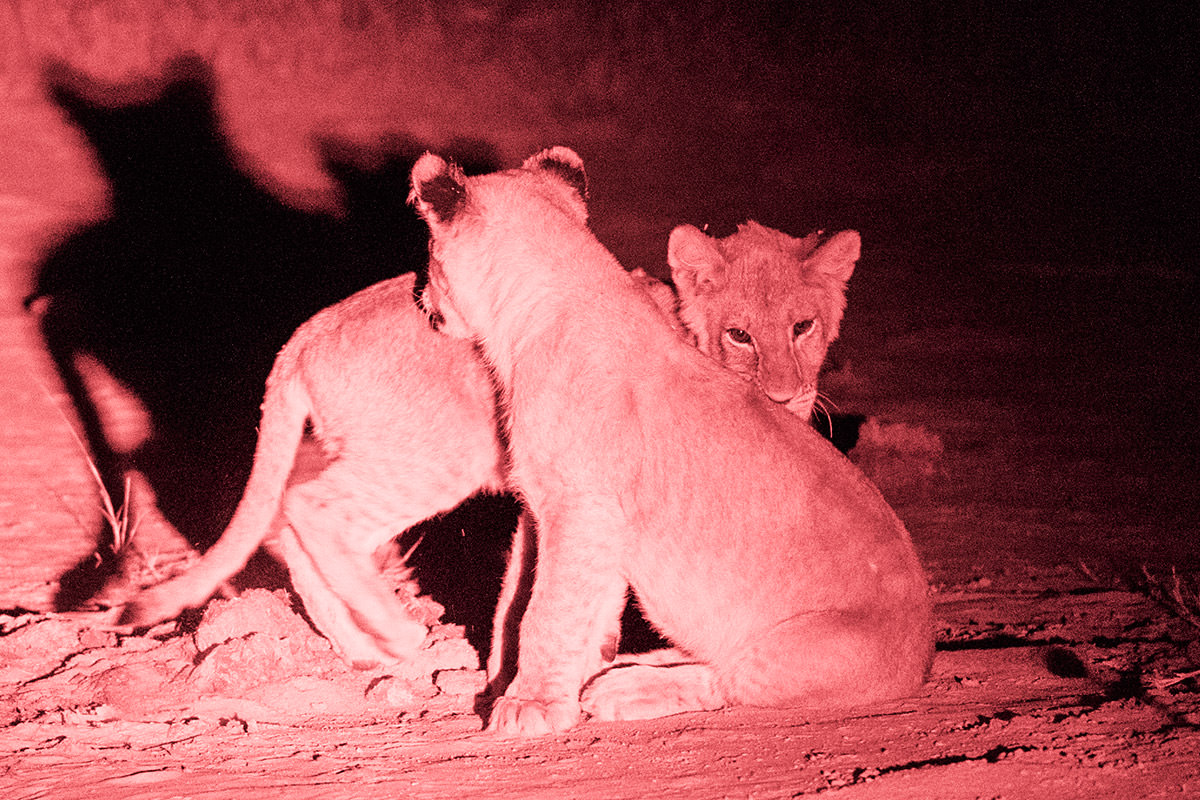
The A7s loves low light and, quite by accident one night, I discovered what this would mean if I shot the night sky...
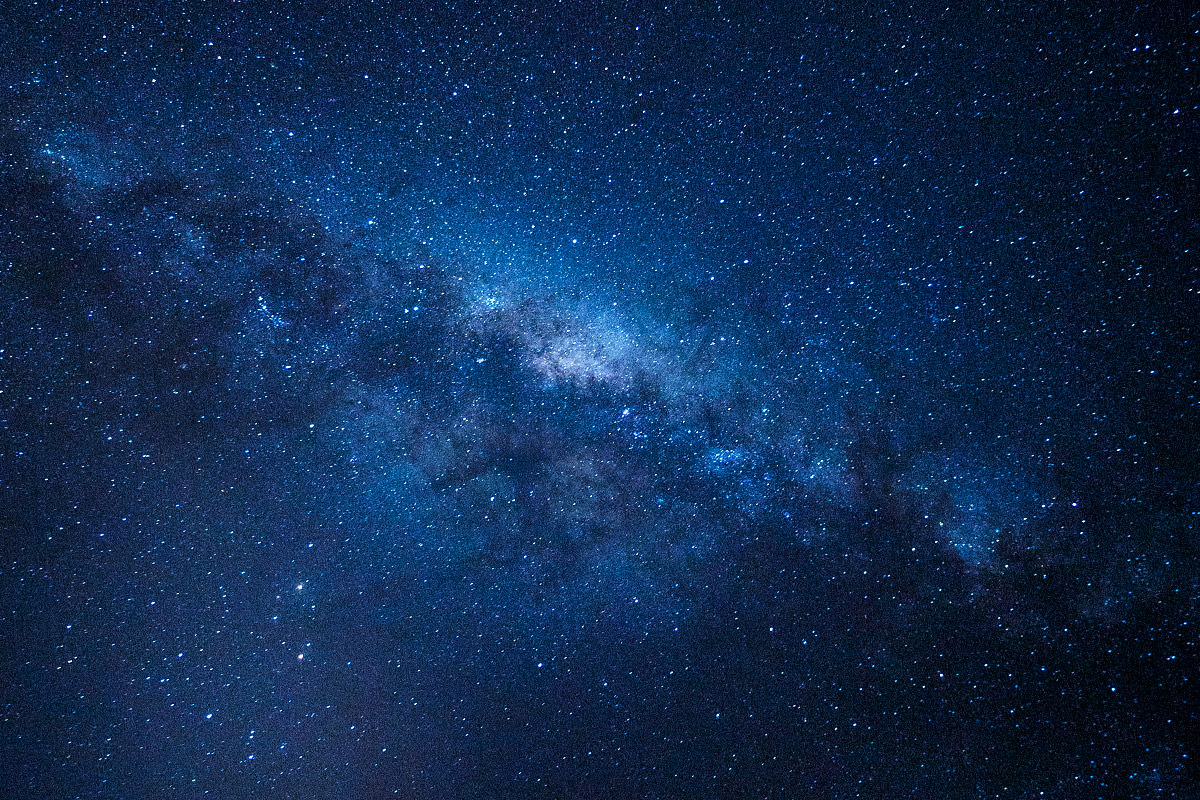
The ability to shoot in near-blackout conditions comes at a price, however. The sensor resolution is a meager 12.2 megapixels. This will turn off a lot of photographers who equate megapixels with photo quality, as a 4240 x 2832 image seems weak compared to the 7360 x 4912 you'll get out of other cameras in this price range. But all the pixels in the world can't save a shot if your camera records a big black blob, so it was a trade-off I was happy to make. And after looking at the amazing photos I managed to get, I have zero regrets. The A7s has terrific video capabilities, but I'm not a video shooter, so I'm taking Sony's word for it.
12.2MP • ISO 100-102400 • $2,499 • ★★★★★
• Sony DSC-HX50V. As a backup-backup (hey, how many times will I get to go on safari in Africa?) I needed a camera with some reach to it, and started shopping for ultra-zooms. The field has gotten really competitive, and finding the right camera was tough. Ultimately size was the deciding factor for me, and Sony's pocketable HX50V fit the bill perfectly. Sure, I would sacrifice some zoom (it's 30x when others in this arena are at 50x), and not being able to shoot RAW was disappointing, but it's a camera I could slip in my pocket and have with me at all times that I'd barely notice.
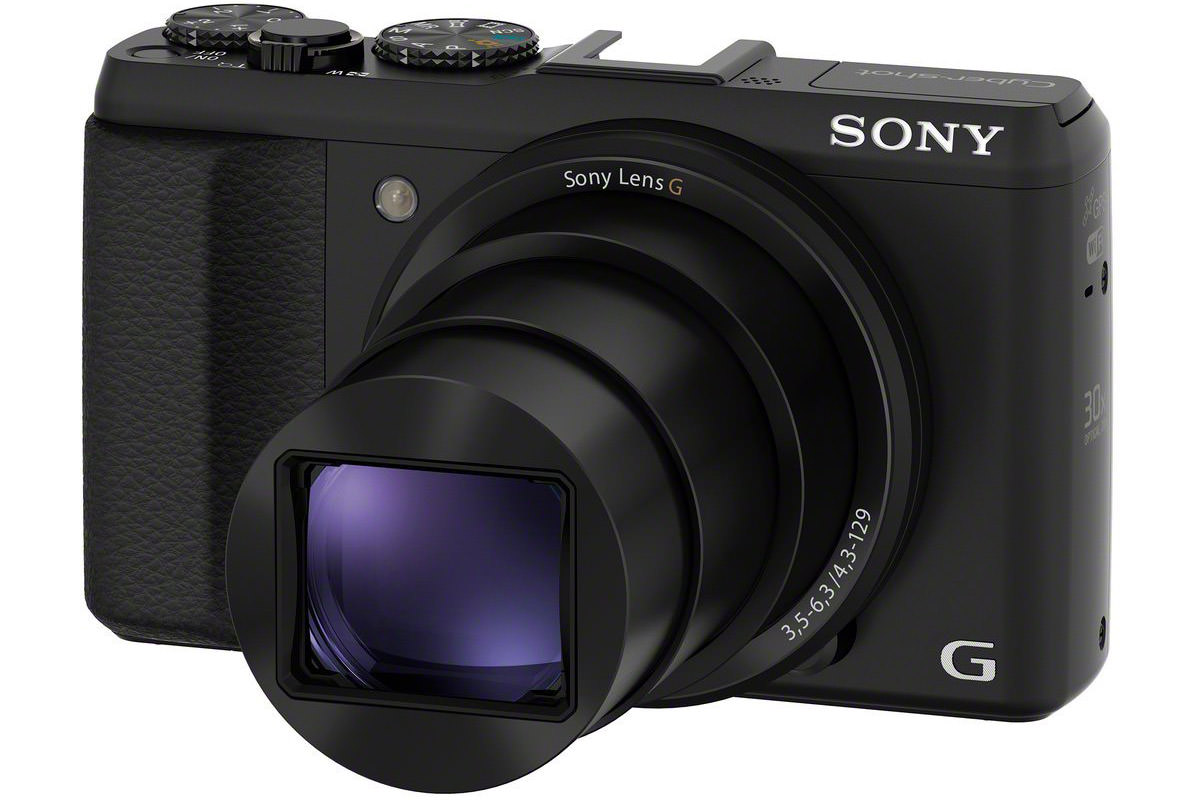
Turns out the image quality is quite nice (for JPEG) so long as you don't zoom too much, and the HX50V is a capable little shooter that I was happy to have on me for those times my camera bag was back at my tent. But ultimately I regretted my purchase for one big reason... no eyepiece viewfinder. The only way to compose a shot was to use the display on the back, which is completely obliterated in bright light! Under the African sun this camera was rendered totally useless. I couldn't see a damn thing to compose a shot, and was shooting blind any time I was out of the shade (even when setting the screen to max brightness). If you buy this camera, I hope you'll only be shooting indoors or in overcast conditions, because that's all its good for. Still, it DOES have a GPS... which is more than I can say for the much more expensive Sony's listed above. I took an occasional shot with this camera just so I could use the GPS info to geotag my other photos, and it worked pretty great for that... meriting an extra star.
20.4MP • 30x • ISO 80-3200 • f/3.5(W)-f/6.3(T) • $325 • ★★☆☆☆
• Sony FE 70-200 f/4 OSS E-Mount Lens. Go with a cheap zoom lens to get the reach you need... or go with a quality zoom lens and crop the reach you want? It's a question that every photographer has to grapple with at some time in their lives. In the past I've just gone for the cheapest zooms I could find because I don't use them very often. But for my Africa trip, I decided to invest heavily in a good zoom because the quality of the image was what's important to me... even if I wasn't as close as I'd like to be. And since Sony only makes one E-mount zoom with any reach to it, the FE 70-200mm, my decision was made for me. I reviewed the lens back in August, and have only one thing to add to this remarkable addition to my camera arsenal... WHY IN THE HELL DOESN'T SONY HAVE A SWITCH-LOCK ON THE IMAGE STABILIZATION SWITCH?!? Every time I slid this lens into my camera bag, image stabilization would slide off. So the next time I'd go to shoot a lion (or whatever) I'd end up with blurry camera shaken images until I'd remember to turn it back on. This is categorically stupid. At no time... none did I ever want the "Optical Steady Shot" turned off, yet there was no way to lock it in the "on" position. Very, vey frustrating. But, once I remembered to switch OSS on, I was getting some fantastic shots from this lens...
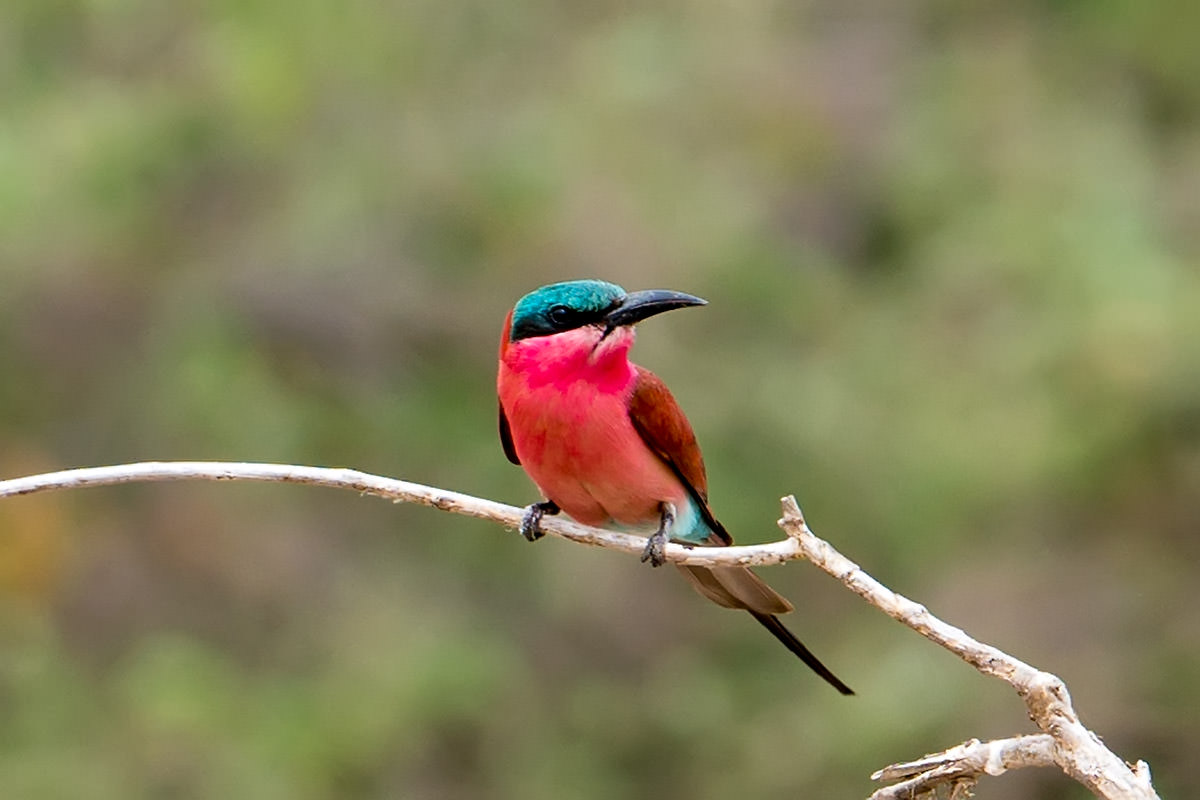
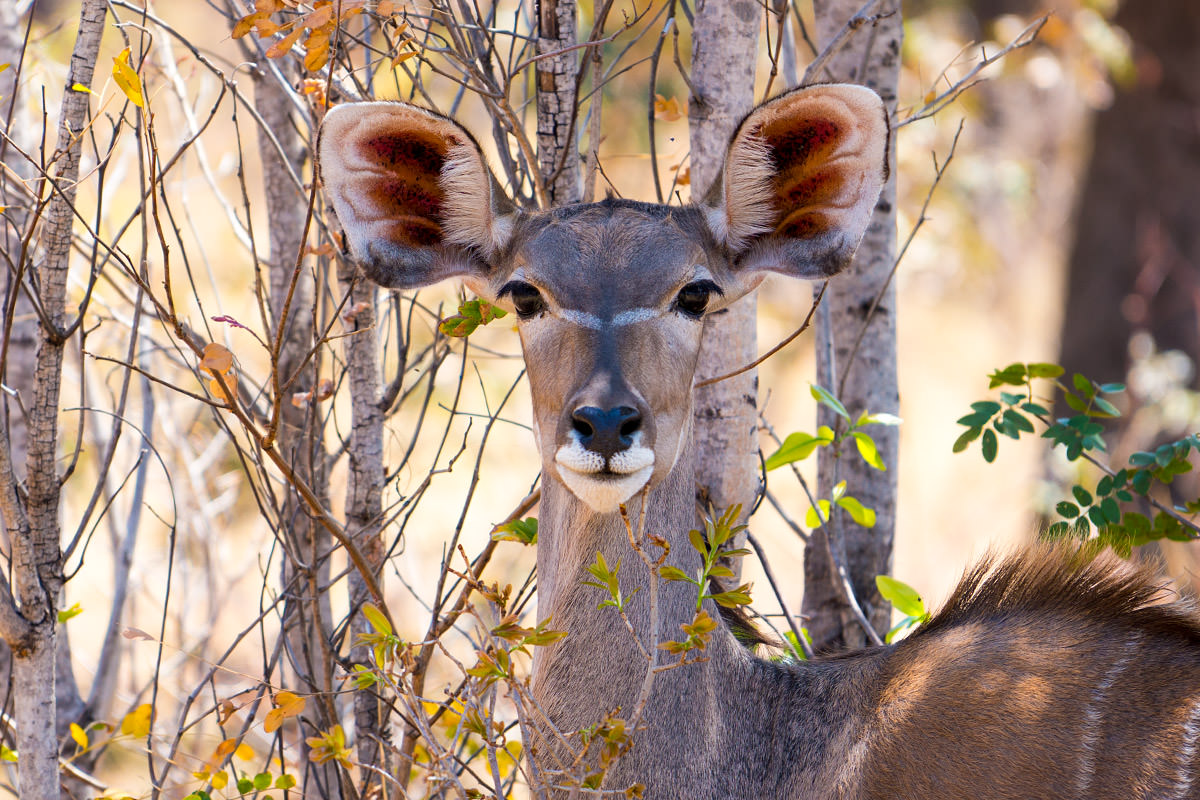
Sure it's big and at almost 2 pounds it's a bit heavy too... but you can't argue with the results. Crisp images, beautiful bokeh, fast auto-focus... I was very, very happy to have this full-frame wonder with me on safari, and was much relieved that I spent the money to have a quality telephoto in my camera bag. 90% of my photos were shot with it. Minus a star for the lack of an image stabilization switch lock... and for not having a bit better aperture (it's locked at a consistent f/4 though, which is nice)... but if you're an E-mount shooter, this is the zoom to get.
70-200mm (full-frame), 105-300mm (cropped) • f/4 • $1,499 • ★★★★☆
• Sony FE 35mm F/2.8 Carl Zeiss Sonnar T* E-Mount Lens. I skipped the kit lens for my A7s full-frame sensor camera because I wanted some glass that would really let it shine. Unfortunately, my choices were limited, because Sony doesn't have many options when it comes to FE prime lenses. Ideally, I wanted a 35mm with image stabilization and a maximum aperture of f/1.4... but it doesn't exist. A 35mm with NO image stabilization and a pokey f/2.8 aperture is as close as I can get. And, to make matters worse, Sony is charging a whopping $800 for it. In all honesty, I don't think the Zeiss name justifies such a heinous price tag, but what choice do I have? None at all. Yet despite the absurd cost, this lens has a lot going for it. It's small and light. It focuses blazingly fast. It's super-sharp. Color is very good. And I got some really nice shots with it...
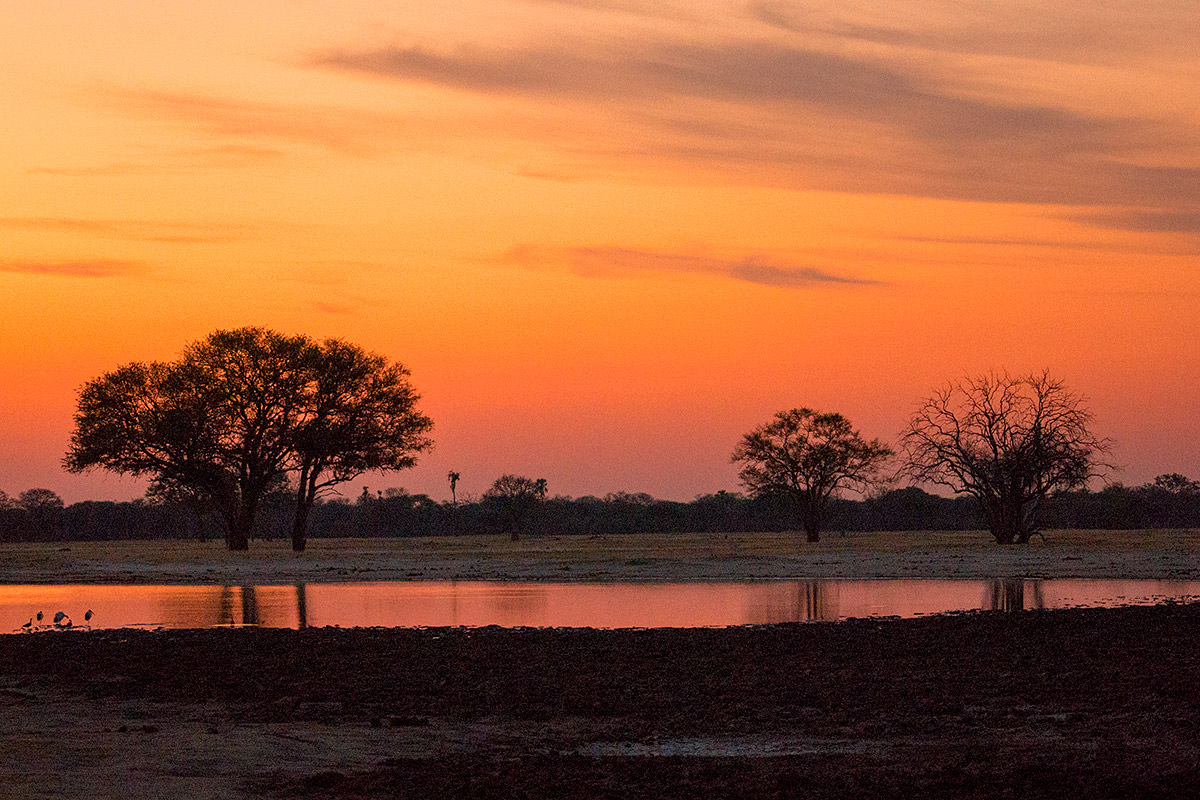
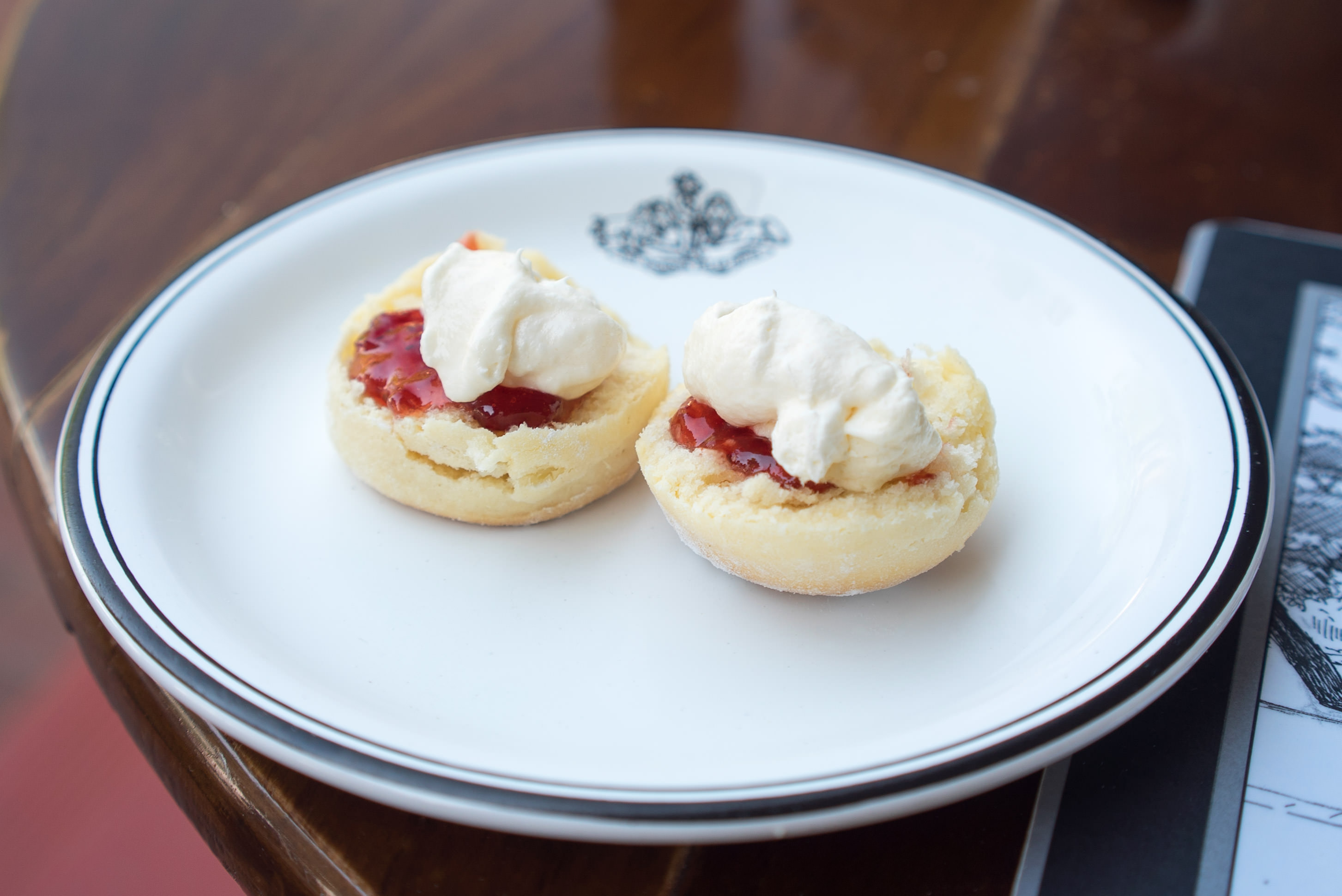
Night sky images were mind-bogglingly great...
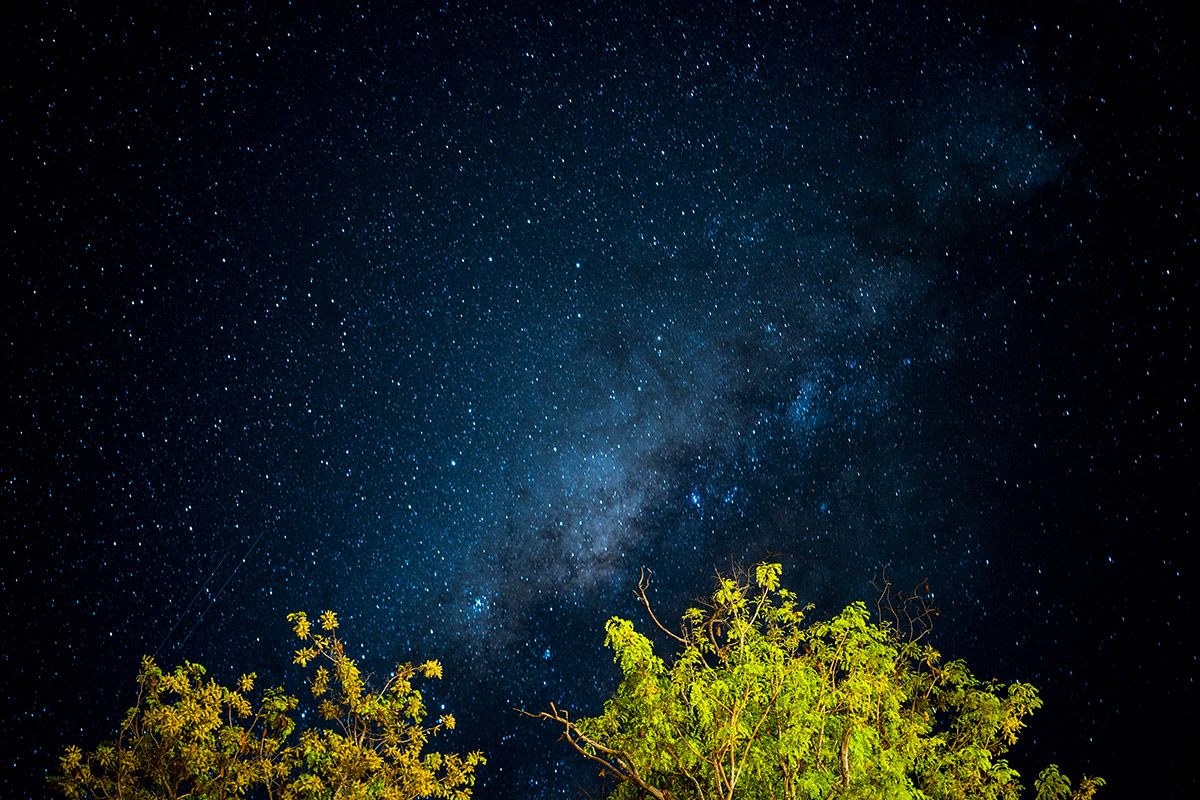
The slow aperture was never a problem on my NEX-6 in the sunlight nor on my A7s with its amazing low-light capabilities, but I still find it disappointing... f/2.8 on a 35mm? Who does that any more? This, along with the crazy-stupid price tag drops two stars from my rating, even though the FE 35mm is a darn fine lens once all is said and done. And yet... I keep coming back to the cost. EIGHT HUNDRED DOLLARS?!? For THESE specs? Holy crap I hope Sony gets their heads out of their asses and starts producing affordable FE lenses soon.
35mm (full-frame), 50mm (cropped) • f/2.8 • $799 • ★★★☆☆
• Sony 10-18mm f/4 OSS E-Mount Lens. I shoot a lot of wide angle, so this lens was purchased alongside my NEX-6 on day one. I absolutely love it. Small and light for a wide angle. Really sharp. Great color. Quick to focus. Image stabilized. And all at a reasonable cost! As if that weren't enough... even though it was designed for the cropped sensor on Sony's NEX cameras, it works amazingly well on my full-frame A7s if you limit the focal range! Amazing! This lens fulfills the promise of mirrorless cameras, and proves Sony doesn't need Zeiss (or Zeiss' absurd price tag) to give their customers a great lens. And though I didn't get much use out of it in Africa, it's the one lens that's always in my camera bag...
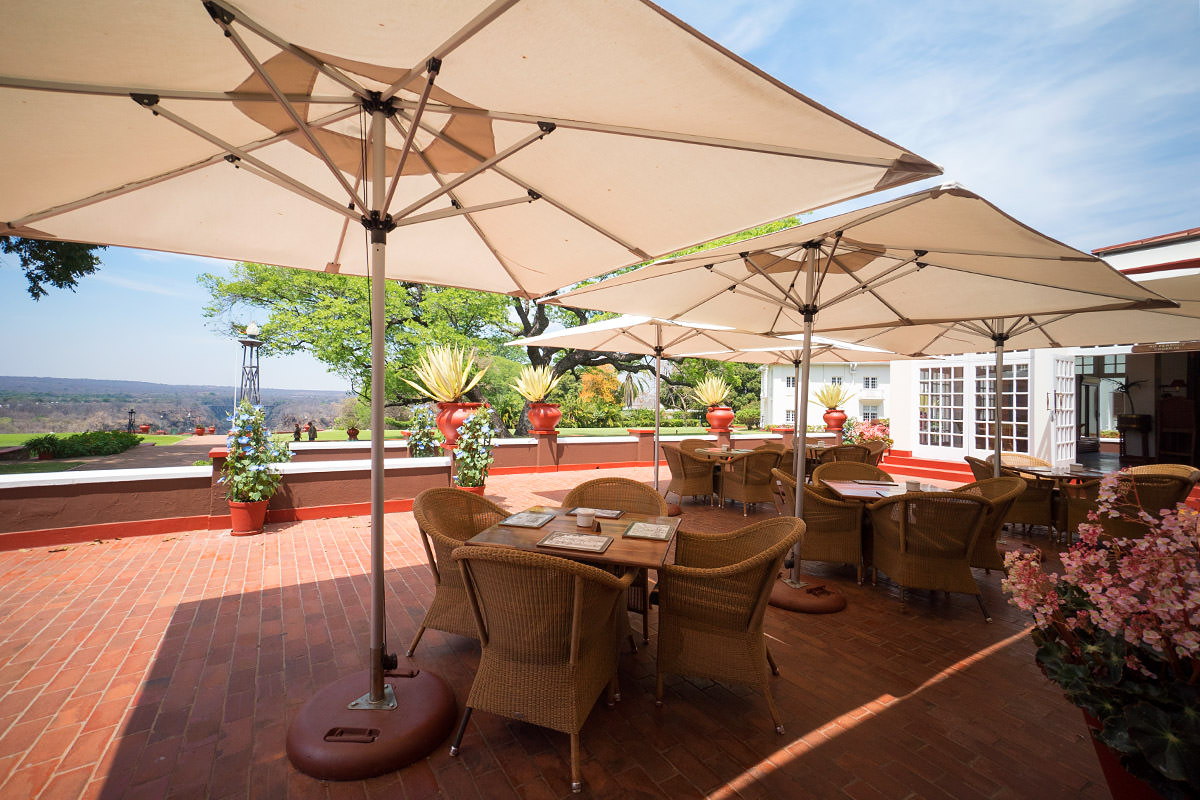
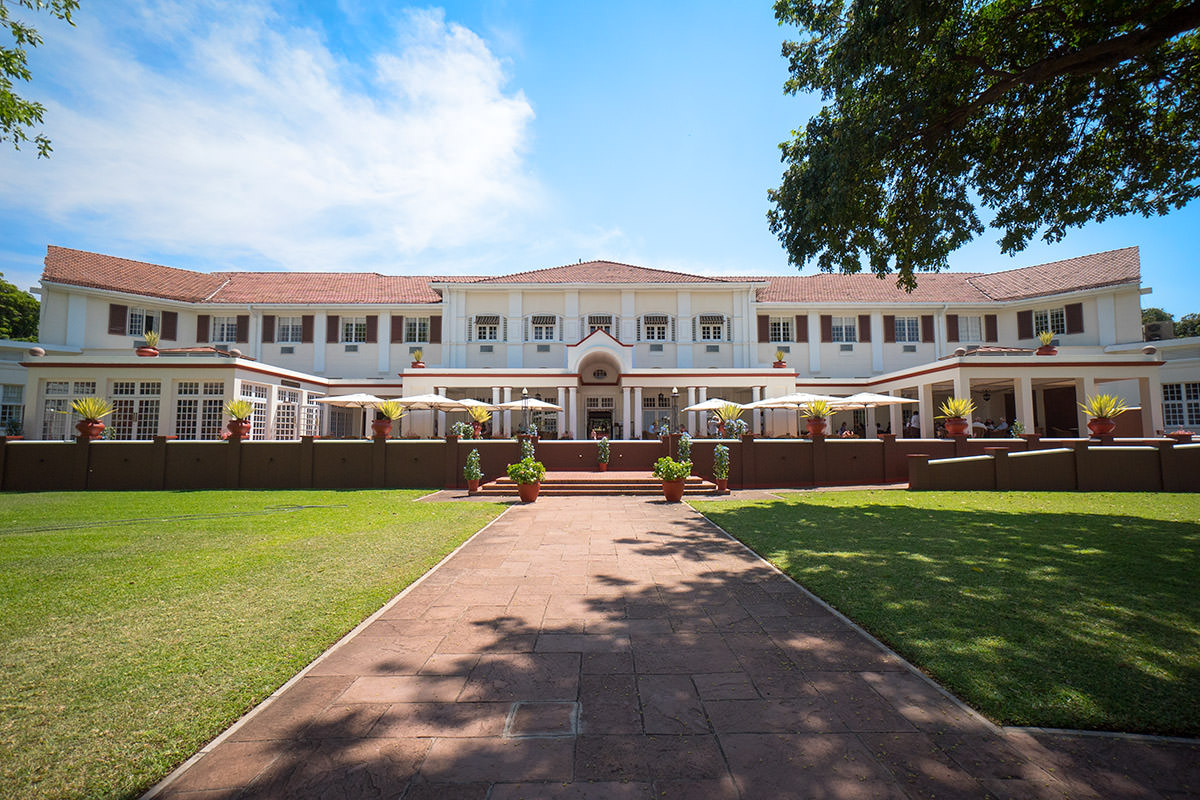
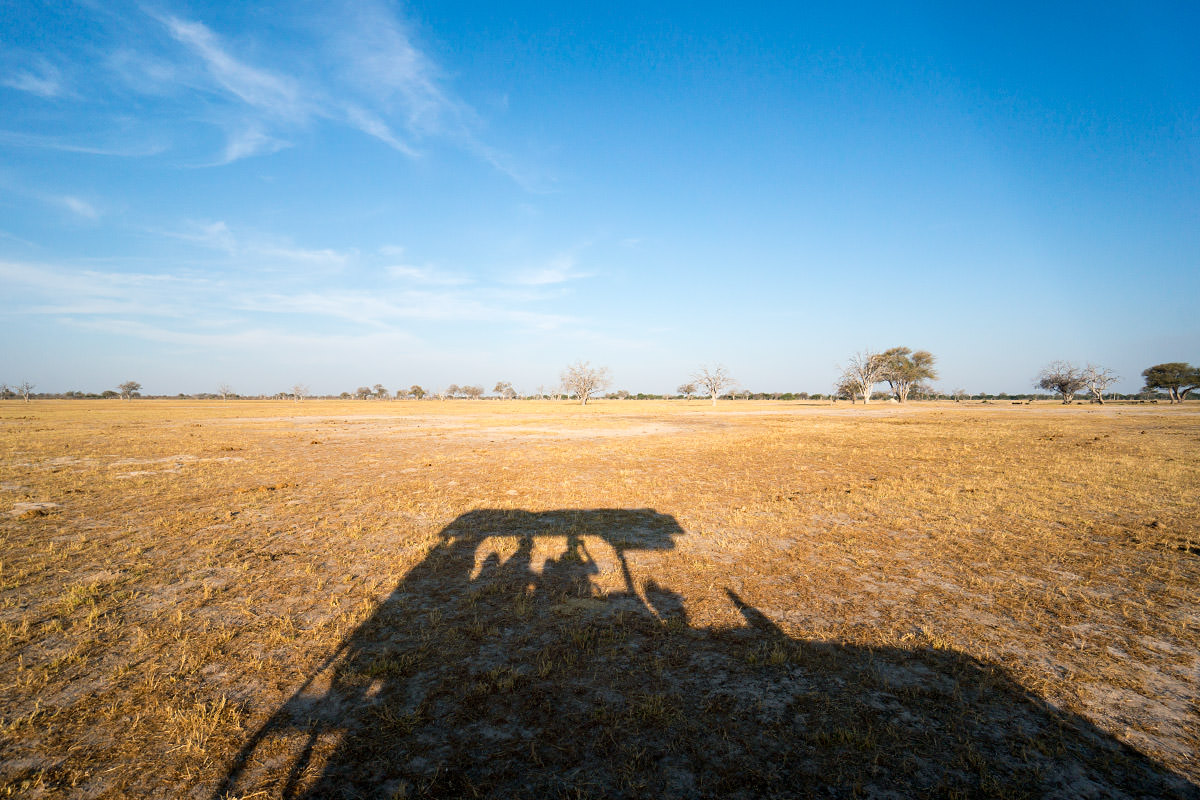
If you've got an E-mount camera, this is the lens to own. Fantastic for landscapes, yes... but I use it all the time for just about everything (the wide angle distortion is very easy to correct in Photoshop). Thank you, Sony.
10-18mm (cropped) • f/4-f/22 • $849 • ★★★★★
• Apple 11-inch MacBook Air. I'm using an iPad more and more for things like email and web browsing, but when it comes to photography, there's simply no substitute for Photoshop on a Mac. My MacBook Pro excels at running Photoshop, but is way too big and heavy to tuck in a camera bag. Fortunately, Apple has a diminutive solution that tucks easily in my bag, and it runs Photoshop just fine thanks to the 8GB memory option...

Until Microsoft manages to come up with a "Surface" tablet/PC hybrid that's worth a crap... or Apple comes up with a MacBook Air that has a retina display touchscreen I can give five stars... this will certainly do.
1.7GHz i7 • 8GB RAM • 256GB SSD • $1,250 • ★★★★☆
• Transcend Information USB 3.0 Card Reader. Unfortunately, there wasn't enough room in the MacBook Air 11-inch model to fit a card reader, so you need to buy an external one. This Transcend model takes advantage of the USB 3 speed of my MacBook and accepts SDHC, SDXC, microSD, microSDHC, and microSDXC cards. Cheap, compact, and does the job. If they could remove the micro card compatibility (that I'll never use) to shrink it even further, I'd give it five stars.
$7 • ★★★★☆
• B+W Kaesemann XS-Pro Circular Polarizer. I have UV haze filters on all my lenses to protect the optics, but I stopped using "creative" filters ages ago. Between in-camera functions and Photoshop, I just don't need them. But every once in a while, it's handy to have a circular polarizer in your bag. B+W makes my favorite filters... pricey, but high-quality, so all I had to decide was whether or not I would go with the Kaesemann variant or not. Ultimately I went with Kaesemann, despite the added cost, because they don't "gray things up" like a traditional polarizer can. The only time I ended up using the thing in Africa was when I was shooting through a helicopter window...
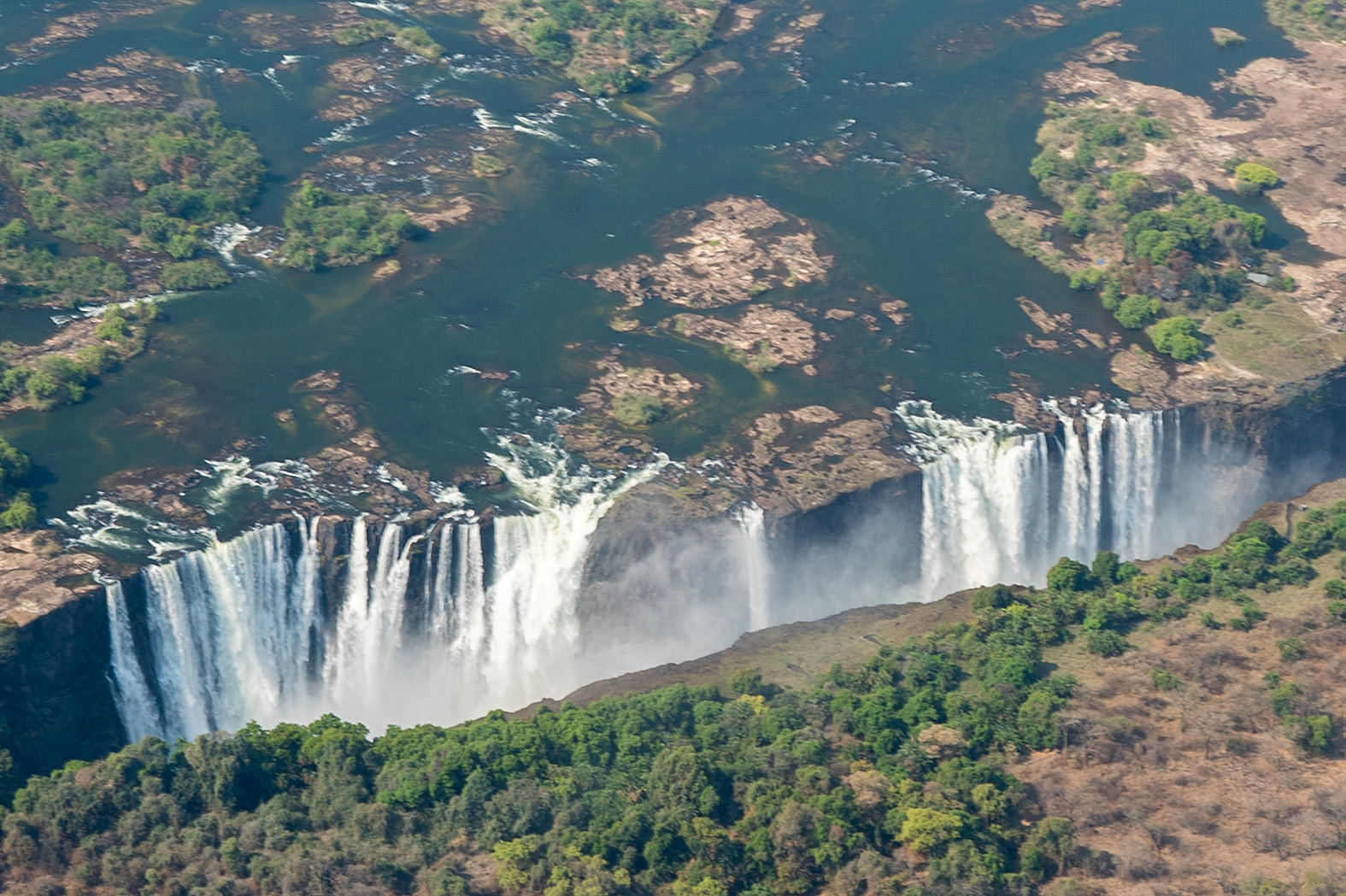
It helped take the glare of the sun off the water, which was nice, but the shake of the copter coupled with the lack of image stabilization on my lens kinda sabotaged my efforts to get great shots. Oh well.
Kaesemann XS-Pro, MRC Nano Filter • $89 • ★★★★★
• VisibleDust Hurricane Blower. Dust and moisture are the enemy of photographers who rely on clean, dry optics to get the best image quality. Having a blower on-hand is essential, and I was using it several times a day while in Africa. At home I have a Giottos Rocket Blaster, but I wanted something a bit smaller to take with me, so the VisibleDust Hurricane got the job. Works great.
$14 • ★★★★★
• LensPen Lens Cleaner. The only lens cleaner I use. Has a good quality brush on one end and a concave lens swab coated with a carbon compound (from the lid) on the other. Works perfectly every time.
$10 • ★★★★★
• SanDisk 32GB Extreme Plus UHS-1 SDHC Class 10 Memory Cards. It took me a while to settle on a memory card manufacturer I like best, but once I got my hands on the SanDisk Extreme Plus line my camera storage of choice was found. They're tough, reliable, and blazingly fast... yet don't break the bank. Which is good, because I've stopped re-using memory cards. They're small size makes them all too easy to slip into a safe deposit box, thus providing the perfect backup of your precious memories. Sure you can save money by going with a cheaper card, but is it worth taking the chance something will go wrong and you'll lose all your photos? Not to me. There's higher-capacity versions of the Extreme Plus, but 32GB stores more photos than I can manage as it is, so I don't want to go bigger.
$38 • ★★★★★
• Oben TT-100 Table-Top Tripod. This tiny tripod slips easily into my camera bag, but still manages to secure my camera perfectly. Unlike some smaller tripods, the Oben has a ball head which made it really handy to get the perfect angle for a shot. A great product... I just wish it was a bit easier to tighten and manipulate.
$35 • ★★★★☆
Add some extra camera batteries, a couple of battery chargers, a ballpoint pen, a Sharpie marker, and some unscented wipes to keep everything clean, and I'm done!
As for what camera bag I use? That's another story...
 I woke up confused this morning because everything was silent... no hippos grunting or baboons screeching. That should have made me happy, but I felt quite sad about it. My vacation is pretty much over now, and this is my last day. Guess I should probably try to make the most of it.
I woke up confused this morning because everything was silent... no hippos grunting or baboons screeching. That should have made me happy, but I felt quite sad about it. My vacation is pretty much over now, and this is my last day. Guess I should probably try to make the most of it.
I was not going to go all the way to Zimbabwe without visiting Mosi-oa-Tunya, better known as "Victoria Falls." As the largest waterfall in the world, you pretty much have to, right?
While it is neither the highest nor the widest waterfall in the world, Victoria Falls is classified as the largest, based on its width of 1,708 metres (5,604 ft) and height of 108 metres (354 ft), resulting in the world's largest sheet of falling water. Victoria Falls is roughly twice the height of North America's Niagara Falls and well over twice the width of its Horseshoe Falls. In height and width Victoria Falls is rivaled only by Argentina and Brazil's Iguazu Falls.
Of course, all those facts and figures only apply to Victoria Falls in the wet season when the falls are at their peak volume, whereas I'm visiting during the dry season when the falls are at their weakest. At first I was worried that it wouldn't be worth the trip because the water would be dried up to a trickle, but I was assured this is actually the best time to see the falls... if you're here in the wet season, you can barely see them because everything is shrouded in mist.
So off I went on my guided tour.
Which starts off with a statue of David Livingstone (I presume!)... who discovered the falls. And by "discovered" I mean "was the first European to see them"...
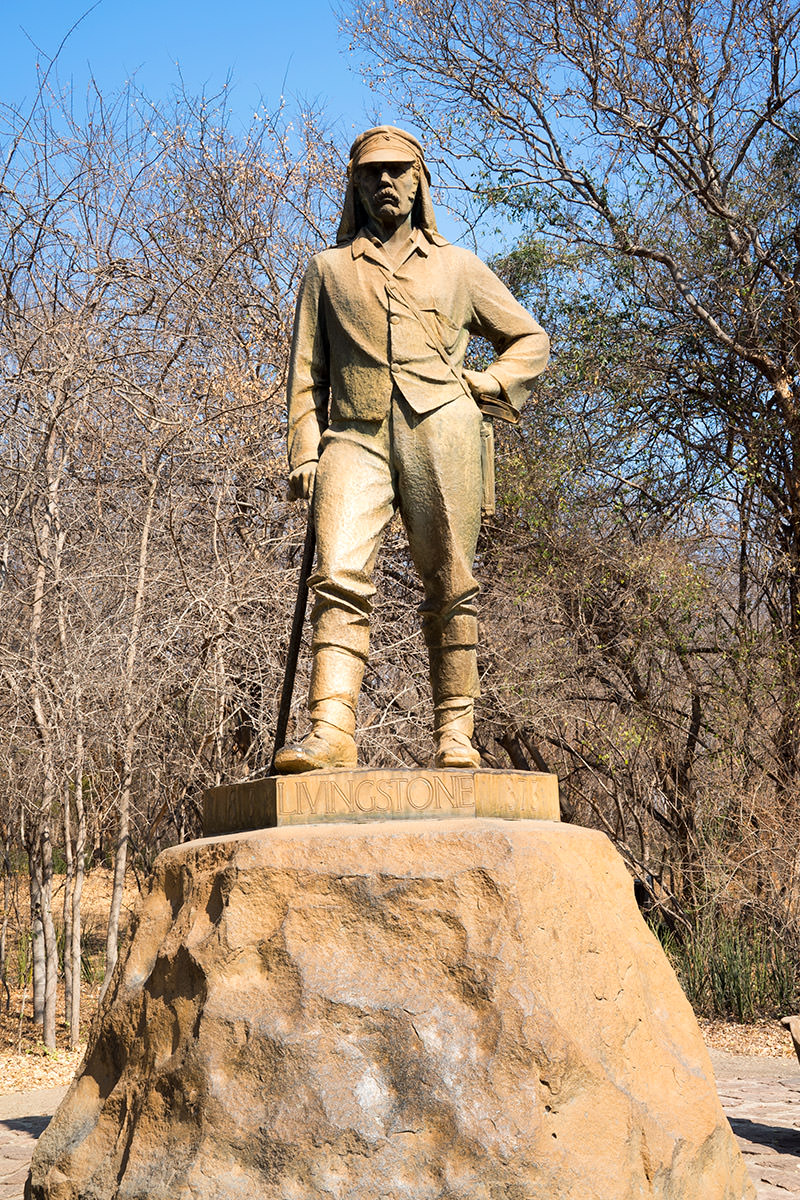
Just like America being "discovered" by Columbus and Angkor being "discovered" by Mouhot, it doesn't count as a discovery unless you're the one writing the history books, I suppose.
Turns out the falls are so huge that you can't actually see the whole thing on the ground. Instead you have to view it in sections.
First up... the Devil's Cataract...

This section of the falls is active all year and is the most impressive spot during the dry season. If you walk around the end of the chasm, there's a lookout where you can see the Main Falls starting off in the distance...
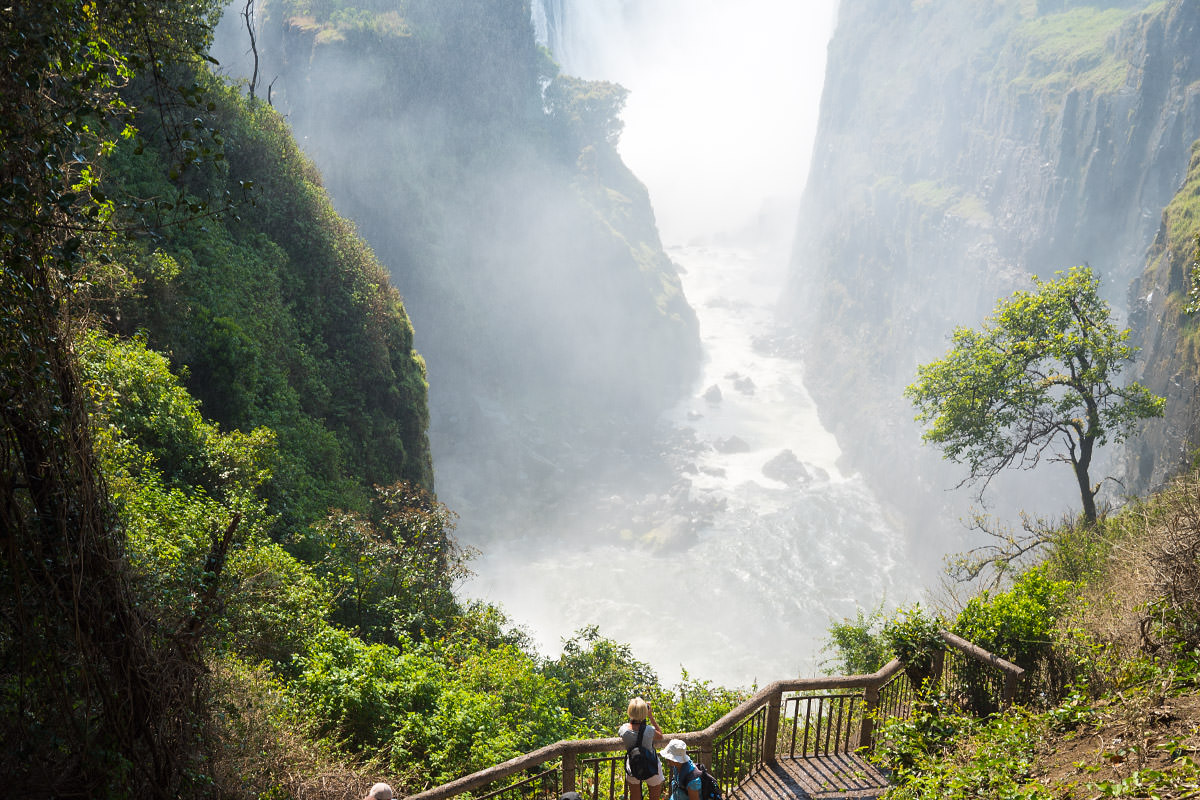
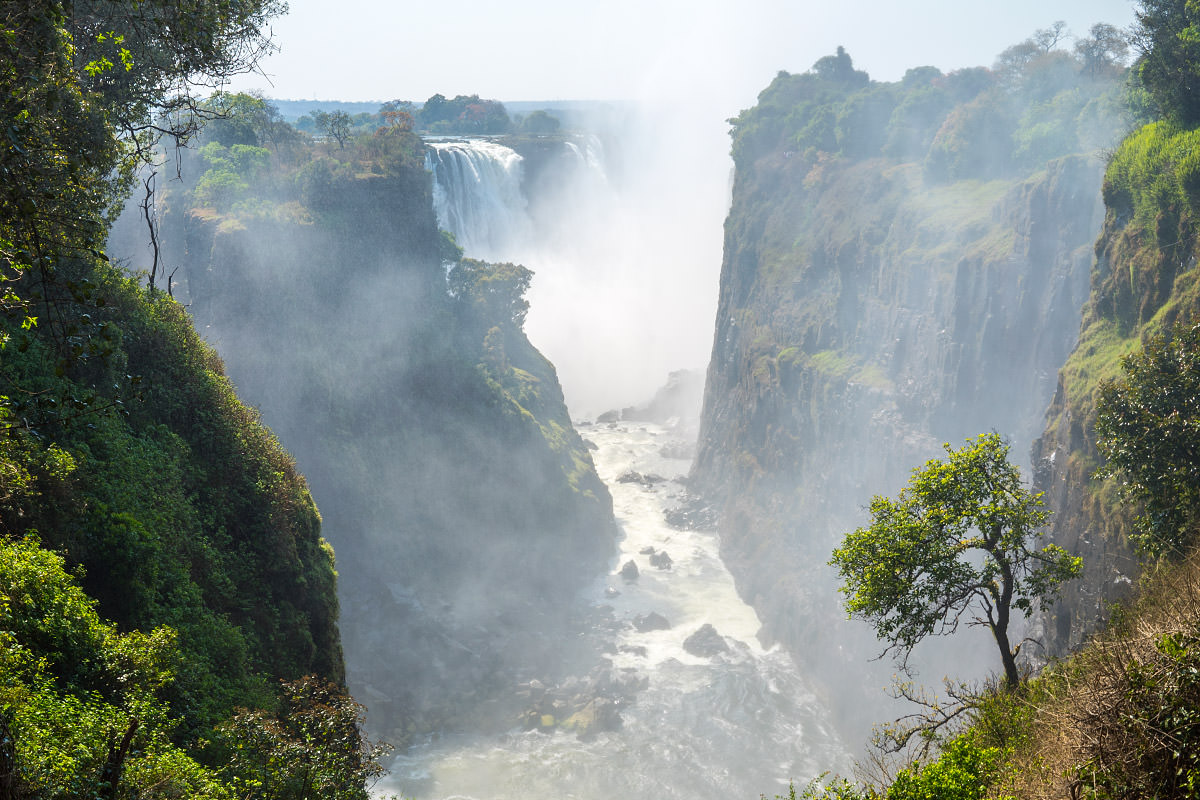
Looking back at the Devil's Cataract, I spotted my first rainbow of the day...
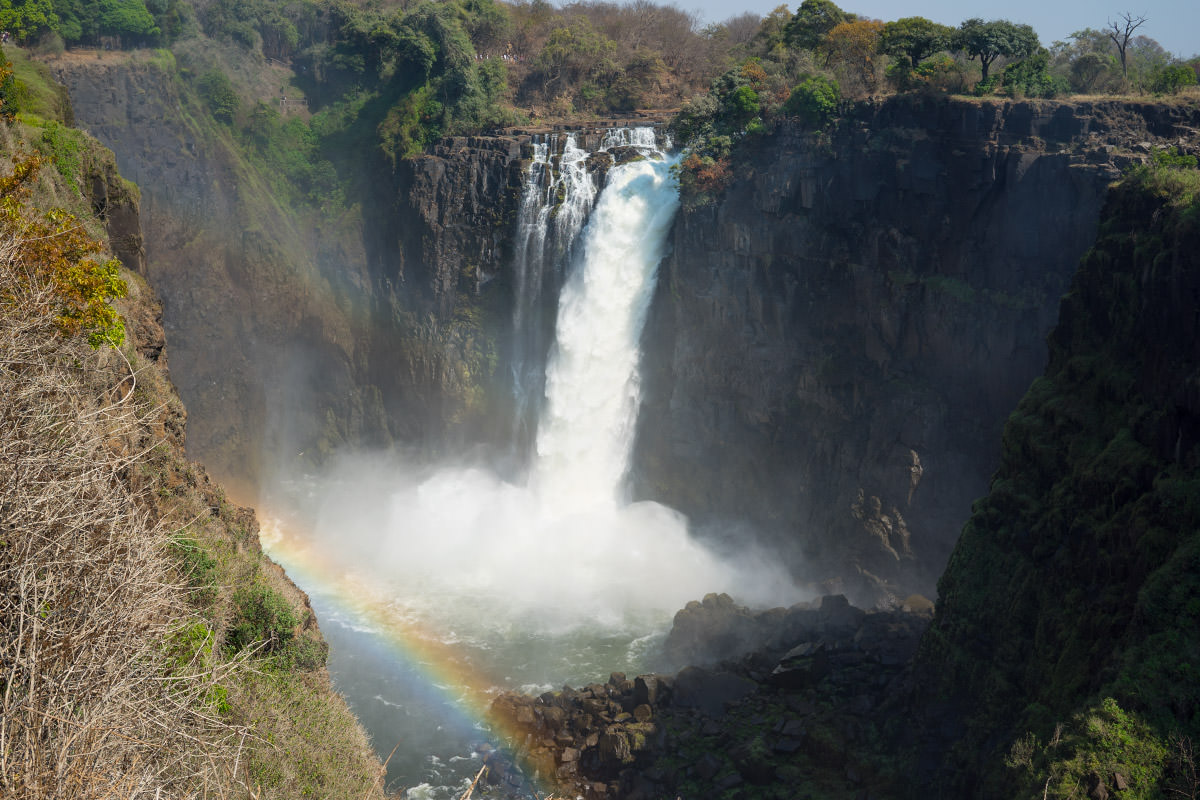
Next up... the Main Falls, which are also active all year. If it were the wet season, you wouldn't be able to see any rock at all, just gushing water and mist...
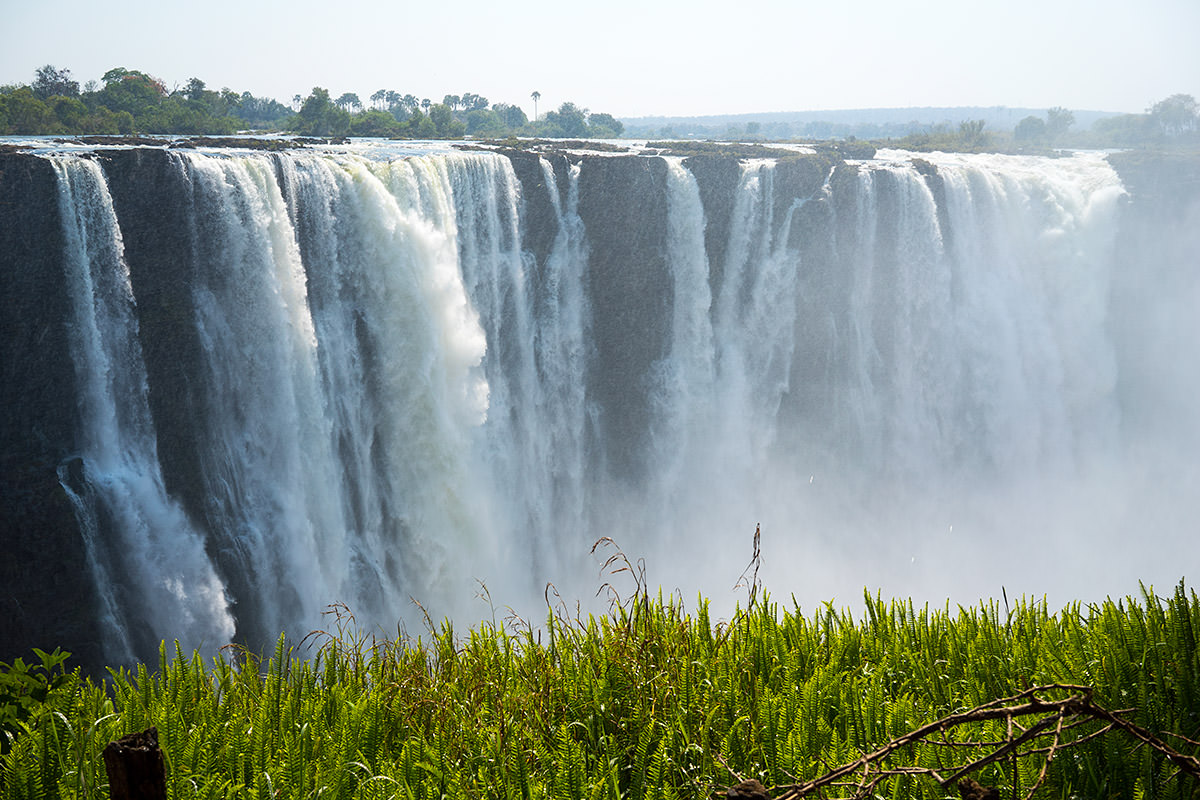
Continuing on along Main Falls...
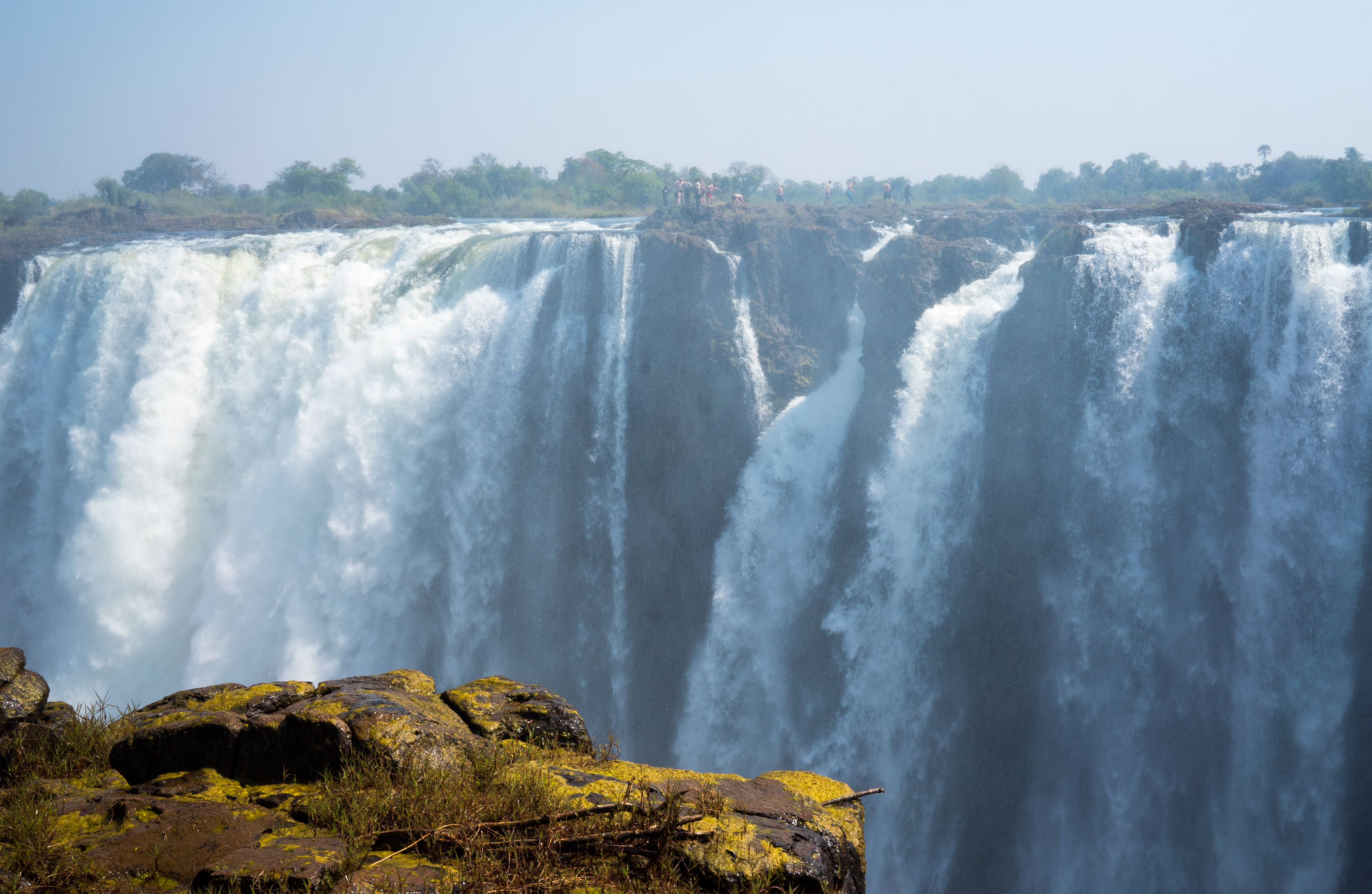
And here's where things get interesting. If you look at the top of the falls in the middle of the photo above, you'll see people standing on a rock outlook. They are there to take a dip in The Devil's Pool, which is a spot at the top of the falls where the rock formation creates a naturally-occurring dead spot in the current. When I tried to photograph these insane people, all I could see was mist... but after a few minutes in Photoshop...

Though it's actually more impressive if you pull back a bit...
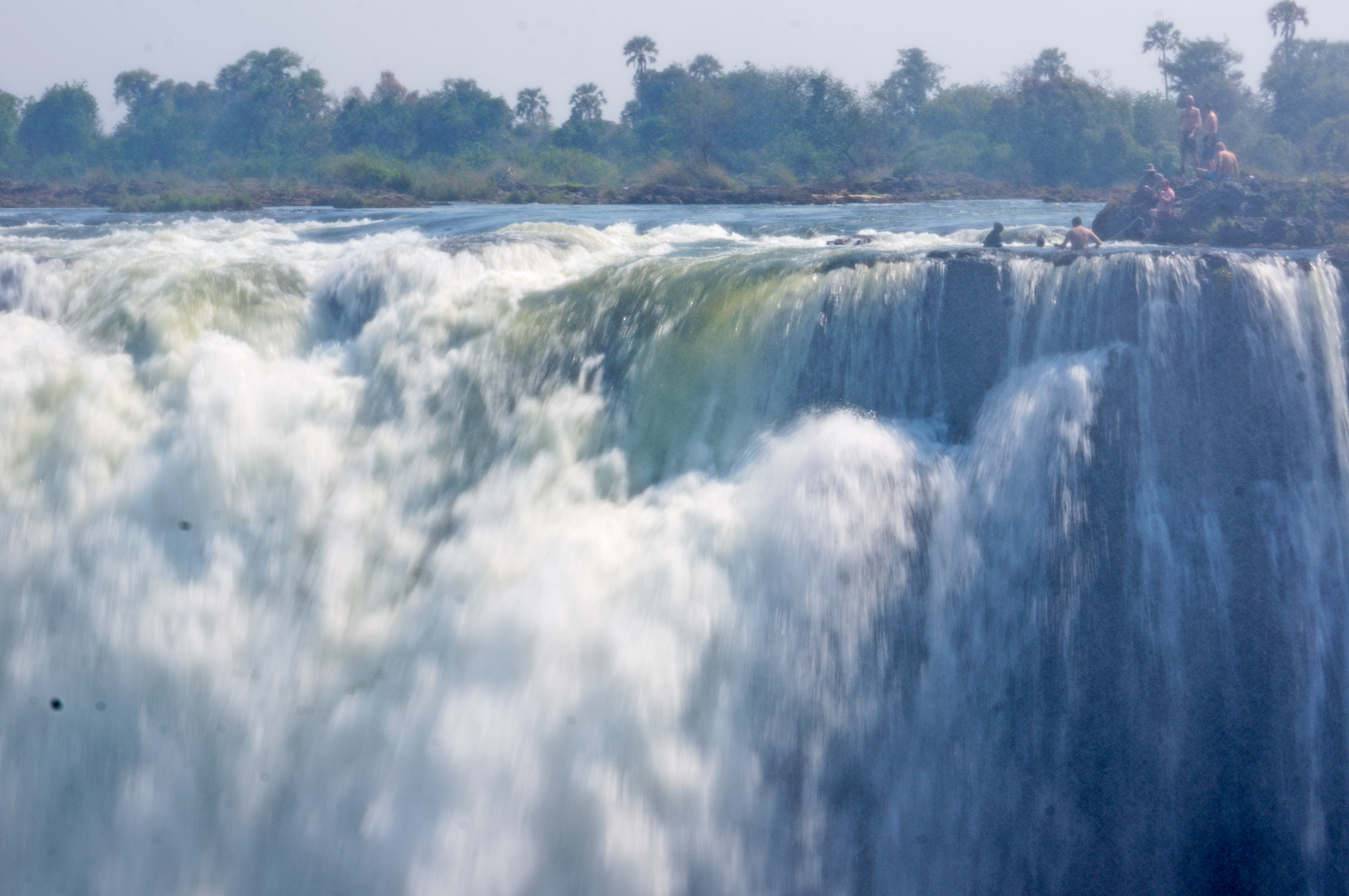
WTF?!? There have been people who have gone over the falls and died attempting this, so... yikes.
Anyway...
Here is my attempt to capture as big a chunk of the Main Falls as possible...

And that's about it for the falls, as everything else is pretty much dried up this time of year. Here's Horseshoe Falls...
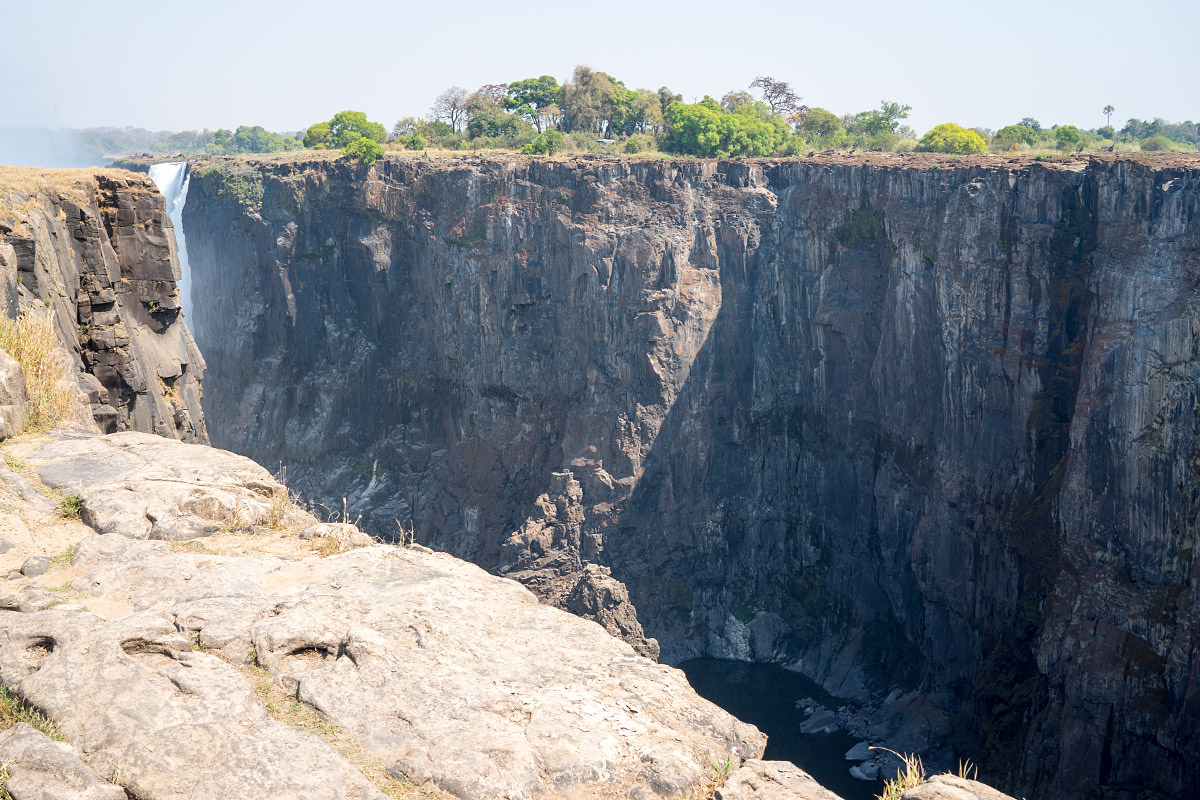
Just a "trickle" (comparatively speaking) at the end...
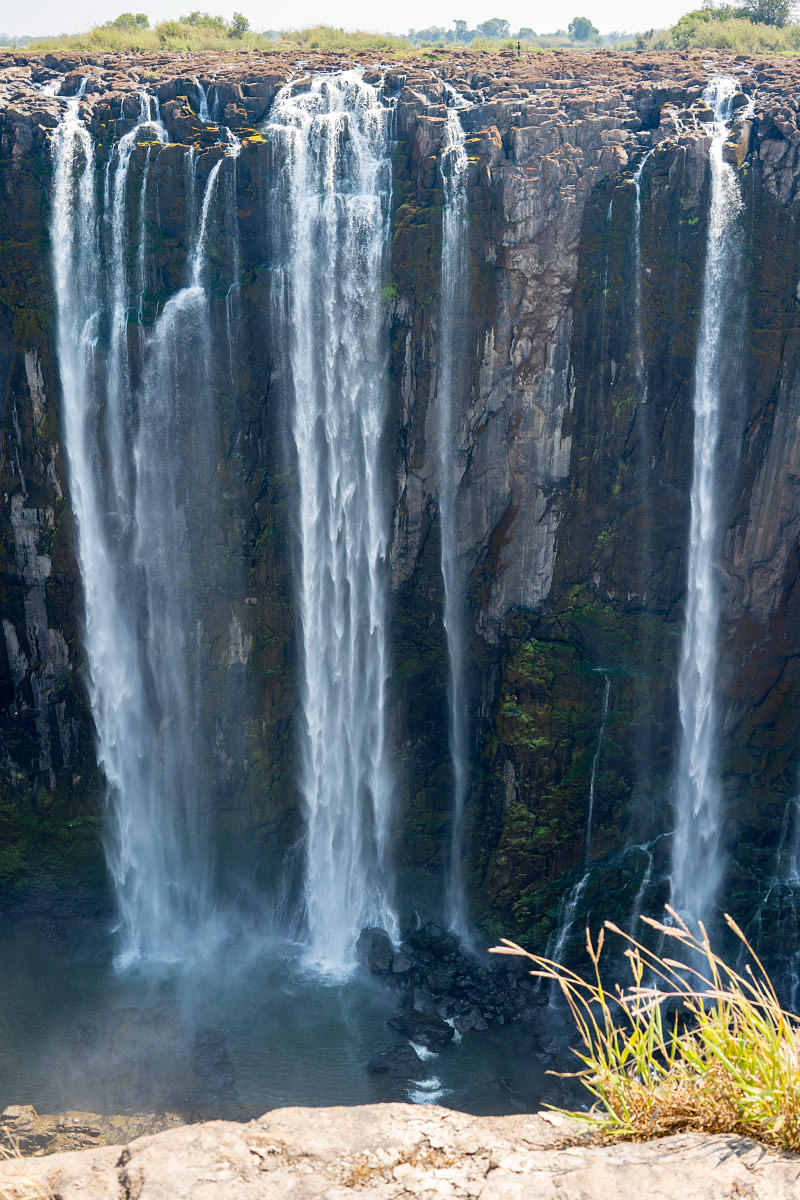
Rainbow Falls is also mostly dried up, but still pretty...
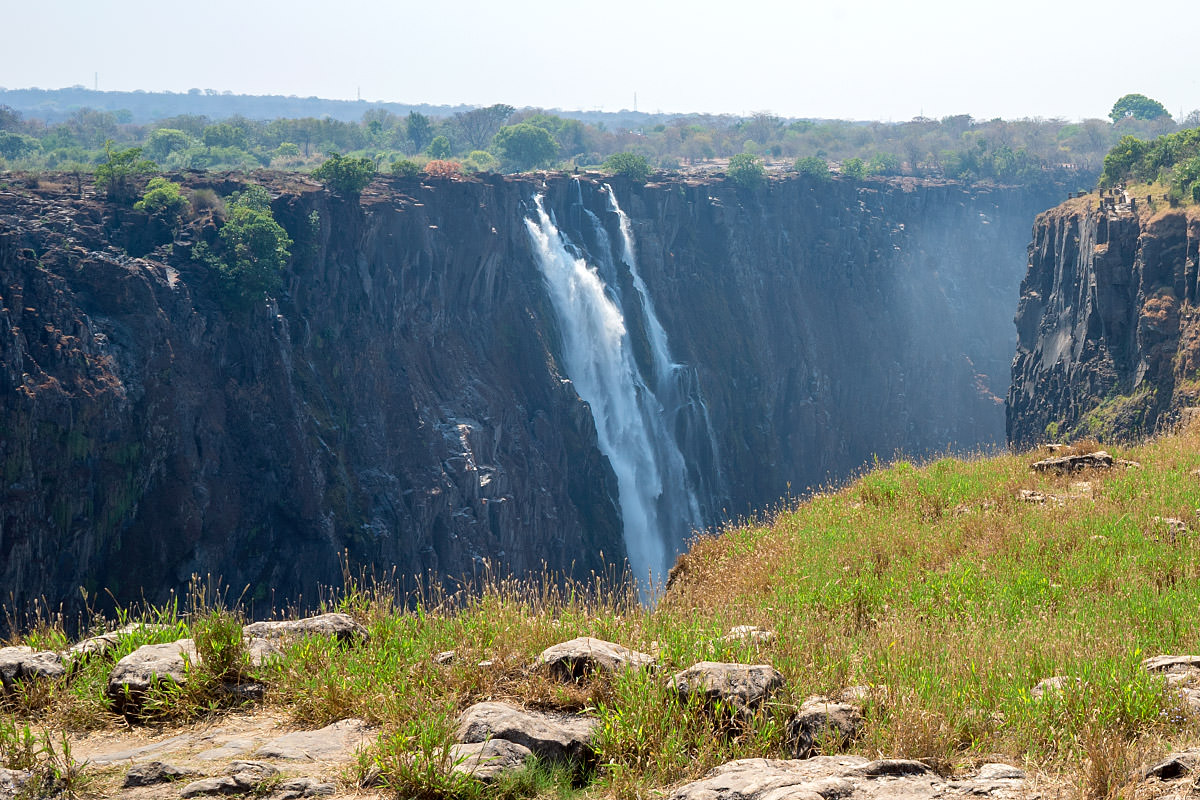
Once you get to the end of the falls, you can walk around a corner and get a terrific view of the Victoria Falls Bridge which links Zimbabwe and Zambia. It looks like it's in the middle of being painted just now...
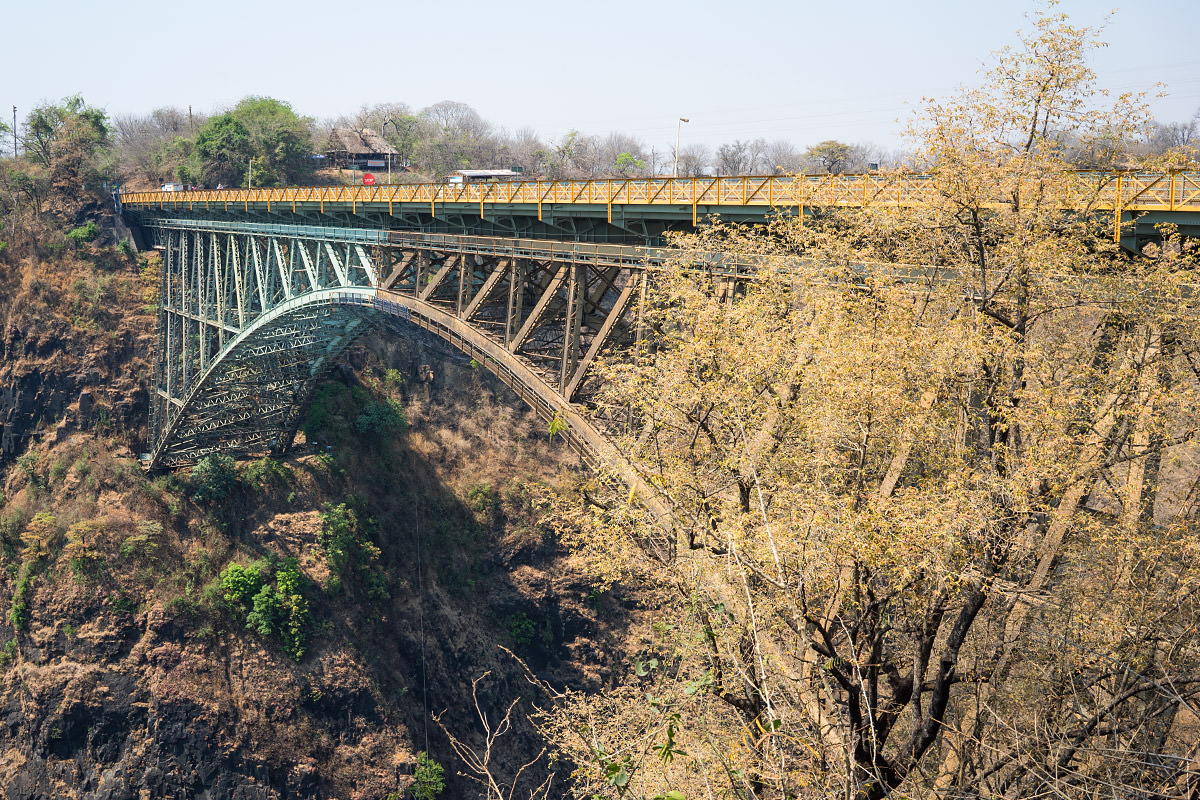
Despite my best efforts, I wasn't very happy with my photos of the falls. Even with Photoshop magic, the mist was always messing with the images by making them look faded and blurry. And this is the dry season! I can only guess how impossible they must be to photograph in the wet season!
That's when my guide said that the only way to truly photograph the falls was from the air. And, lucky me, she just happened to know where I could book a helicopter ride and reservations were made.
While I waited for my arial view of the falls, I walked downtown and had some lunch...
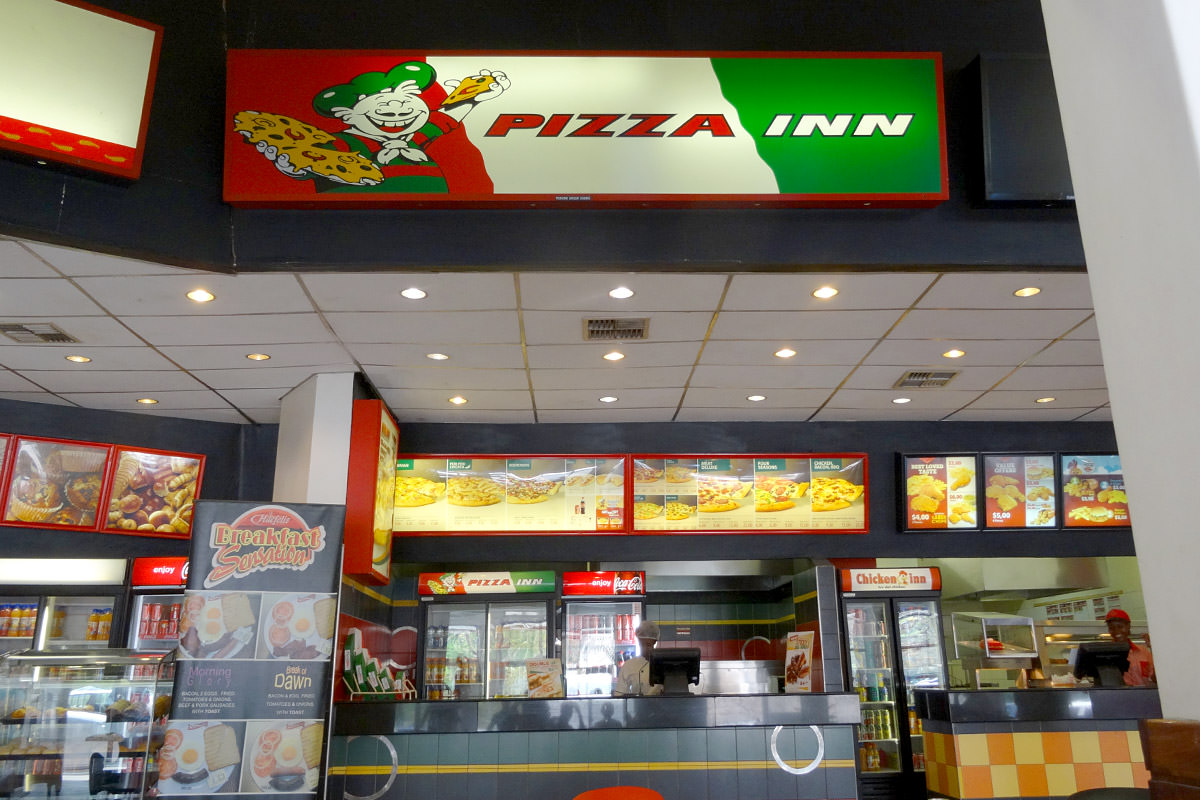
After that? Helicopter time!
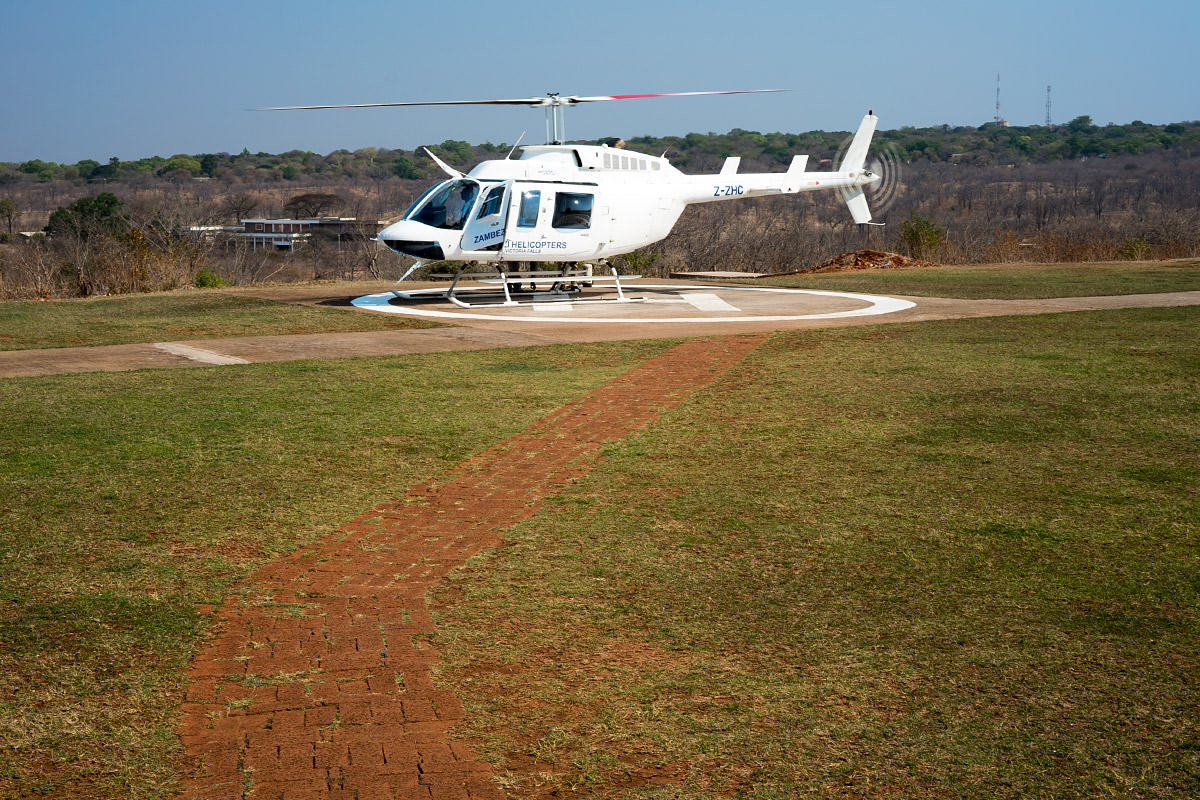
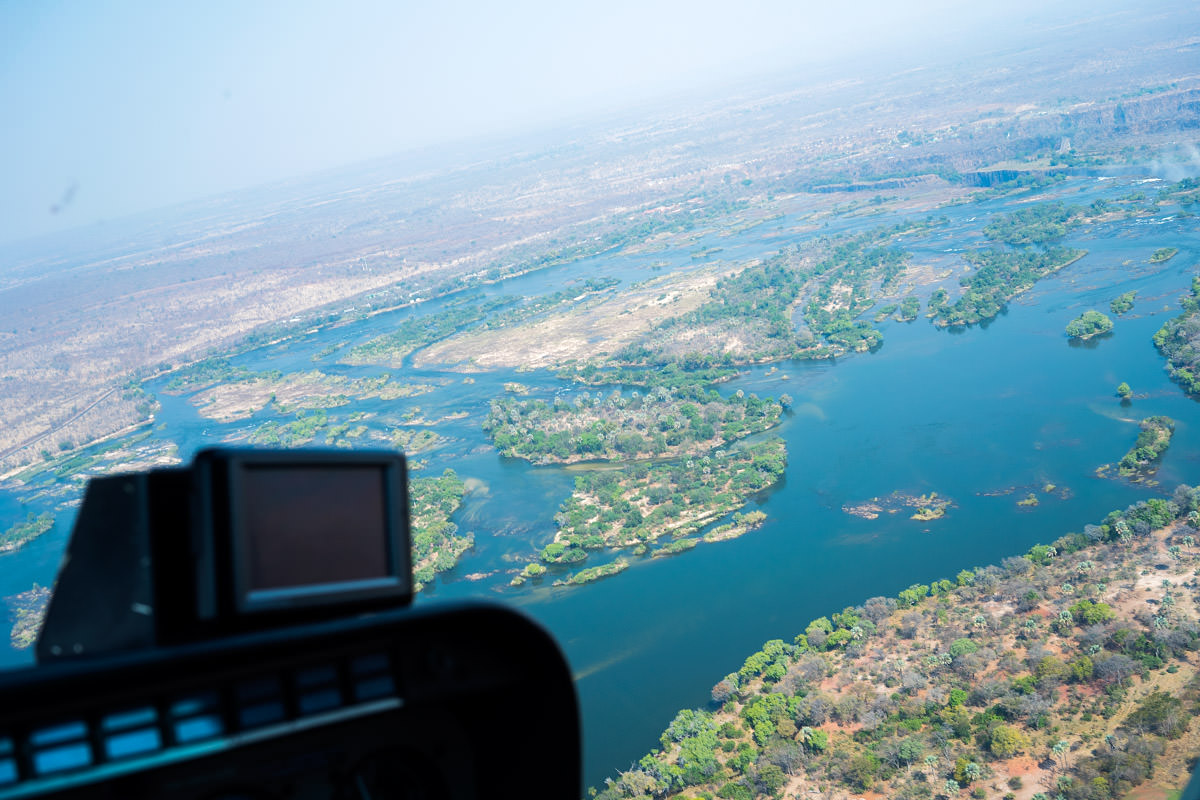
At $140 it was definitely more than I wanted to pay, but I have to say it was totally worth it...
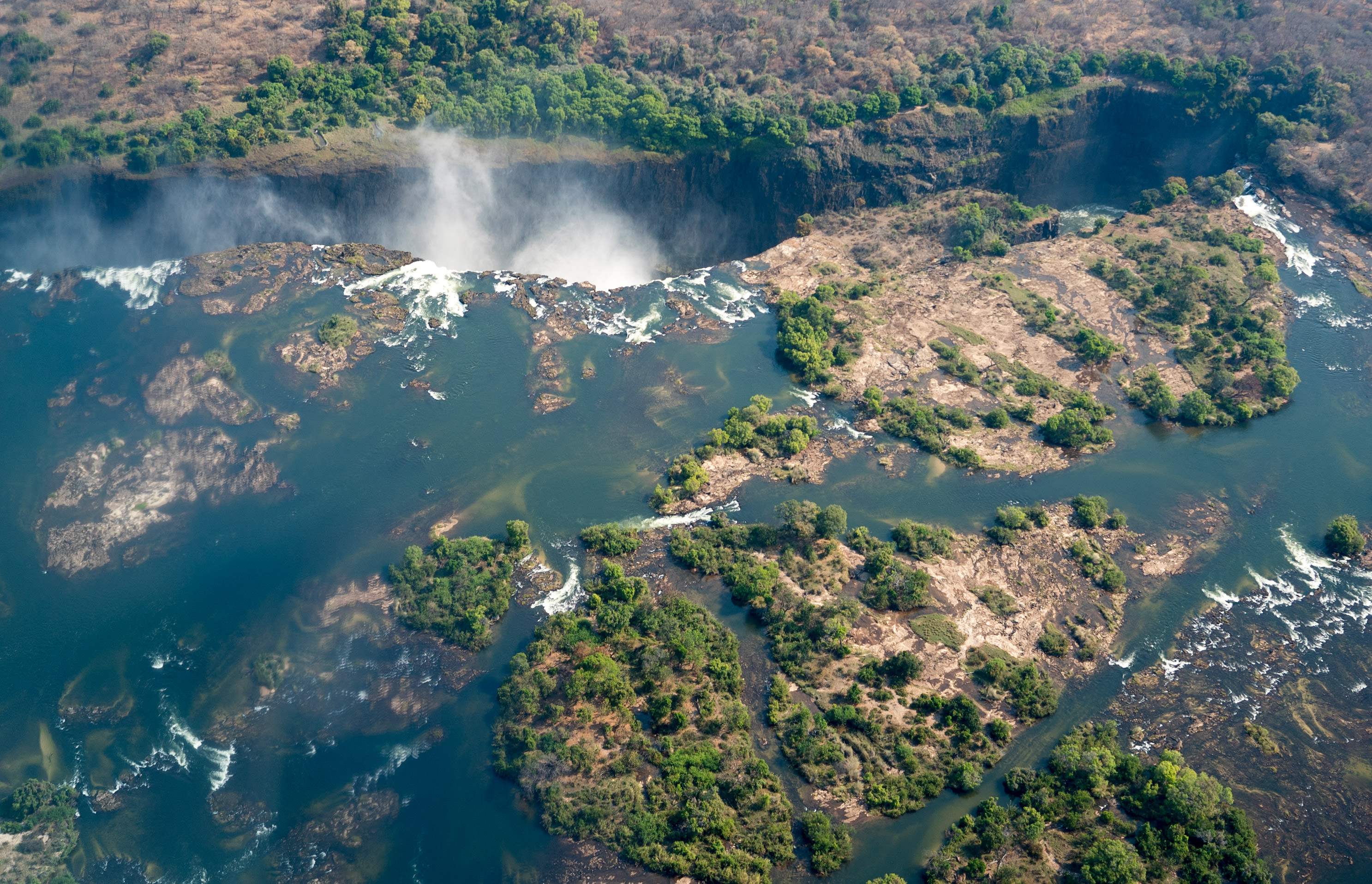
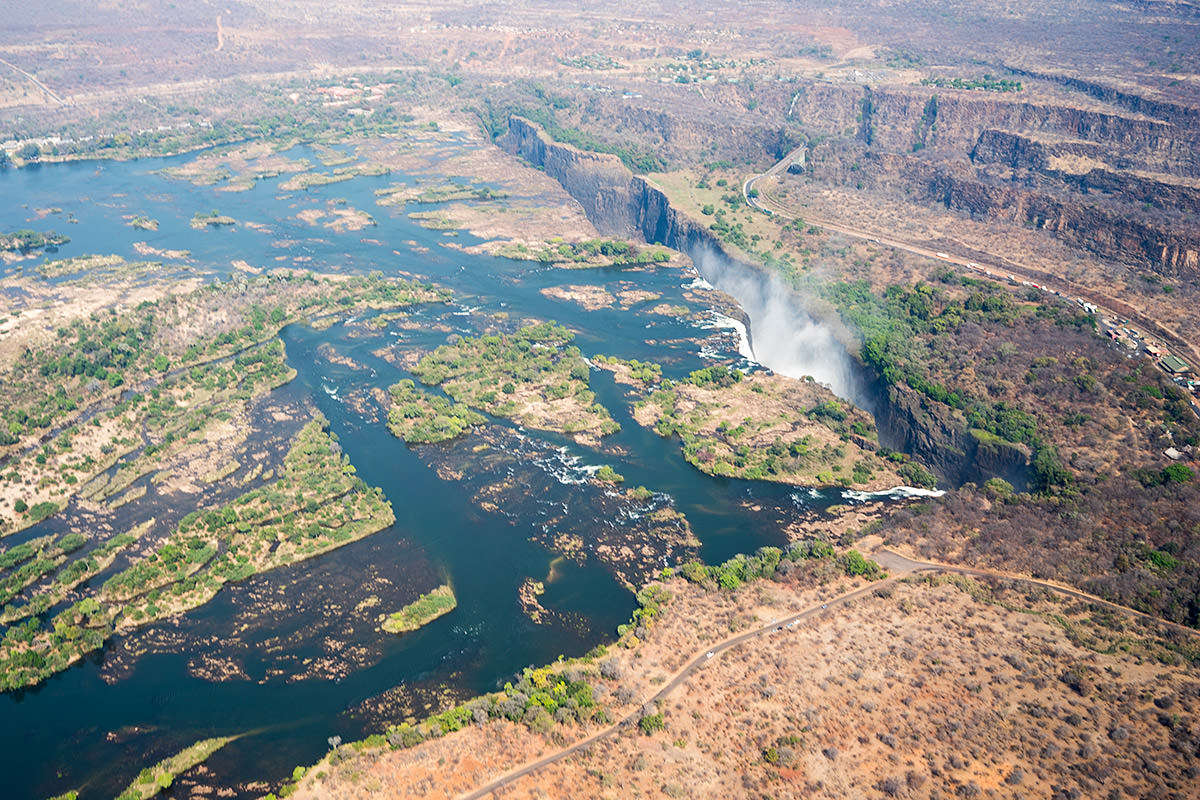
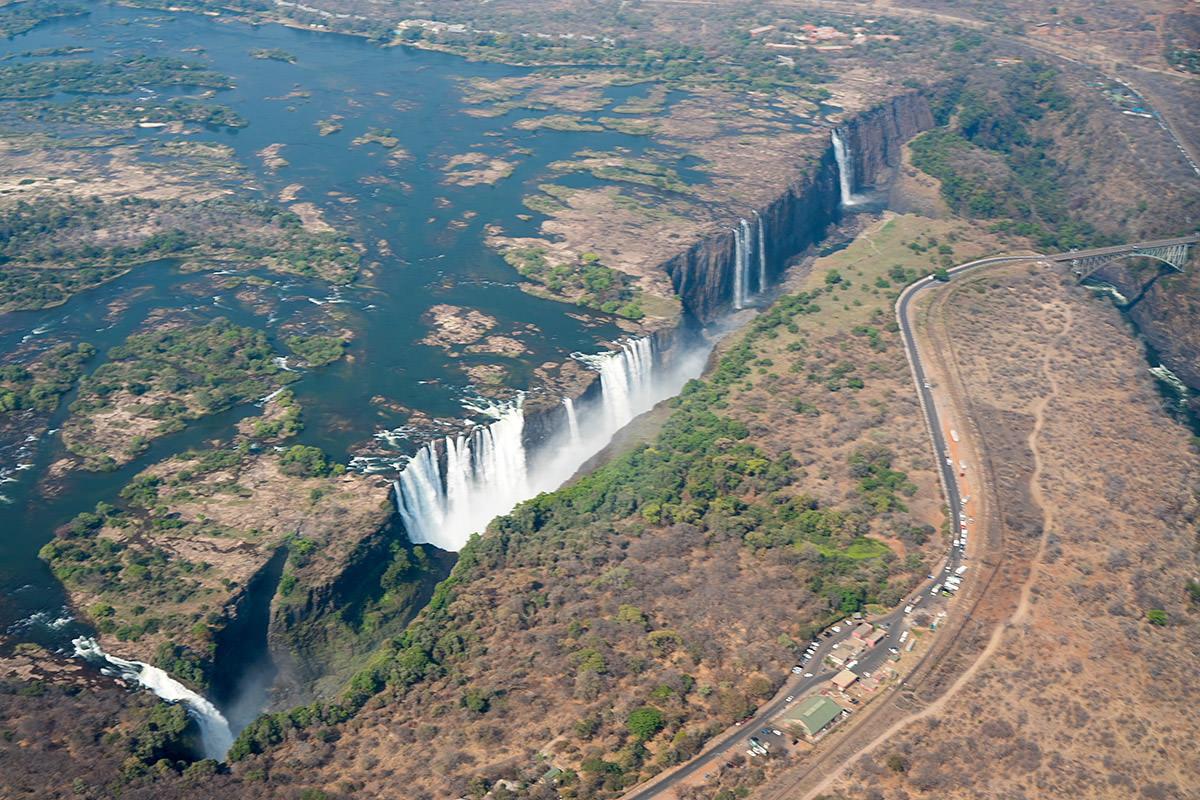

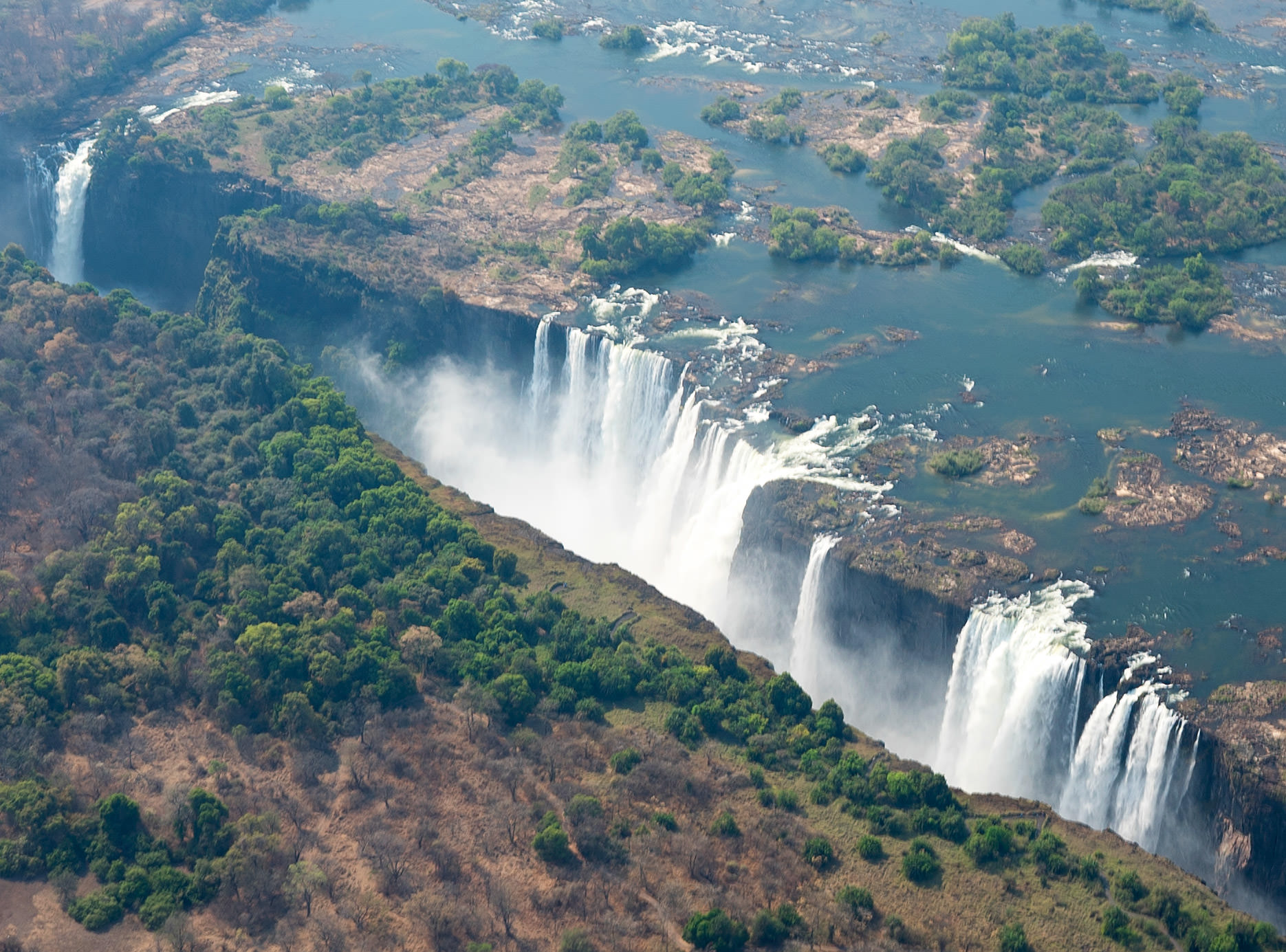
So... bucket list item accomplished? Not quite.
After visiting the falls, you have to go for high tea at the Victoria Falls Hotel...
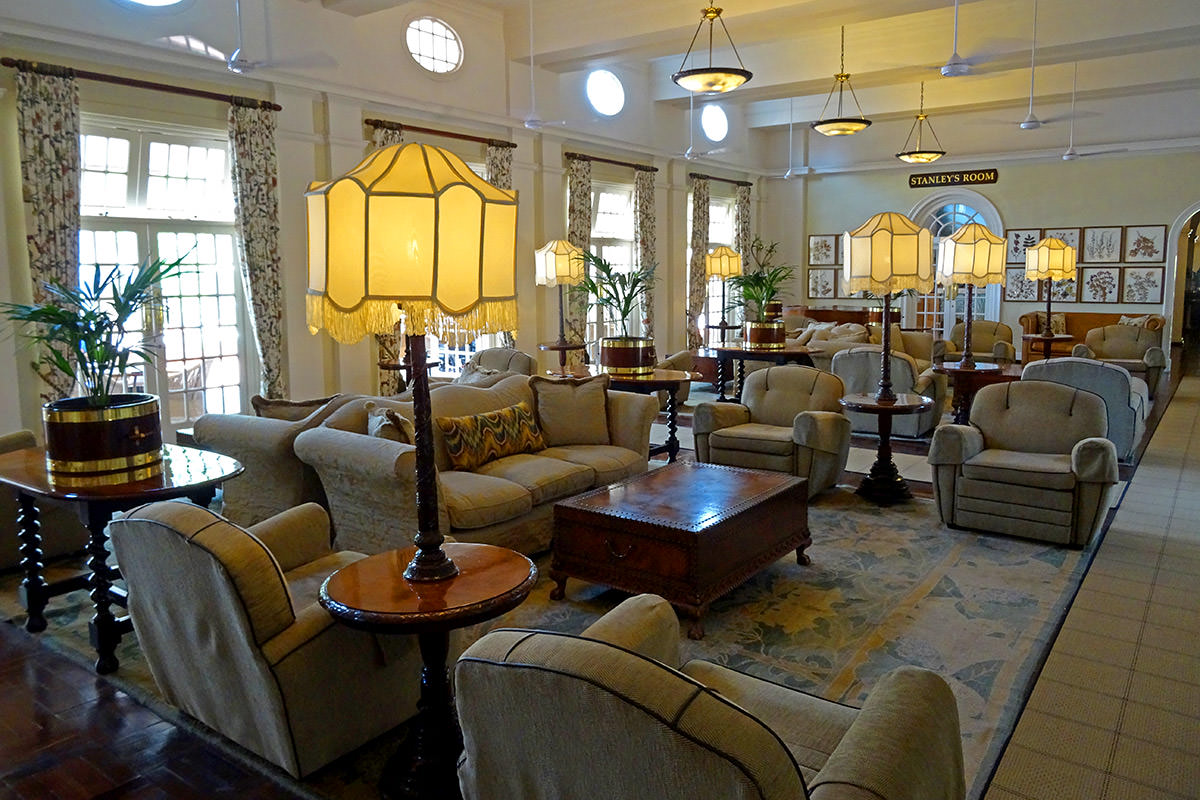
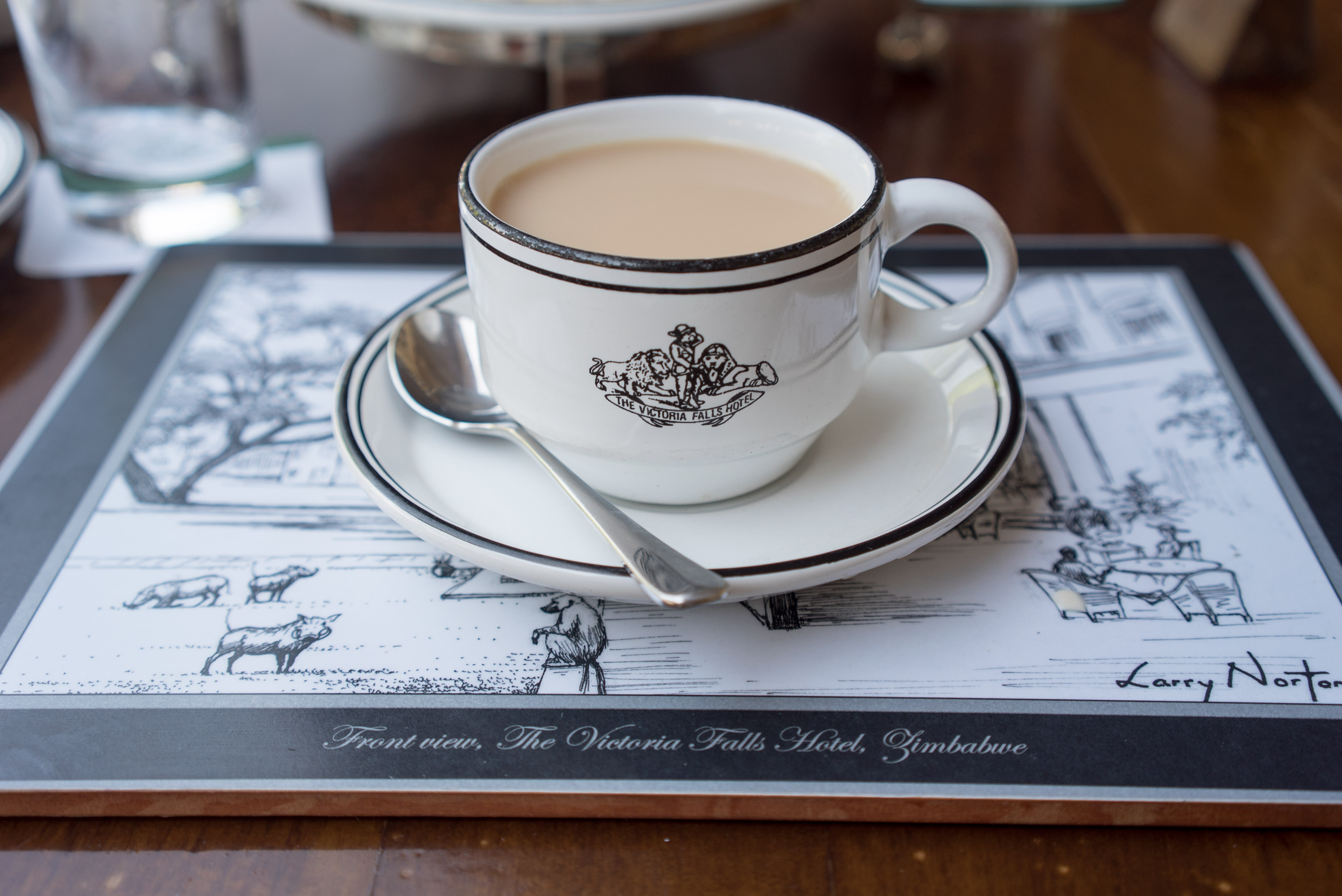
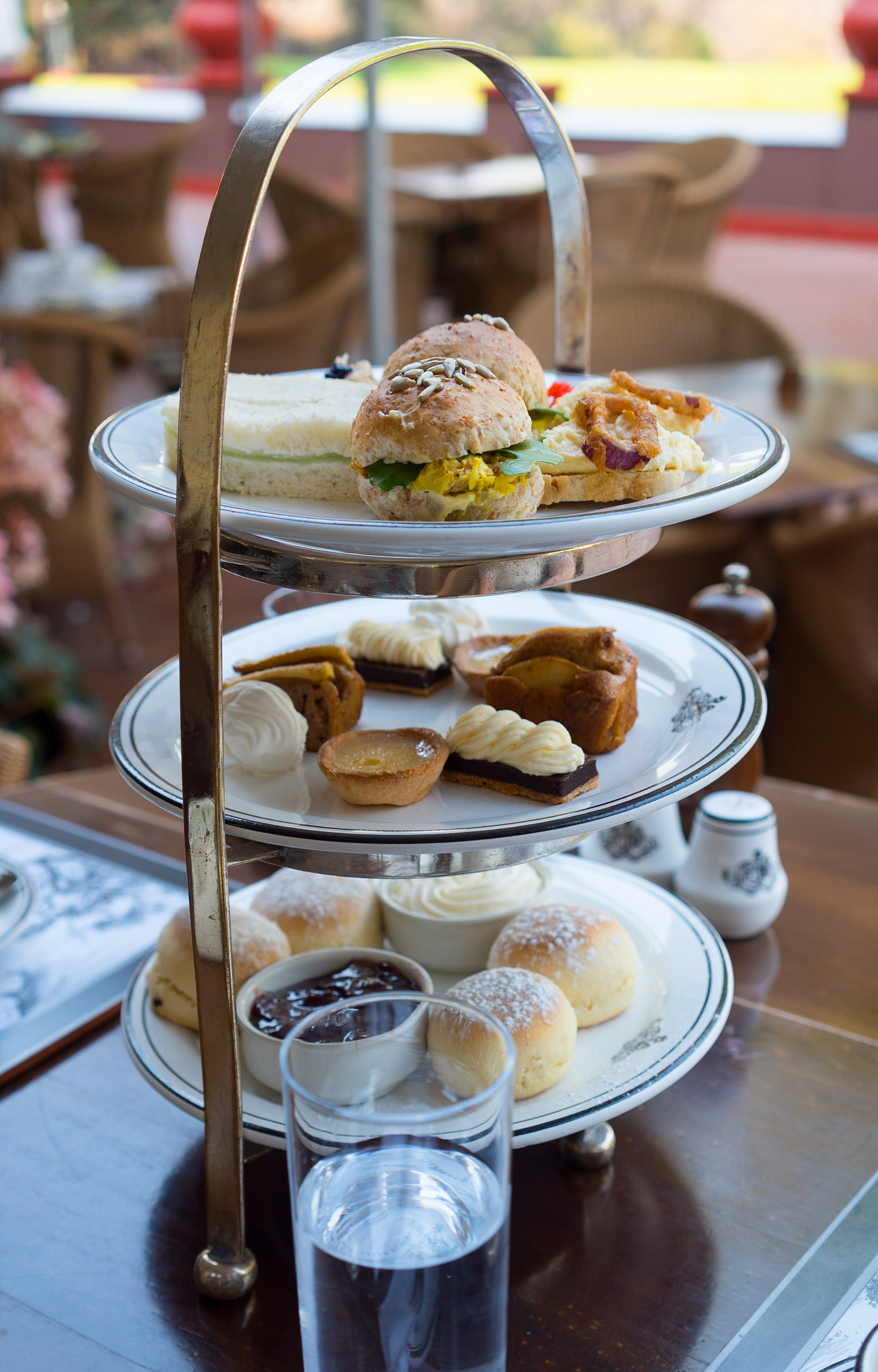
The price is $30 for up to four people, and the scones are among the best I have ever had... subtlely sweet and with just the right amount of crumble...

Except... ultimately I was disappointed with my experience. The service, which was so amazing yesterday at lunch, was severely lacking. The tea was dumped off at the table with absolutely no explanation or even so much as a hint as to what you're being served. At most places I've gone for high tea, they will happily tell you what you're drinking (usually it's a custom, exclusive tea blend from some exotic location or something).. and they'll also let you know how much longer you should wait for the tea to steep so you can enjoy it at its best. Today? Nothing. And then I had to wait for my sandwiches and sweets, which took FOREVER to arrive (maybe they bake them to order?) and my table was never checked on even once while I waited for my waiter to bring them. This was inexplicable because there were maybe four other tables occupied in the entire restaurant, and I think my waiter was only responsible for two of them. And speaking of my waiter, after he dumped off the food service, that's the last I ever saw of him... at least voluntarily. After waiting way, way too long for somebody to refill my water glass, I finally got up and went to the bar to see if they could help me. The hostess chased me down to find out why I was at the bar and, once I told her, asked me to please take a seat and she would have my waiter bring me more water. Which he did... five minutes later. Same thing for trying to pay the check. I finally begged the hostess to chase down my waiter again so I could pay and leave. I swear... no exaggeration... it took yet another ten minutes for him to show up. I have no frickin' clue what in the hell my waiter was doing today, but it sure wasn't waiting on my table. Sorry... but for THIRTY FRICKIN' DOLLARS FOR TEA at a FIVE STAR PROPERTY with the reputation of the VICTORIA FALLS HOTEL I expected better.
If the service was worth a shit, I'd say high tea at the Victoria Falls Hotel is a must-experience event when you're in town. As it is? Well, despite the terrific tea and a delicious snack tray I liked very much... you've been warned. Bring your patience.
After tea I was considering heading back to the falls for a dusk viewing. But the entrance fee I paid this morning is one-time only, and going back would mean another $30 admission fee so I skipped it. Instead I wandered through the hotel looking at the vast amount of history displayed on the walls, then went back to my room to pack.
And now I'm trying to deal with the trauma in knowing that my vacation is over...
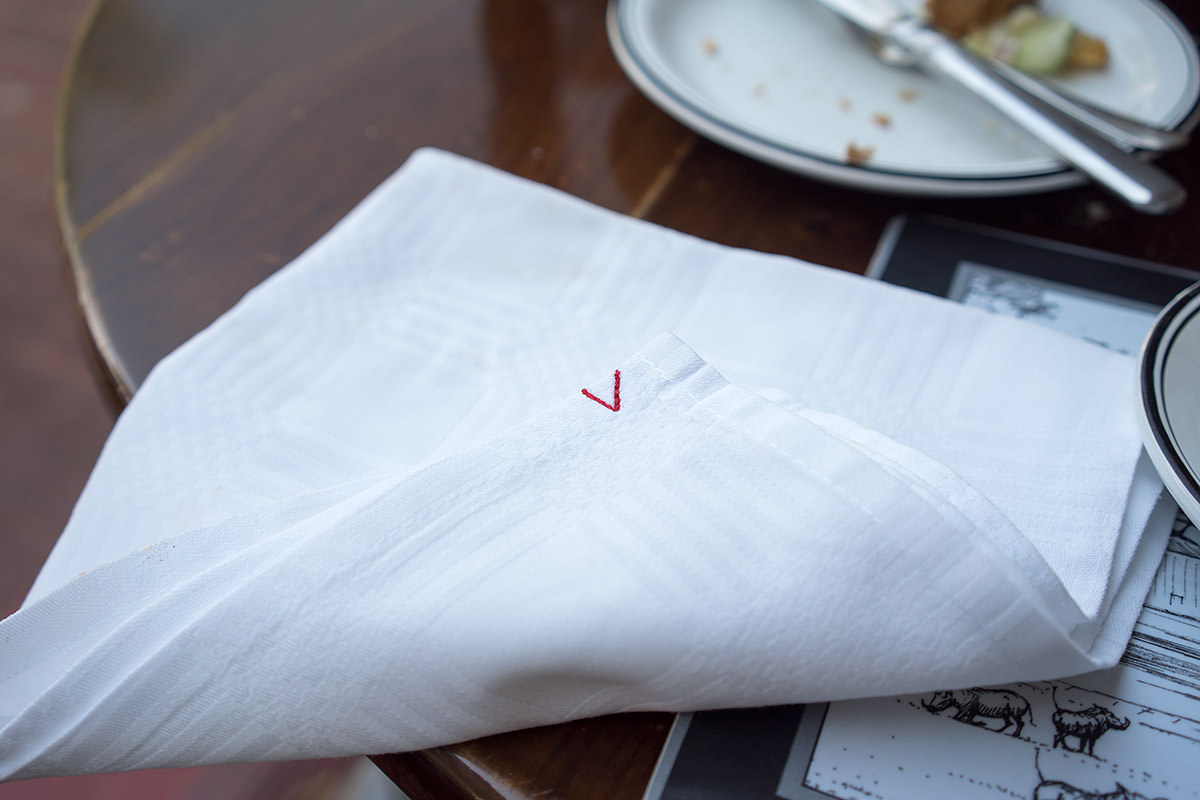
So far as vacations go, however, this was a great one.
